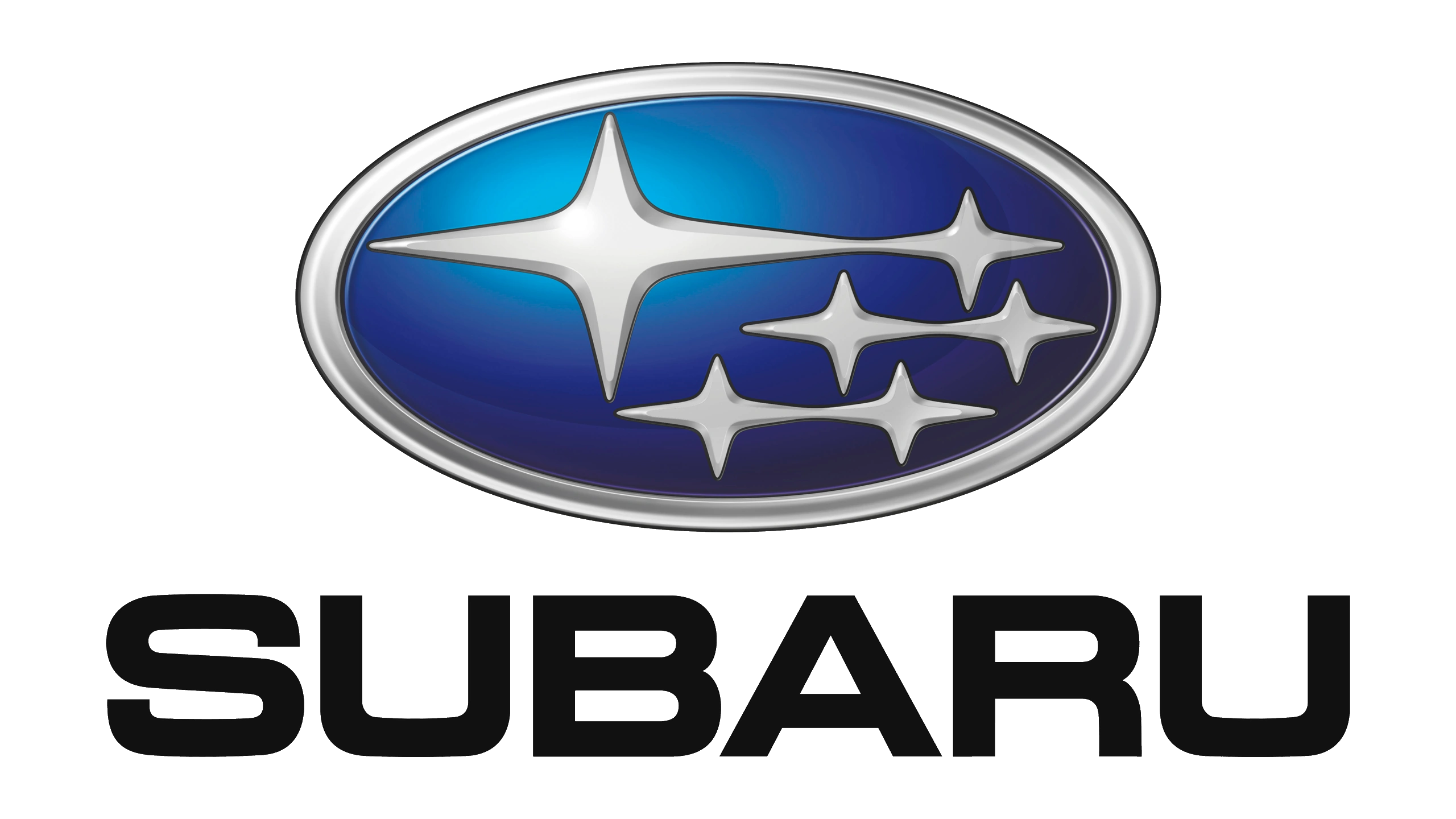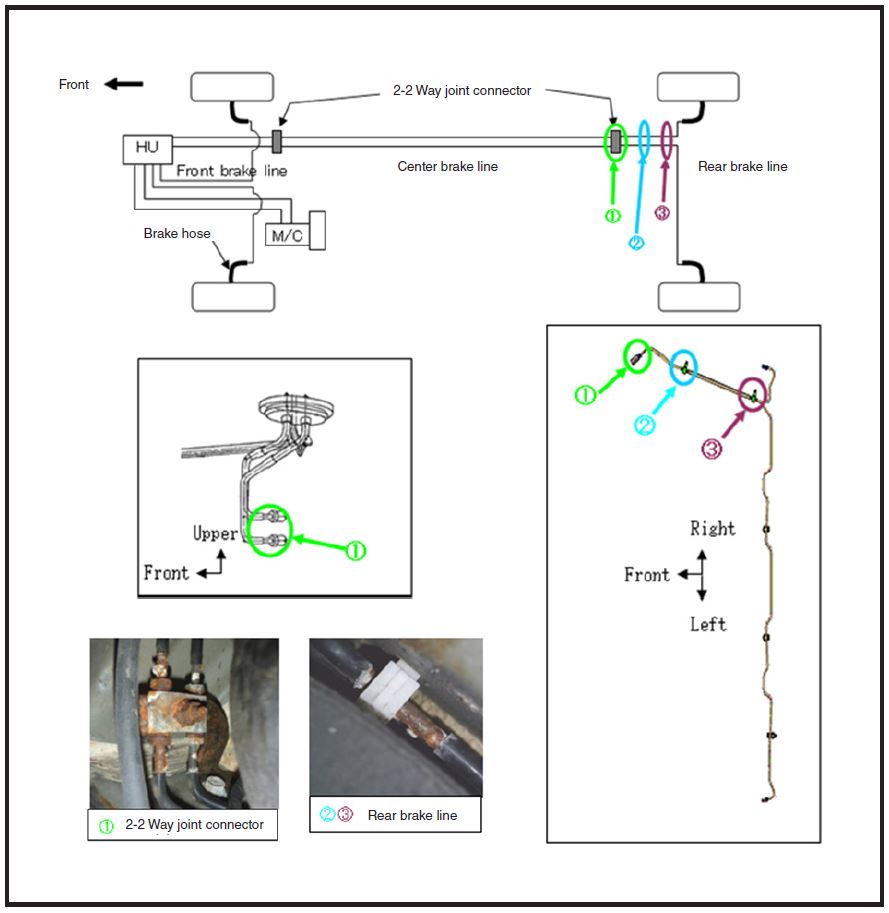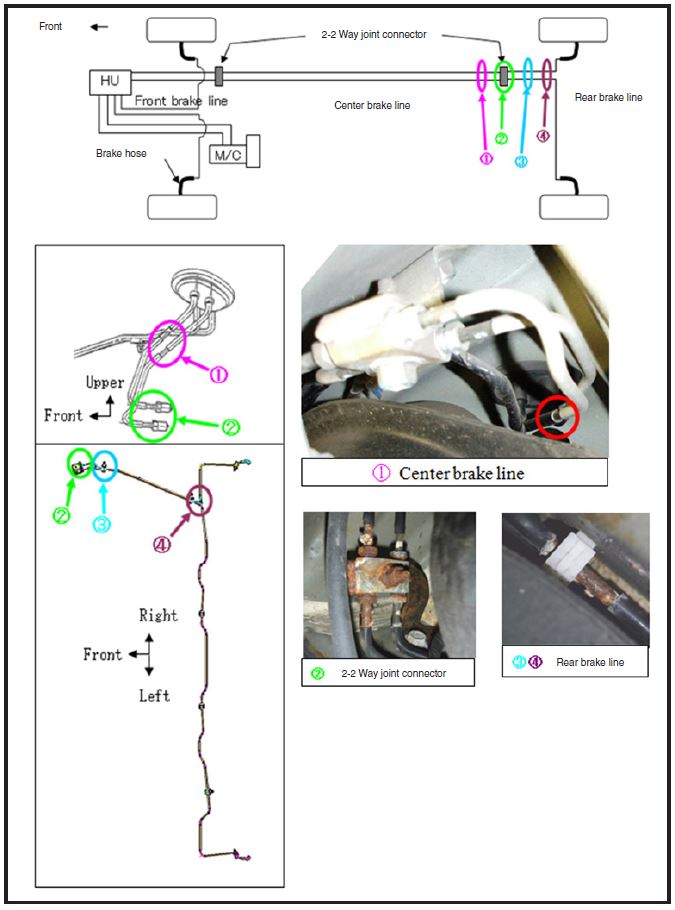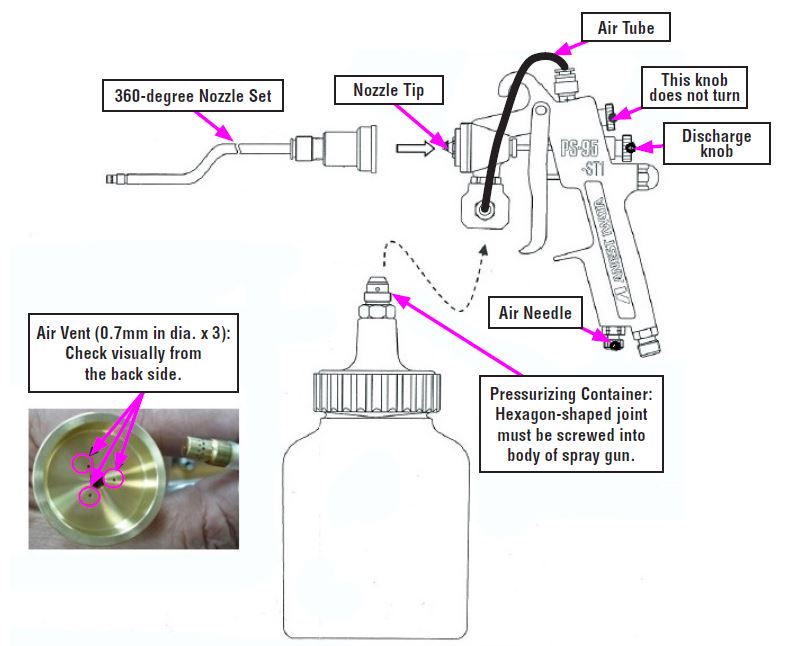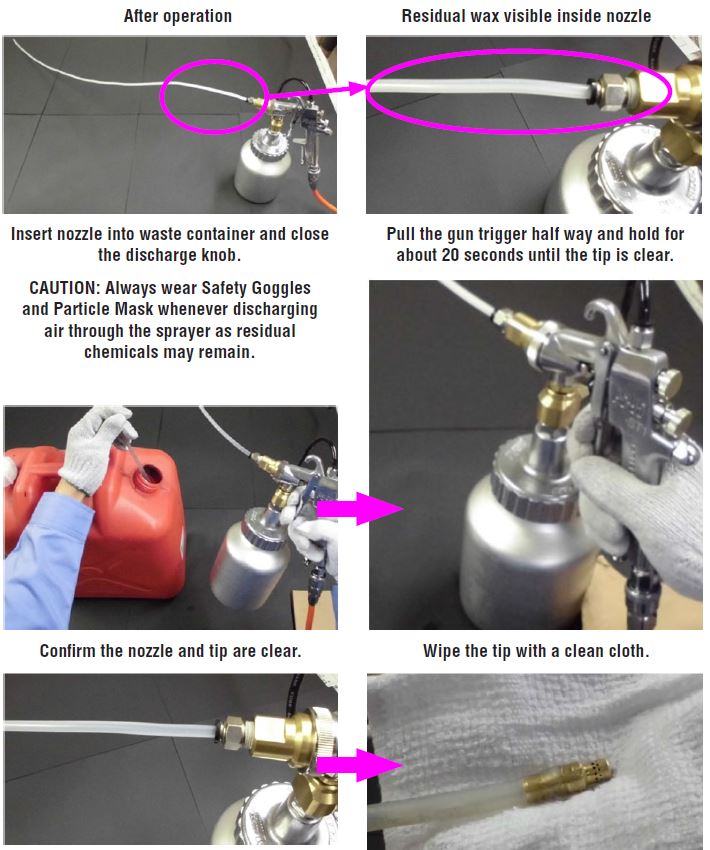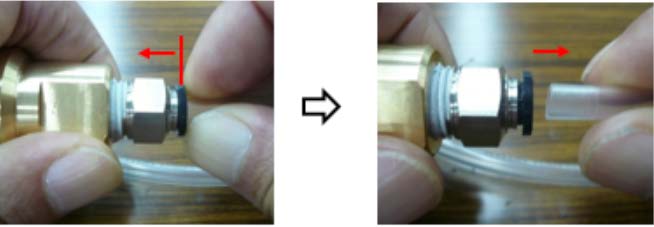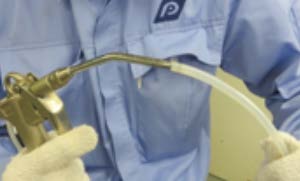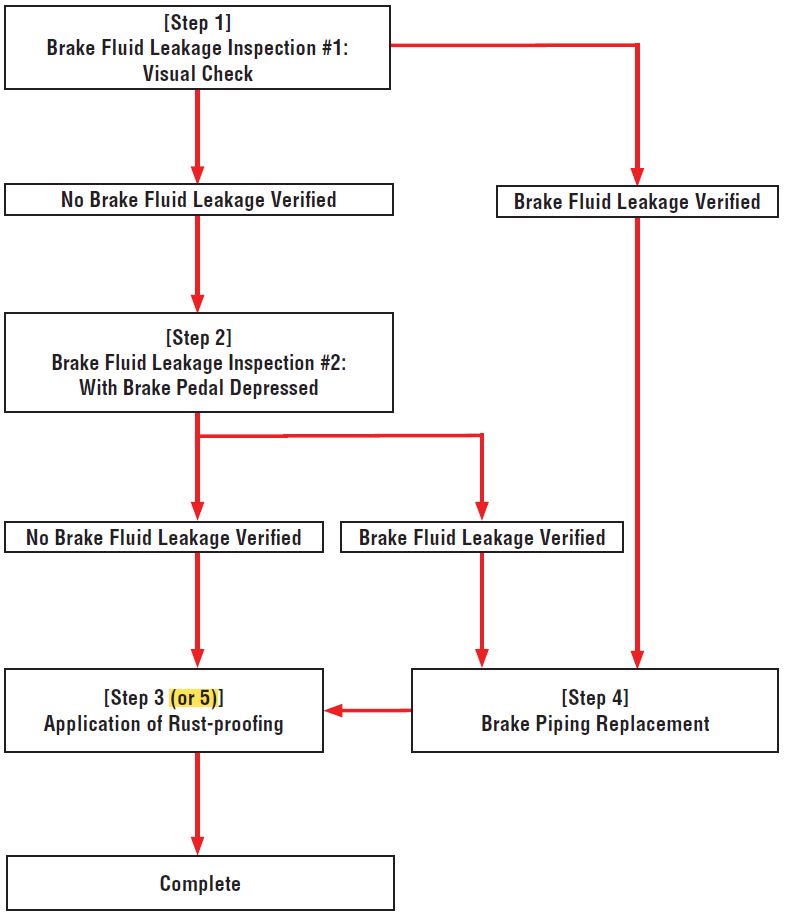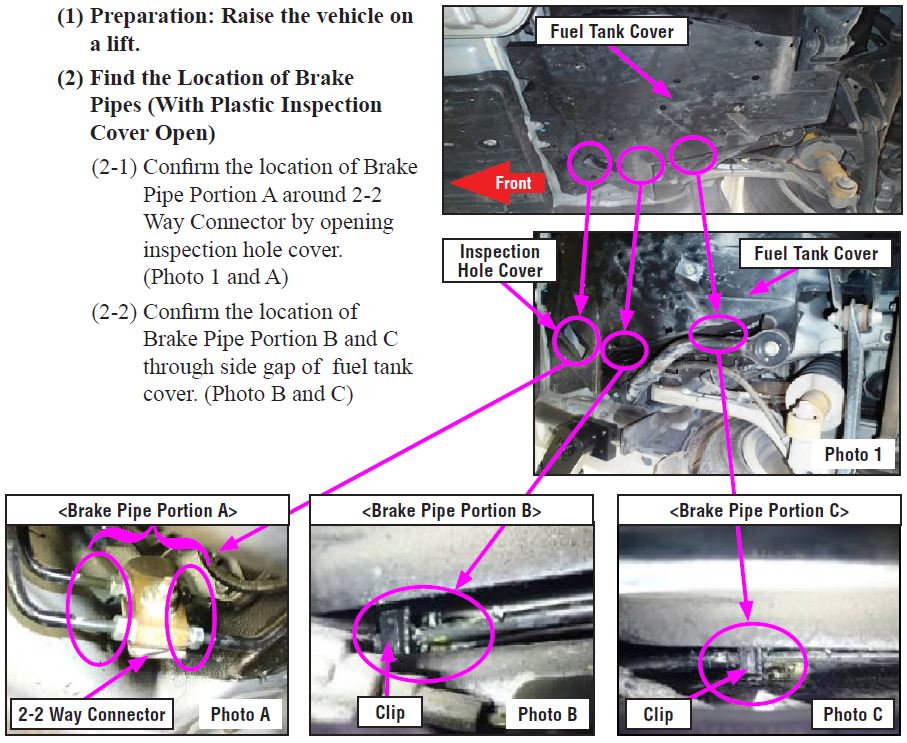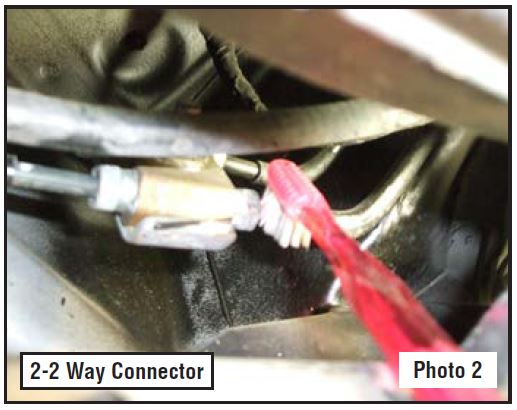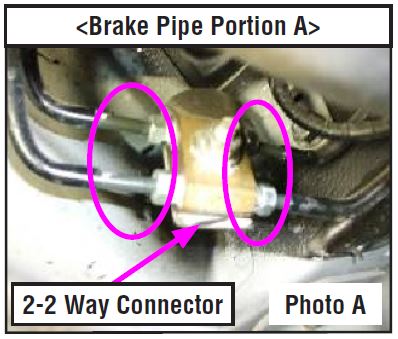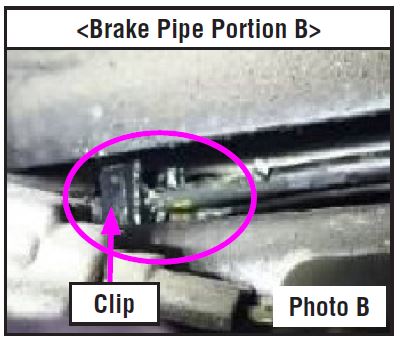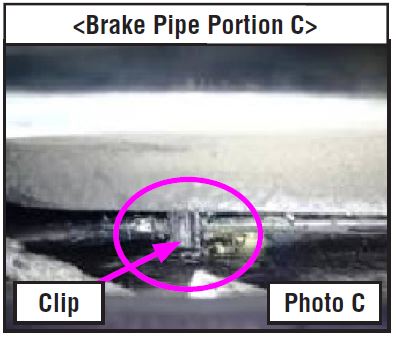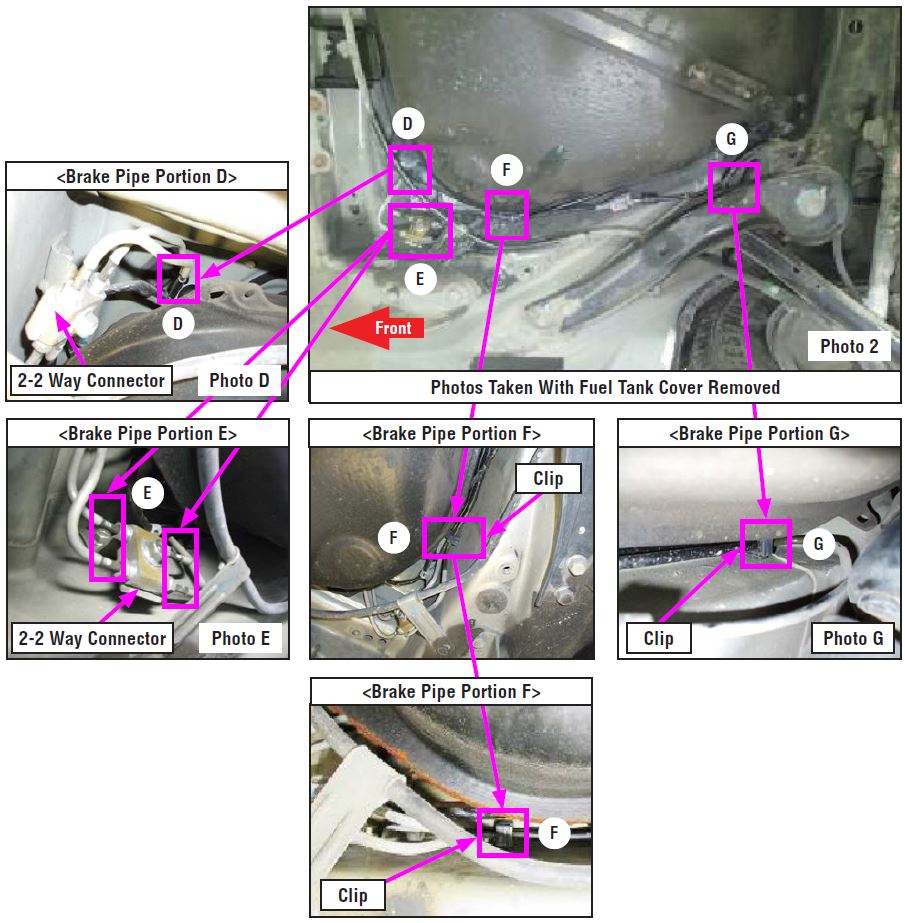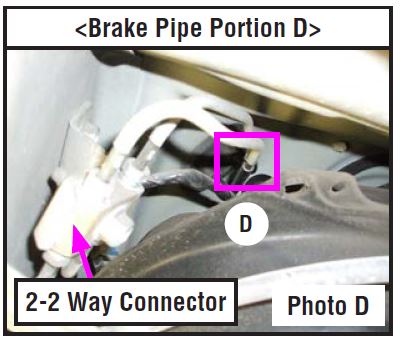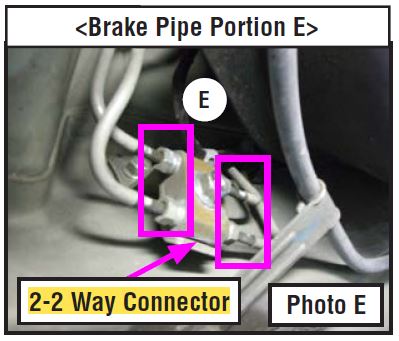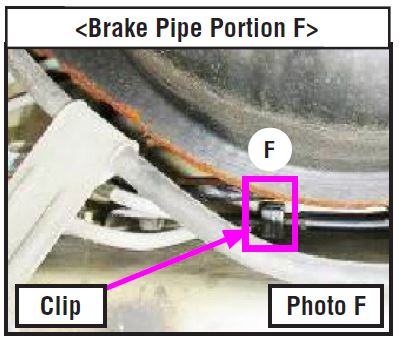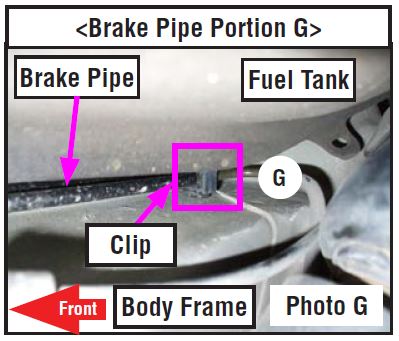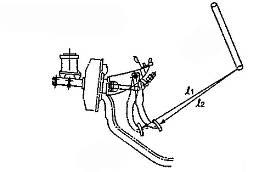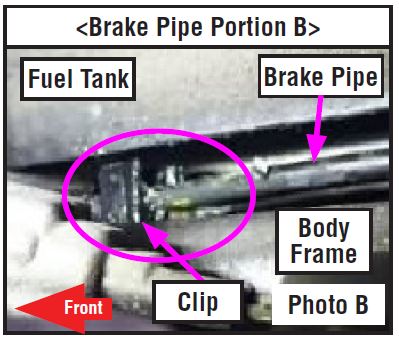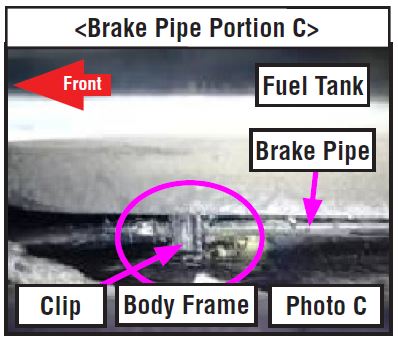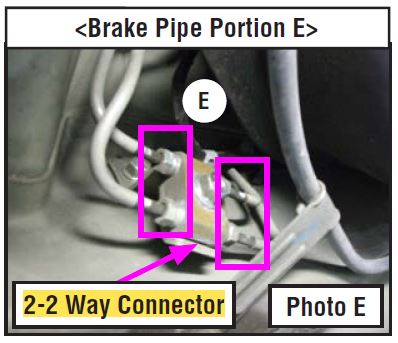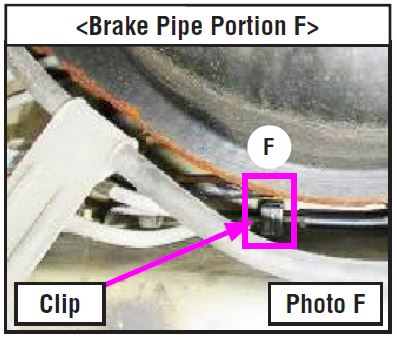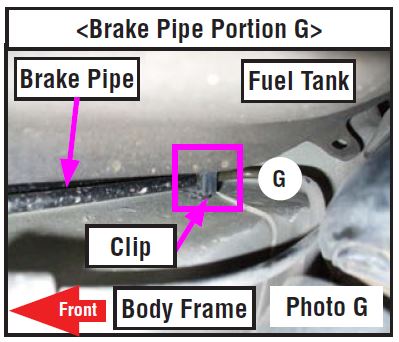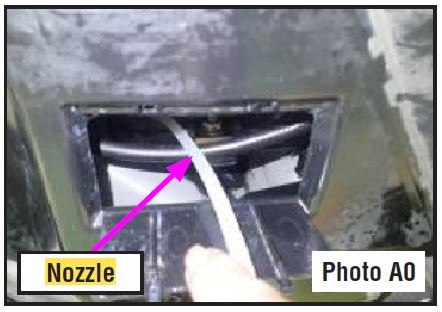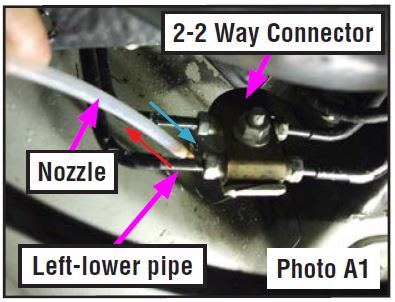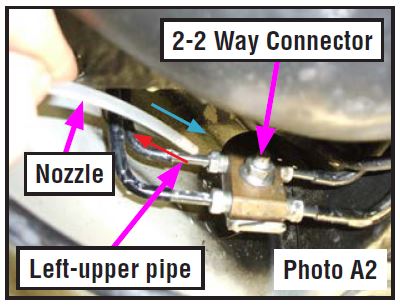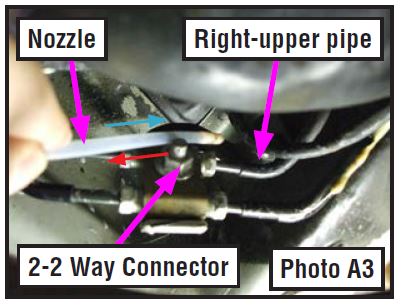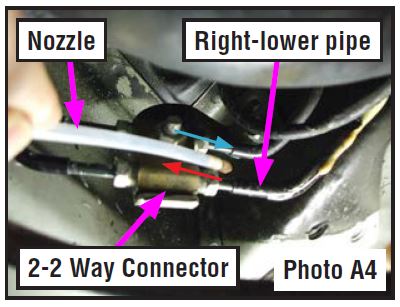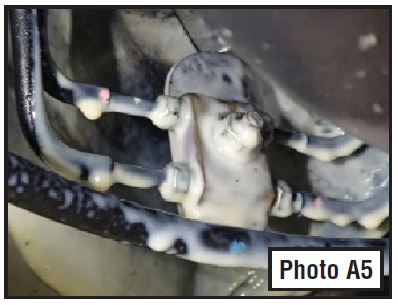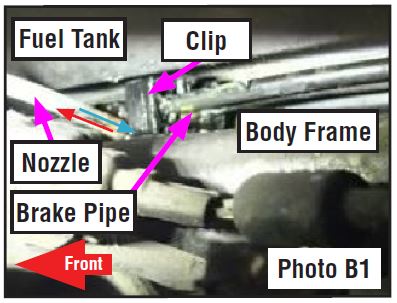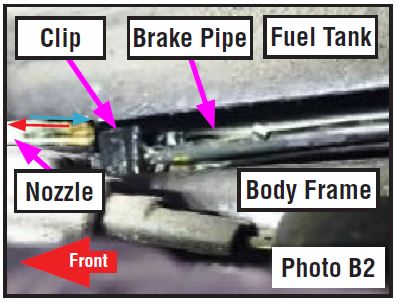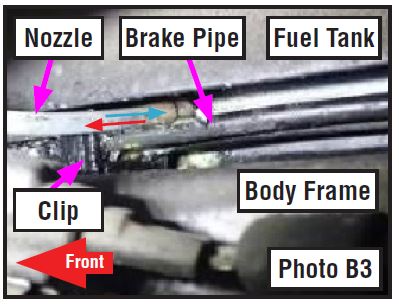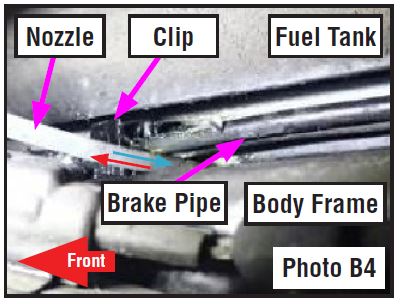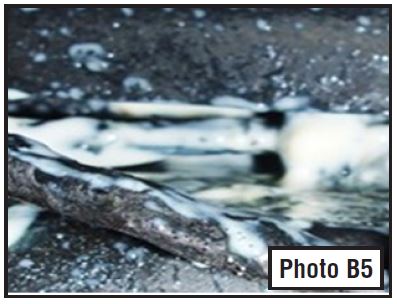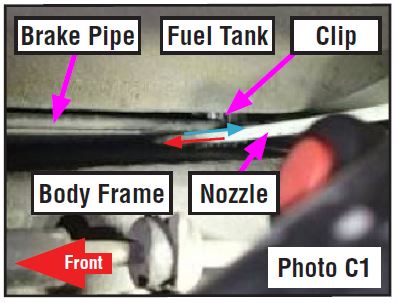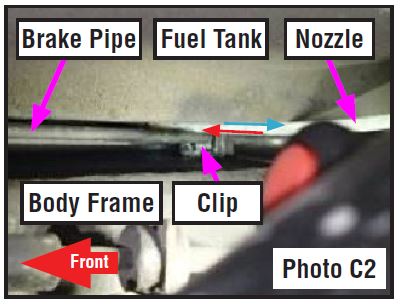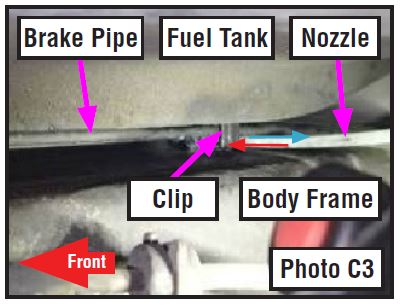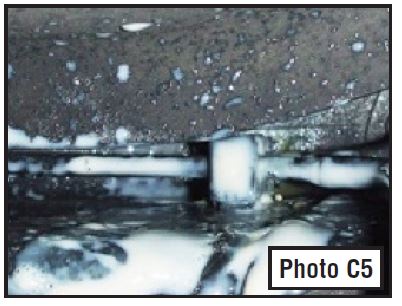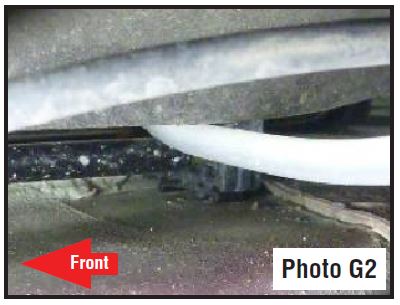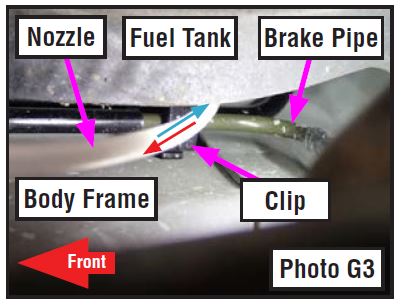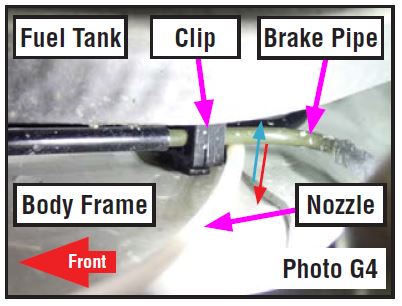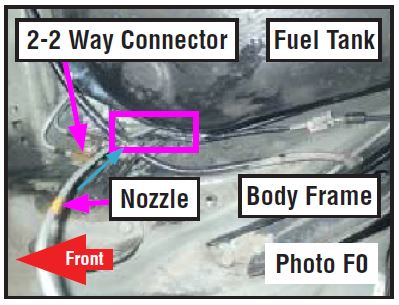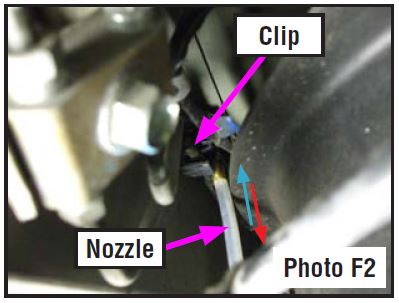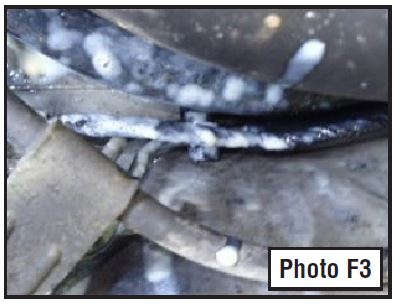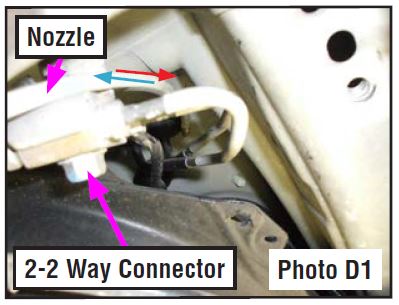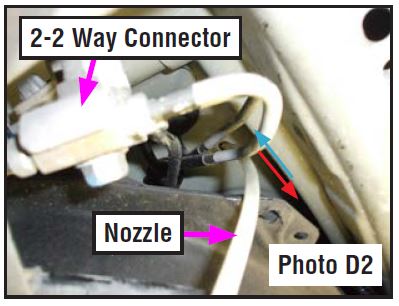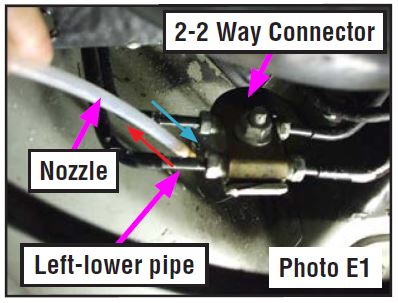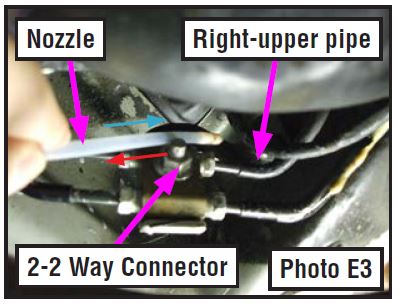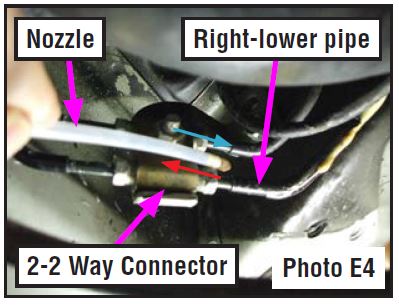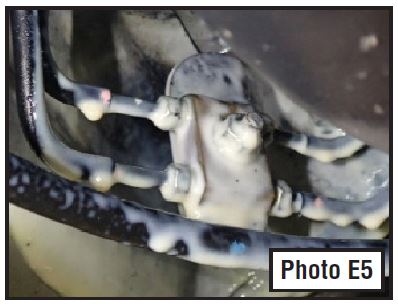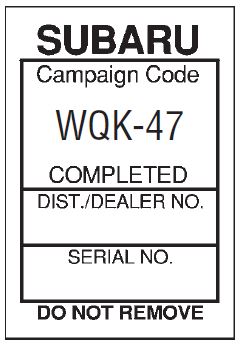| “This site contains affiliate links for which OEMDTC may be compensated” |
June 10, 2014 NHTSA CAMPAIGN NUMBER: 14V311000
Brake Lines may Fail due to Corrosion
Brake line corrosion may result in brake fluid leakage. Fluid leakage may result in longer distances being required to slow or stop the vehicle, increasing the risk of a crash.
NHTSA Campaign Number: 14V311
Manufacturer Subaru of America, Inc.
of America, Inc.
Components SERVICE BRAKES, HYDRAULIC
Potential Number of Units Affected 461,338
Summary
Subaru of America, Inc. (Subaru
of America, Inc. (Subaru ) is recalling certain model year 2005-2009 Outback and Legacy, 2008-2011 Impreza and 2008-2014 Impreza WRX
) is recalling certain model year 2005-2009 Outback and Legacy, 2008-2011 Impreza and 2008-2014 Impreza WRX /STI
/STI , and 2009-2013 Forester vehicles, currently, or formerly, registered in Connecticut, Delaware, Illinois, Indiana, Iowa, Maine, Maryland, Massachusetts, Michigan, Minnesota, Missouri, New Hampshire, New Jersey, New York, Ohio, Pennsylvania, Rhode Island, Vermont, West Virginia, Wisconsin and the District of Columbia. Salt water could splash on the brake lines through a gap in the fuel tank protector, resulting in excessive corrosion of the brake lines.
, and 2009-2013 Forester vehicles, currently, or formerly, registered in Connecticut, Delaware, Illinois, Indiana, Iowa, Maine, Maryland, Massachusetts, Michigan, Minnesota, Missouri, New Hampshire, New Jersey, New York, Ohio, Pennsylvania, Rhode Island, Vermont, West Virginia, Wisconsin and the District of Columbia. Salt water could splash on the brake lines through a gap in the fuel tank protector, resulting in excessive corrosion of the brake lines.
Note that affected vehicles not currently, or formerly registered, in the salt belt states identified above are eligible for repair, at no cost to the customer, upon request.
Remedy
Subaru will notify owners, and dealers will test the brake system by depressing the brake pedal and inspecting for brake fluid leaks. If no brake fluid seepage is observed, the affected areas will be rustproofed with anti-corrosion wax. If brake fluid seepage is observed, the brake lines will be replaced followed by rustproofing with anti-corrosion wax. These services will be performed free of charge. The recall began July 2014 and second notifications will run through November 2014. Owners may contact Subaru
will notify owners, and dealers will test the brake system by depressing the brake pedal and inspecting for brake fluid leaks. If no brake fluid seepage is observed, the affected areas will be rustproofed with anti-corrosion wax. If brake fluid seepage is observed, the brake lines will be replaced followed by rustproofing with anti-corrosion wax. These services will be performed free of charge. The recall began July 2014 and second notifications will run through November 2014. Owners may contact Subaru at 1-800-782-2783. Subaru
at 1-800-782-2783. Subaru ’s recall campaign number is WQK-47. Note: This recall supersedes recall 13V-110 which applied to certain 2005-2009 Legacy/Outback vehicles. Vehicles that were remedied under the previous campaign still need additional areas rust-proofed.
’s recall campaign number is WQK-47. Note: This recall supersedes recall 13V-110 which applied to certain 2005-2009 Legacy/Outback vehicles. Vehicles that were remedied under the previous campaign still need additional areas rust-proofed.
Notes
Owners may also contact the National Highway Traffic Safety Administration Vehicle Safety Hotline at 1-888-327-4236 (TTY 1-800-424-9153), or go to www.safercar.gov.
Check if your Subaru has a Recall
NUMBER: WQK-47R
DATE: July 2014
REVISED: November 6, 2017
NHTSA ID: 14V-311
| APPLICABILITY: | 2005-2009 Subaru Legacy and Outback Legacy and Outback |
2009-2013 Subaru Forester Forester | |
2008-2011 Subaru Impreza, WRX Impreza, WRX , and STI , and STI | |
2012-2014 Subaru WRX WRX and STI and STI | |
| SUBJECT: | Brake Line Corrosion |
Subaru of America, Inc. (SOA) has determined that a defect, which relates to motor vehicle safety, exists on certain 2005-2009 model year Subaru
of America, Inc. (SOA) has determined that a defect, which relates to motor vehicle safety, exists on certain 2005-2009 model year Subaru Legacy and Outback vehicles, 2009-2013 Subaru
Legacy and Outback vehicles, 2009-2013 Subaru Forester vehicles, 2008-2011 Subaru
Forester vehicles, 2008-2011 Subaru Impreza, WRX
Impreza, WRX , and STI
, and STI vehicles, and 2012-2014 Subaru
vehicles, and 2012-2014 Subaru WRX
WRX and STI
and STI vehicles currently or formerly registered in at least one of the “salt-belt” states listed below or in the District of Columbia.
vehicles currently or formerly registered in at least one of the “salt-belt” states listed below or in the District of Columbia.
| Connecticut | Maine | New Hampshire | Vermont |
| Delaware | Maryland | New Jersey | West Virginia |
| District of Columbia | Massachusetts | New York | Wisconsin |
| Illinois | Michigan | Ohio | |
| Indiana | Minnesota | Pennsylvania | |
| Iowa | Missouri | Rhode Island |
These vehicles may have been manufactured with brake lines that could, over time, corrode in the area of the four-way joint connector or in the areas where there are no resin covers installed if exposed to salt, such as salt used to treat roads in the winter time. Excessive corrosion could eventually cause perforation of a brake line(s) resulting in a brake fluid leak.
Should a brake line corrode to the point of developing a perforation, brake fluid will leak from the line(s) causing the related circuit to eventually lose effectiveness. In this situation, there would be an increase in the amount of brake pedal travel distance and foot pressure required to slow or stop the vehicle.
This might cause the driver to misjudge the amount of brake pedal travel required to achieve the desired stopping distance, increasing the risk of a crash. This recall will involve cleaning, inspecting and testing the brake lines for perforation. If no leaks are found, as a preventative measure it will be necessary to apply an anti-corrosion material to the areas of concern. If any of the brake lines are found to be leaking, all four brake lines on the vehicle will require replacement.
AFFECTED VEHICLES
The affected vehicles include certain: 2005-2009 model year Subaru Legacy and Outback vehicles; 2009-2013 Subaru
Legacy and Outback vehicles; 2009-2013 Subaru Forester vehicles; 2008-2011 Subaru
Forester vehicles; 2008-2011 Subaru Impreza, WRX
Impreza, WRX , and STI
, and STI vehicles; and 2012-2014 Subaru
vehicles; and 2012-2014 Subaru WRX
WRX and STI
and STI vehicles currently or formerly registered in at least one of the “salt-belt” states or the District of Columbia.
vehicles currently or formerly registered in at least one of the “salt-belt” states or the District of Columbia.
Affected vehicles are identified in the VIN range charts below. NOTE: Not all vehicles within the VIN ranges are affected. Coverage for all affected vehicles must be confirmed by using the Vehicle Coverage Inquiry function on subarunet.com.
| MODEL | MY | CARLINE(S) | START VIN (last 8 digits) | END VIN (last 8 digits) |
|---|---|---|---|---|
| Legacy & Outback | 2005 | Legacy & Outback | 5*200001 | 5*393924 |
| 2006 | Legacy & Outback | 6*200001 | 6*364201 | |
| 2007 | Legacy & Outback | 7*200001 | 7*346352 | |
| 2008 | Legacy & Outback | 8*200001 | 8*367431 | |
| 2009 | Legacy & Outback | 9*200001 | 9*348625 | |
| Forester | 2009 | Forester | 9*700001 | 9*797855 |
| 2010 | Forester | A*700001 | A*918317 | |
| 2011 | Forester | B*700001 | B*783898 | |
| 2012 | Forester | C*400001 | C*470750 | |
| 2013 | Forester | D*400001 | D*446782 | |
| Impreza | 2008 | 4 -Door (except STI ) ) | 8*500001 | 8*530288 |
| 2008 | 5 -Door (except STI ) ) | 8*800001 | 8*838495 | |
| 2008 | 5 -Door (STI ) ) | 8L809673 | 8L837138 | |
| 2009 | 4 -Door (except STI ) ) | 9*500001 | 9*522884 | |
| 2009 | 5 -Door (except STI ) ) | 9*800001 | 9*828092 | |
| 2009 | 5 -Door (STI ) ) | 9L800020 | 9L828023 | |
| 2010 | 4 -Door (except STI ) ) | A*500001 | A*517646 | |
| 2010 | 5 -Door (except STI ) ) | A*800001 | A*828797 | |
| 2010 | 5 -Door (STI ) ) | AL800010 | AL826680 | |
| 2011 | 4 -Door (except WRX and STI and STI ) ) | B*500001 | B*523841 | |
| 2011 | 5 -Door (except WRX and STI and STI ) ) | B*800001 | B*832332 | |
| 2011 | 4 -Door (WRX and STI and STI ) ) | B*500742 | B*525817 | |
| 2011 | 5 -Door (WRX and STI and STI ) ) | B*801433 | B*833719 | |
| 2012 | 4 -Door (WRX and STI and STI ) ) | C*002099 | C*031281 | |
| 2012 | 5 -Door (WRX and STI and STI ) ) | C*200094 | C*246471 | |
| 2013 | 4 -Door (WRX and STI and STI ) ) | D*002007 | D*035278 | |
| 2013 | 5 -Door (WRX and STI and STI ) ) | D*200100 | D*895579 | |
| 2014 | 4 -Door (WRX and STI and STI ) ) | E*002001 | E*016827 | |
| 2014 | 5 -Door (WRX and STI and STI ) ) | E*200001 | E*270263 |
THIS RECALL REPLACES AND UPDATES ANY PREVIOUS ‘WQG-43’ BRAKE LINE CORROSION RECALL-RELATED REPAIRS PERFORMED
This recall replaces and updates SOA’s previous WQG-43 brake line corrosion recall applicable to some 2005-2009 Legacy and Outback models, issued in May of 2013.
In addition to the repair procedure of the previous WQG-43 recall, this recall includes inspection and treatment of other areas of the brake lines.
As a result, any incomplete WQG-43 recall applicability will be expired in SOA’s system at the time WQK-47 affected vehicle data is loaded. Coverage for all affected vehicles must be confirmed by using the Vehicle Coverage Inquiry function on subarunet.com.
IMPORTANT NOTE: If the WQG-43 brake line corrosion recall repair was already performed, the WQK-47 recall repair must also be performed to ensure that all affected areas of the brake lines are acceptable and treated with anti-corrosion material as a preventative measure.
OWNER NOTIFICATION
Notification letters will be sent to owners of vehicles that are currently or were previously registered in at least one of the “salt-belt” states or the District of Columbia. Owner notification will begin on July 21, 2014.
To ensure sufficient supply of materials and parts, and to accommodate appointment scheduling at the retailer level, a phased mailing schedule will be implemented as follows:
- Owners of affected 2005-2009 Legacy and Outback vehicles will be notified to schedule an appointment with their Subaru
 retailer to have this repair performed.
retailer to have this repair performed. - Owners of affected Forester, Impreza, WRX
 , and STI
, and STI vehicles will be notified that their vehicle is affected by this recall and when sufficient materials and parts are available, they will be notified again.
vehicles will be notified that their vehicle is affected by this recall and when sufficient materials and parts are available, they will be notified again. - As sufficient materials and parts become available, owners of affected Forester, Impreza, WRX
 , and STI
, and STI vehicles will be notified to schedule an appointment with their Subaru
vehicles will be notified to schedule an appointment with their Subaru retailer to have this repair performed. This second notification process will be based on vehicle age and affected vehicle volumes.
retailer to have this repair performed. This second notification process will be based on vehicle age and affected vehicle volumes.
Copies of the Owner Notification Letters are included at the end of this bulletin.
OWNERS LOCATED OUTSIDE THE AFFECTED “SALT-BELT” STATES
Notification letters will only be mailed to owners of vehicles that are currently registered or were previously registered in at least one of the “salt-belt” states or the District of Columbia.
However, there are circumstances under which vehicles that were not previously or ever registered in a “salt-belt” state will be covered by this recall campaign. These circumstances may include:
1. Vehicles not currently or previously registered in a “salt-belt” state that have relocated into a “salt-belt” area and/or vehicles registered in a “non-salt belt” state, and driven in a “salt-belt” area: We request that retailers located in “salt-belt” states check all vehicles within the affected VIN range for recall coverage. If it is determined the owner of a vehicle within the affected VIN range relocates or uses his or her vehicle in a “salt-belt” area, the retailer should perform the recall procedure.
2. Vehicles in “non-salt belt” states that have experienced the defect: In the unlikely event an owner in a “non-salt belt” state experiences the defect or otherwise requests the procedure be performed on their vehicle, the retailer should perform the recall procedure. This applies to both “salt-belt” and “non-salt belt” state retailers.
Under such circumstances, the Subaru retailer should perform the recall procedure at no cost to the customer. For claim submission, please contact the Warranty Helpdesk at (1-866-SUBARU2) 1-866-782-2782 to have the VIN added to the recall.
retailer should perform the recall procedure at no cost to the customer. For claim submission, please contact the Warranty Helpdesk at (1-866-SUBARU2) 1-866-782-2782 to have the VIN added to the recall.
RETAILER AFFECTED VIN LISTS
Each Subaru retailer will receive an affected VIN list from their Zone office around the time initial owner notification begins. Vehicles will be assigned to retailers in the affected VIN list as follows:
retailer will receive an affected VIN list from their Zone office around the time initial owner notification begins. Vehicles will be assigned to retailers in the affected VIN list as follows:
- Original vehicle owners are assigned to the original selling retailer when their current address is within a 100 mile radius of that retailer.
- If the original selling retailer is inactive, the VIN will be assigned to the nearest active retailer.
- For any new owners or when original owners live more than 100 miles from the original selling retailer, the VIN will be assigned to the nearest active retailer.
Important: Retailer affected VIN lists include owner name and address information for vehicles affected by this recall. This information will enable retailers to follow-up with owners of potentially affected vehicles. The lists contain owners’ names and addresses obtained from State Motor Vehicle Registration Records. The use of such motor vehicle registration data for any other purpose is unlawful. Accordingly, retailers are urged to limit the use of these lists to the purpose of completion of this safety recall.
SUBARU RETAILER PROGRAM RESPONSIBILITY
RETAILER PROGRAM RESPONSIBILITY
Subaru retailers are to promptly perform the applicable service procedures defined in this bulletin to correct all affected vehicles in their inventory (new, used, demo & SSLP).
retailers are to promptly perform the applicable service procedures defined in this bulletin to correct all affected vehicles in their inventory (new, used, demo & SSLP).
Additionally, whenever a vehicle subject to this recall is taken into the retailer’s new or used inventory or into the retailer for service, necessary steps should be taken to ensure the recall correction has been made before selling or releasing the vehicle.
New, used, demo or SSLP (Subaru Service Loaner Program) vehicles listed in a recall/campaign that are in the retailer’s stock must be:
Service Loaner Program) vehicles listed in a recall/campaign that are in the retailer’s stock must be:
- Immediately identified
- Tagged or otherwise marked to prevent their delivery or use prior to inspection and/or repair
- Repaired in accordance with the repair procedures outlined in this Product Campaign Bulletin.
Please be advised that it is a violation of Federal law for a retailer to deliver a new motor vehicle covered by a recall under a sale or lease until the defect is remedied. Therefore, any authorized Subaru retailer failing to perform the applicable service procedures as defined in this bulletin to correct all affected vehicles in their inventory (new, used, demo & SSLP) prior to the vehicle being placed in service may be subject to civil penalties of up to $7,000 per violation (e.g., for each vehicle), as provided in 49 CFR §578.6 and will also be in breach of the Subaru
retailer failing to perform the applicable service procedures as defined in this bulletin to correct all affected vehicles in their inventory (new, used, demo & SSLP) prior to the vehicle being placed in service may be subject to civil penalties of up to $7,000 per violation (e.g., for each vehicle), as provided in 49 CFR §578.6 and will also be in breach of the Subaru Dealer Agreement.
Dealer Agreement.
SPECIAL TOOLS INFORMATION
During the week of July 21, 2014, all retailers will receive one spray gun and one nozzle at no charge to perform this recall. Additional spray guns and nozzles will be available on a limited basis, therefore they will be on hold in the SOA Parts system. Please contact the Parts Information Coordinators at (1-866-SUBARU2) 1-866-782-2782 for additional information.
| PART NUMBER | DESCRIPTION |
|---|---|
| SOA635134 | WQK-47 Spray Gun (does not include nozzle) |
| SOA635135 | WQK-47 Nozzle |
PARTS INFORMATION
The parts required for this recall are:
- Nox-Rust 712AM rust-proofing material (for all affected vehicles)
- Self-locking nut kit (for all affected vehicles except Legacy and Outback).
Nox-Rust 712AM Rust-proofing Material:
Exposure Controls for use of Nox-Rust 712AM: The Material Safety Data Sheet (MSDS) which provides storage and handling procedures for this product is included at the end of this bulletin.
The WQK-47 rust-proofing material comes in one liter bottles, packed in a case of 10 bottles. Each one liter bottle contains enough material to treat 9 vehicles.
During the week of July 21, 2014, retailers located in the “salt-belt” states will automatically be shipped one case (10 bottles) of rust-proofing material. This will provide enough material to treat 90 vehicles. It will be necessary for retailers located outside of affected “salt-belt” states to order rust-proofing material as needed.
Additional quantities of the rust-proofing material will be available through the “Genuine Subaru Automotive Chemical” program starting the week of July 28, 2014. In order to maintain an adequate part supply, SOA requests retailers only order quantities necessary to satisfy anticipated demand.
Automotive Chemical” program starting the week of July 28, 2014. In order to maintain an adequate part supply, SOA requests retailers only order quantities necessary to satisfy anticipated demand.
For parts ordering purposes, retailers should use the part number listed below. Each case contains 10 bottles. The part number listed below is for one bottle, however retailers must order in case quantities of 10.
| ORDERING PART NUMBER | APPLICABILITY | DESCRIPTION | CASE/ ORDER QUANTITY |
|---|---|---|---|
| SOA868V9390 | All models | Nox-Rust 712AM (one liter bottle) – 9 repairs | 10 |
Self-locking Nut Kit – required for Impreza, WRX, STI, and Forester models only:
The WQK-47 self-locking nut kit contains two self-locking nuts needed when this recall repair is performed on Impreza, WRX , STI
, STI , and Forester vehicles. Replacement of the two self-locking nuts to secure the passenger side (right-hand) fuel tank cover will be necessary, as the nuts removed during the repair are one-time use items and not reusable. NOTE: If brake piping replacement is determined to be necessary on Impreza and Forester vehicles, two of the self-locking nut kits (4 nuts total) will be required when reinstalling the fuel tank covers.
, and Forester vehicles. Replacement of the two self-locking nuts to secure the passenger side (right-hand) fuel tank cover will be necessary, as the nuts removed during the repair are one-time use items and not reusable. NOTE: If brake piping replacement is determined to be necessary on Impreza and Forester vehicles, two of the self-locking nut kits (4 nuts total) will be required when reinstalling the fuel tank covers.
The WQK-47 self-locking nut kit is not needed for repairs performed on Legacy and Outback vehicles.
During the week of July 21, 2014, retailers located in affected “salt-belt” states will automatically be shipped 50 self-locking nut kits. This provides enough self-locking nut kits for the inspection of 50 vehicles. It will be necessary for retailers located outside of affected “salt-belt” states to order self-locking nut kits as needed.
Additional quantities of the WQK-47 self-locking nut kits will be available through normal parts ordering channels starting the week of July 28, 2014. In order to maintain an adequate part supply, SOA requests retailers only order quantities necessary to satisfy anticipated demand.
For parts ordering and claim purposes, retailers should use the part number listed below.
| PART NUMBER | APPLICABILITY | DESCRIPTION | QUANTITY |
|---|---|---|---|
| 42009FG000 | Impreza, WRX , STI , STI , and Forester , and Forester | WQK-47 Self Lock Nut Kit (contains two self-locking nuts) | 1 |
Note: SOA will only notify owners of vehicles that are currently or were previously registered in at least one of the “salt-belt” states or the District of Columbia. In cases where the vehicle was previously registered in a “salt-belt” state or the District of Columbia, it will be necessary for retailers located outside of the “salt-belt” area to order materials and parts to service those affected vehicles if they come to their Service Department for this repair.
SERVICE PROCEDURE
This Campaign involves a close inspection of the steel brake pipes located in the fuel tank area of the vehicle. Corrosion may develop in areas of these brake pipes not protected by a resin cover and eventually perforate them causing brake fluid seepage. If seepage is verified during the inspection procedures, the affected brake piping must be replaced. If no seepage is verified, application of a protective rustproofing wax material to specific sections of the brake piping will be required to complete this Campaign. On Legacy and Outback models, the inspection and rustproofing procedures are all performed through the inspection cover opening on the right-hand (passenger side) of the plastic fuel tank cover. On Impreza and Forester models, the right-hand (passenger side) portion of the plastic fuel tank cover must be removed for access.
The following illustrations provide an overview of the affected areas.
2005-2009 Legacy and Outback
Impreza, WRX , STI
, STI , Forester
, Forester
INDEX
- Required Tools (Pg.9)
- Spray Gun: Assembling, Adjusting and Cleaning (Pg.9)
- WQK-47 Service Procedure Flow Chart (Pg.14)
- [Step 1] Brake Fluid Leakage Inspection #1: Visual Check (Pg.15)
- [Step 2] Brake Fluid Leakage Inspection #2: With Brake Pedal Depressed (Pg.19)
- [Step 3] Application of Rust-Proofing (Pg.22)
- [Step 4] Brake Piping Replacement (Pg.29)
1. REQUIRED TOOLS AND MATERIALS
| DESCRIPTION | BRAND OR TYPE | QUANTITY |
|---|---|---|
| Safety Goggles | — | 1 pair |
| Particle Mask | — | 1 |
| Shop Cloths | — | As Needed |
| Air Compressor | — | 1 |
| Air Gun | — | 1 |
| Twin Post Lift | — | 1 |
| Screwdriver (Flat Blade) | — | 1 |
| Flashlight | — | 1 |
| Tape Measure | — | 1 |
| Toothbrush | — | 1 |
| Spray Gun | Part Description: WQK-47 Spray Gun (Part Number: SOA635134) | 1 |
| In-Line Air Pressure Regulator | — | As Needed |
| Nozzle | Part Description: WQK-47 Nozzle (Part Number: SOA635135) | 1 |
| Anti-Rust Wax | Part Description: NOX-RUST 712AM (Part Number: SOA868V9390) | As much as required |
| Kerosene | — | As Needed |
2. SPRAY GUN: ASSEMBLING, ADJUSTING AND CLEANING
CAUTION:
- All retailers are reminded to read the entire campaign bulletin BEFORE assembling and operating the spray gun. Note that the spray gun utilizes a pressurized cup for the wax.
- The spray gun cup is not designed for pressures higher than indicated in the campaign instructions. Most standard shop air exceeds those pressure standards.
- Always ensure that a properly regulated air supply is connected to prevent damage to the spray cup. If you are unsure of the pressure from your shop air supply, an in-line regulator before the spray gun should be used. Never exceed the listed maximum pressure of 71 PSI.
- Damage to the spray gun due to use in unspecified manner will require replacement of the entire spray gun assembly.
- Always check the spray gun for any damage prior to use. Do not use if damaged.
(2-1) Assembling of Spray Gun:
IMPORTANT: Be careful not to damage or deform the nozzle tip.
(2-2) Adjusting of Spray Gun:
A: Zero-point Setting of Discharge Knob and Air Needle
B: Adjustment of Wax Amount and Air Volume
(2-3) Cleaning Procedure for Spray Gun :
The wax material (712AM) used for WQK47 is easier to maintain compared with other common coating materials due to its extended “pot life” of 5-7 days. However, once this wax solidifies, it is not soluble in solvent. Please clean the spray gun at the end of each day’s work following the procedure below. Close the discharge knob then clear the residual wax in nozzle with air pressure and wipe the tip clean.
IMPORTANT: The cup does not need to be cleaned if additional vehicles are scheduled within the next few days as the wax has a pot life of 5-7 days BUT, the gun and nozzle must be cleaned DAILY.
Maintenance / Storage Procedure (for when the next operation is not scheduled within 5-7 days)
In this case, clean the complete spray gun.
Clean the nozzle, tip, gun and cup using kerosene.
REMINDER: This wax product does not dissolve in thinner.
To prevent damage to the gun and also the loss of parts after cleaning, it is recommended to always store the gun in its original box.
(2-4)
IMPORTANT: If after opening the storage container, the wax material has begun to solidify, it MUST be discarded. DO NOT try to salvage the wax material by adding or mixing with a solvent.
If the spray nozzle is not working properly (poor spray pattern), the tip may be partially clogged.
- Remove the tube / nozzle from the gun assembly and clean by applying compressed air.
- Release the plastic tube from the gun by pressing down on the black collar of the connector.
- Pull out the tube while holding the black collar portion down.
- CAREFULLY apply compressed (regulated, “shop”) air to the removed tube to clear the restriction from the tip.
- After cleaning, reinstall the tube / nozzle back into the connector.
- Make sure to push the tube all the way into the fitting until it stops then pull on it slightly to make sure it locks in place.
3. WQK-47 SERVICE PROCEDURE FLOW CHART
4. [STEP 1] BRAKE FLUID LEAKAGE INSPECTION #1: VISUAL CHECK FOR LEGACY AND OUTBACK VEHICLES (for Impreza and Forester vehicles, proceed to Pg.15)
IMPORTANT: Always wear safety goggles and particle mask.
(1) Preparation: Raise the vehicle on a lift.
(2) Find the Location of Brake Pipes (With Plastic Inspection Cover Open)
(2-1) Confirm the location of Brake Pipe Portion A around 2-2 Way Connector by opening inspection hole cover. (Photo 1 and A)
(2-2) Confirm the location of Brake Pipe Portion B and C through side gap of fuel tank cover. (Photo B and C)
IMPORTANT: If brake piping is covered with water, snow, etc., blow it away with compressed air and dry completely before starting the inspection process.
(3) Dust and Dirt Removal:
(3-1) For Brake Pipe Portion A, use a tooth brush and compressed air to remove dust and dirt. (Photo 2)
IMPORTANT: NEVER use a metal / wire brush!
(3-2) For Brake Pipe Portion B and C, use compressed air to remove dust and dirt.
Be sure to carefully brush the brake piping to prevent damage.
(4) Visual Check:
(4-1) Check for fluid leakage for Brake Pipe Portion A. (Photo A)
(4-2) Check for fluid leakage from Brake Pipe Portion B. (Photo B)
(4-3) Check for fluid leakage from Brake Pipe Portion C. (Photo C)
(5) Determination of Required Repairs (for all vehicles):
(5-1) If no brake fluid leakage is verified:
Proceed to [Step 2] “BRAKE FLUID LEAKAGE INSPECTION #2 WITH BRAKE PEDAL DEPRESSED”.
(5-2) If brake fluid leakage is verified, Proceed to [Step 4] “BRAKE PIPING REPLACEMENT”.
IMPORTANT: The decision to replace brake piping should be made ONLY when brake fluid leakage is verified. Replacement of brake piping due to other reasons including surface rust is not a matter for warranty. Questions related to any out of warranty concerns should be directed to your DPSM.
FOR IMPREZA AND FORESTER VEHICLES
(1) Preparation:
(1-1) Raise the vehicle on a lift.
(1-2) Remove the fuel tank cover on the right (passenger) side of the vehicle.
IMPORTANT: The self-locking nuts are one-time use items and must be replaced.
(2) Identify the Affected Brake Piping After Removing the Plastic Cover:
(2-1) Confirm the location of Brake Pipe Portion D in front of 2-2 Way Connector. (Photo D)
(2-2) Confirm the location of Brake Pipe Portion E around 2-2 Way Connector. (Photo E)
(2-3) Confirm the location of Brake Pipe Portion F in the rear of 2-2 Way Connector. (Photo F)
(2-4) Confirm the location of Brake Pipe Portion G through the side gap of fuel tank. (Photo G)
IMPORTANT: If brake piping is covered with water, snow, etc., blow it away with compressed air and dry completely before starting the inspection process.
(3) Dust and Dirt Removal:
(3-1) For Brake Pipe Portion E, use a tooth brush and compressed air to remove dust and dirt. (Photo 3)
Be sure to carefully brush the brake piping to prevent damage.
IMPORTANT: NEVER use a metal / wire brush!
(3-2) For Brake Pipe Portion D, F and G, use only compressed air to remove dust and dirt.
(4) Visual Check:
(4-1) Check for fluid leakage from Brake Pipe Portion D. (Photo D)
(4-2) Check for fluid leakage from Brake Pipe Portion E. (Photo E)
(4-2) Check for fluid leakage from Brake Pipe Portion F. (Photo F)
(4-3) Check for fluid leakage from Brake Pipe Portion G. (Photo G)
(5) Determination of Required Repairs:
(5-1) If no brake fluid leakage is verified:
Proceed to [Step 2] “BRAKE FLUID LEAKAGE INSPECTION #2 WITH BRAKE PEDAL DEPRESSED”.
(5-2) If brake fluid leakage is verified:
Proceed to [Step 4] “BRAKE PIPING REPLACEMENT”.
IMPORTANT: The decision to replace brake piping should strictly be made ONLY when brake fluid leakage is verified. Replacement of brake piping due to other reasons including surface rust are not a matter for warranty. Questions related to any out of warranty concerns should be directed to your DPSM.
5. [Step 2] BRAKE FLUID LEAKAGE INSPECTION #2 WITH BRAKE PEDAL DEPRESSED (for all vehicles)
(1) Preparation:
(1-1) Lower the vehicle.
(2) Depressing Brake Pedal Procedure:
(2-1) Start the engine and allow it to idle.
(2-2) Measure dimension “L2” (foot off pedal) as shown in Drawing 2.
(2-3) Depress the brake pedal until the dimension from steering wheel to brake pedal “L1” becomes 110mm greater than dimension “L2”.
(2-4) Hold the brake pedal in that position for about 3 seconds.
(2-5) Shut off the engine.
(2-6) Raise the vehicle.
(3) Visual Inspection:
FOR LEGACY AND OUTBACK VEHICLES
(3-1) Check on fluid leakage from Brake Pipe Portion A. (Photo A)
(3-2) Check for fluid leakage from Brake Pipe Portion B. (Photo B)
(3-3) Check for fluid leakage from Brake Pipe Portion C. (Photo C)
FOR IMPREZA AND FORESTER VEHICLES
(3-1) Check for fluid leakage from Brake Pipe Portion D. (Photo D)
(3-2) Check for fluid leakage from Brake Pipe Portion E. (Photo E)
(3-3) Check for fluid leakage from Brake Pipe Portion F. (Photo F)
(3-4) Check for fluid leakage from Brake Pipe Portion G. (Photo G)
(4) Determination of Required Repairs (for all vehicles):
(4-1) If no brake fluid leakage is verified, Proceed to [Step 3] “APPLICATION of RUST-PROOFING”.
(4-2) If brake fluid leakage is verified, Proceed to [Step 4] “BRAKE PIPING REPLACEMENT”.
IMPORTANT: The decision to replace brake piping should be made ONLY when brake fluid leakage is verified. Replacement of brake piping due to other reasons including surface rust is not a matter for warranty. Questions related to any out of warranty concerns should be directed to your DPSM.
6. [Step 3] APPLICATION OF RUST-PROOFING IMPORTANT:
- Always wear safety goggles and a particle mask.
- Keep away from open flame.
(1) Preparation:
(1-1) Assemble the spray gun and nozzle according to “2. Spray Gun: Assembly and Adjusting”.
(1-2) Set zero-point of discharge knob and air needle of spray gun according to 2-2:
Adjusting of Spray Gun: A: Zero-point Setting of Discharge Knob and Air Needle.
(1-3) Fill the tank with anti-rust wax.
(1-4) Adjust wax amount and air volume by setting the discharge knob, air needle, and compressor air pressure of spray gun according to 2-2: B: Adjustment of Wax Amount and Air Volume”.
(1-5) Test-spray wax to confirm gun operates as intended.
IMPORTANT: Application of wax should always be at room temperature as wax will not be spread effectively in cold temperatures.
(2) Application of Anti-rust Wax:
Spray the anti-rust wax material onto each area as described using the suggested spraying time and amount listed: Spraying time: 3 seconds or more on each area.
FOR LEGACY AND OUTBACK VEHICLES
(for Impreza and Forester vehicles, proceed to Pg.25)
(2-1) Spraying Brake Pipe Portion A:
(2-1-1) Open the inspection hole door in the fuel tank cover and insert the nozzle. (Photo A0)
(2-1-2) Insert the nozzle over the left-lower pipe of the 2-2 Way Connector. Remove the nozzle while spraying for 3 seconds or more. (Photo A1)
(2-1-3) Insert the nozzle over the left-upper pipe of the 2-2 Way Connector. Remove the nozzle while spraying for 3 seconds or more. (Photo A2)
(2-1-4) Insert the nozzle over the right-upper pipe of the 2-2 Way Connector. Remove the nozzle while spraying for 3 seconds or more. (Photo A3)
(2-1-5) Insert the nozzle over the right-lower pipe of the 2-2 Way Connector. Remove the nozzle while spraying for 3 seconds or more. (Photo A4)
IMPORTANT:
- Spray until the sprayed wax material drips. (Photo A5)
- To insure the proper amount of wax is applied, follow the steps listed above closely.
(2-2) Spraying Brake Pipe Portion B:
(2-2-1) Insert the nozzle between the brake pipe and the body frame in front of the clip until the nozzle touches the body frame. Remove the nozzle while spraying for 3 seconds or more. (Photo B1)
(2-2-2) Insert the nozzle between the brake pipe and the fuel tank in front of the clip until the nozzle touches the body frame. Remove the nozzle while spraying for 3 seconds or more. (Photo B2)
(2-2-3) Insert the nozzle between the brake pipe and the fuel tank at the rear of the clip until the nozzle touches the body frame. Remove the nozzle while spraying for 3 seconds or more. (Photo B3)
(2-2-4) Insert the nozzle between brake pipe and the body frame at the rear of the clip until the nozzle touches the body frame. Remove the nozzle while spraying for 3 seconds or more. (Photo B4)
IMPORTANT:
- Spray until the sprayed wax material drips. (Photo B5)
- To insure the proper amount of wax is applied, follow the steps listed above closely.
(2-3) Spraying Brake Pipe C:
(2-3-1) Insert the nozzle between the brake pipe and the body frame in front of the clip as far as possible. Remove the nozzle while spraying for 3 seconds or more. (Photo C1)
(2-3-2) Insert the nozzle between the brake pipe and the fuel tank in front of the clip as far as possible. Remove the nozzle while spraying for 3 seconds or more. (Photo C2)
(2-3-3) Insert the nozzle between the brake pipe and the body frame at the rear of the clip as far as possible. Remove the nozzle while spraying for 3 seconds or more. (Photo C3)
(2-3-4) Insert the nozzle between brake pipe and fuel tank at the rear of the clip as far as possible. Remove the nozzle while spraying for 3 seconds or more. (Photo C4)
IMPORTANT:
- Spray until the sprayed wax material drips. (Photo C5)
- To insure the proper amount of wax is applied, follow the steps listed above closely. (3) Close inspection hole cover and lower the vehicle.
FOR IMPREZA AND FORESTER VEHICLES
(2-1) Spraying Brake Pipe Portion G:
(2-1-1) Insert nozzle between the fuel tank and the body frame. (Photo G0)
(2-1-2) Insert the nozzle in front of the clip between the brake pipe and body frame. Remove the nozzle while spraying for 3 seconds or more. (Photo G1)
(2-1-3) Insert the nozzle in front of the clip between the brake pipe and the fuel tank. Remove the nozzle while spraying for 3 seconds or more. (Photo G2)
(2-1-4) Insert the nozzle in the rear of the clip between the brake pipe and fuel tank. Remove the nozzle while spraying for 3 seconds or more. (Photo G3)
(2-1-5) Insert the nozzle in the rear of the clip between the brake pipe and body frame. Remove the nozzle while spraying for 3 seconds or more. (Photo G4)
(2-2) Spraying Brake Pipe Portion F:
(2-2-1) Insert the nozzle through rear of 2-2 Way Connector between the fuel tank and the body frame. Remove the nozzle while spraying for 3 seconds or more. (Photo F0)
(2-2-2) Insert the nozzle in front of the clip until the nozzle touches body frame. Remove the nozzle while spraying for 3 seconds or more. (Photo F1)
(2-2-3) Insert the nozzle in rear of the clip until nozzle touches the body frame. Remove the nozzle while spraying for 3 seconds or more. (Photo F2)
IMPORTANT :
- Be sure to spray until sprayed wax material drips. (Photo F3)
- To insure the proper amount of wax material is applied, follow the steps listed above closely.
(2-3) Spraying Brake Pipe Portion D:
IMPORTANT: Use a flashlight to illuminate the front of the fuel tank area while spraying to make sure the anti-rust wax material is applied to the proper areas.
(2-3-1) Insert the nozzle to the left side of the 2-2 Way Connector. Remove the nozzle while spraying for 3 seconds or more. (Photo D1)
(2-3-2) Insert the nozzle to the right side of the 2-2 Way Connector. Remove the nozzle while spraying for 3 seconds or more. (Photo D2)
IMPORTANT:
- Be sure to spray until sprayed wax material drips. (Photo D3)
- To insure the proper amount of wax is applied, follow the steps listed above closely.
(2-4) Spraying Brake Pipe Portion E:
(2-4-1) Insert the nozzle over the left-lower pipe of the 2-2 Way Connector. Remove the nozzle while spraying for 3 seconds or more. (Photo E1)
(2-4-2) Insert the nozzle over the left-upper pipe of the 2-2 Way Connector. Remove the nozzle while spraying for 3 seconds or more. (Photo E2)
(2-4-3) Insert the nozzle over the right upper pipe of the 2-2 Way Connector. Remove the nozzle while spraying for 3 seconds or more. (Photo E3)
(2-4-4) Insert the nozzle over the right-lower pipe of the 2-2 Way Connector. Remove the nozzle while spraying for 3 seconds or more. (Photo E4)
IMPORTANT:
- Spray until the sprayed wax material drips. (Photo E5)
- To insure the proper amount of wax is applied, follow the steps listed above closely.
(3) Reinstall fuel tank cover and lower the vehicle using two (2) new self-lock nuts.
REMINDER: The 2 self-locking nuts securing each fuel tank cover are one-time use items and must always be replaced when removed.
7. [Step 4] BRAKE PIPING REPLACEMENT (ONLY after confirming fluid leakage)
Replace applicable PIPE ASSY CTR BK, PIPE ASSY R and CONNECTOR 2-2 WAY with new parts using the applicable part numbers listed in the Parts catalog and following the procedure outlined in the applicable Service Manual.
IMPORTANT: After installation of any replacement brake piping is complete, the anti-rust wax material must be applied to complete the repair. Follow the procedures listed above for application of anti-rust wax material to the new brake piping: [Step 3] APPLICATION of RUST-PROOFING.
RECALL IDENTIFICATION LABEL
Type or print the necessary information on a Service Program identification label. The completed label should be attached to the vehicle’s upper radiator support.
| PART NUMBER | APPLICABILITY | DESCRIPTION | QUANTITY |
|---|---|---|---|
| SOA635133 | All models | Nox-Rust 712AM Rust-proofing material – one repair (for claim purposes only) | 1 |
| 42009FG000 | Impreza, WRX, STI, and Forester | WQK-47 Self Lock Nut Kit (contains two self locking nuts) | 1 |
If brake line replacement is necessary, please refer to the parts catalog for the applicable part numbers.
OWNER NOTIFICATION LETTER (FORESTER, IMPREZA, WRX AND STI)
IMPORTANT SAFETY RECALL
This notice applies to the VIN identified in the address section printed below.
Subaru Recall Campaign WQK-47
NHTSA Recall No. 14V-311
July 2014
Dear Subaru Owner:
This notice is sent to you in accordance with the National Traffic and Motor Vehicle Safety Act.
SUBARU OF AMERICA, INC. has decided that a defect, which relates to motor vehicle safety, exists in some 2009-
2013 Subaru Forester models, some 2008-2011 model year Subaru Impreza, WRX, and STI vehicles, and in some 2012-2014 model year Subaru Impreza WRX and STI vehicles currently or formerly registered in at least one of the following states and the District of Columbia:
| Connecticut | Maine | New Hampshire | Vermont |
| Delaware | Maryland | New Jersey | West Virginia |
| District of Columbia | Massachusetts | New York | Wisconsin |
| Illinois | Michigan | Ohio | |
| Indiana | Minnesota | Pennsylvania | |
| Iowa | Missouri | Rhode Island |
DESCRIPTION OF THE SAFETY DEFECT
Subaru has determined that your vehicle may have been manufactured with brake lines that could, over time, corrode if exposed to salt, such as salt used to treat roads in the winter time.
Depending on driving conditions, salt water could splash on the brake lines through a gap in the fuel tank protector, resulting in excessive corrosion of the lines. Excessive corrosion could eventually cause perforation of a brake line(s) resulting in a brake fluid leak.
DESCRIPTION OF THE SAFETY HAZARD
Your vehicle has a dual circuit braking system. Each circuit works independently and diagonally across the vehicle. If one circuit of the brake system fails, the other half of the system still works. Should a brake line corrode to the point of developing a perforation, brake fluid will leak from the line(s) causing the related circuit to eventually lose effectiveness. In this situation, there would be an increase in the amount of brake pedal travel distance and foot pressure required to slow or stop the vehicle. This might cause the driver to misjudge the amount of brake pedal travel required to achieve the desired stopping distance, increasing the risk of a crash.
INSPECTION / REPAIR
Subaru will inspect and test the current condition of your vehicle’s brake lines. If they are found to be acceptable, anti-corrosion material will be applied to the areas of concern as a preventative measure. If any of the lines are found to be unacceptable, they will be replaced and anti-corrosion material will be applied to the new brake lines. These repairs will be performed at no cost to you.
WHAT YOU SHOULD DO
Subaru is in the process of acquiring anti-corrosion materials and replacement parts necessary to perform this repair. Once there is a sufficient supply of the anti-corrosion materials and parts to perform this repair, Subaru will recontact you by mail advising you to proceed with scheduling an appointment with your Subaru retailer (dealer).
There are several important precautions you should take until this repair has been performed:
- If you experience the condition described above while braking, continue to apply steady pressure on the brake pedal until the vehicle comes to a stop. Immediately contact your Subaru retailer for assistance.
- If you notice fluid leaking from the vehicle, do not operate the vehicle. Immediately contact your Subaru retailer for assistance.
- If the brake system warning light remains illuminated on the instrument panel with the parking brake fully released, do not operate the vehicle. Immediately contact your Subaru retailer for assistance.
- Always maintain a safe distance from other vehicles while driving. The normally recommended minimum distance is one car length of space for every 10 mph of speed.
- As a precautionary measure, it is highly recommended that you use extra care while operating the vehicle in confined areas such as parking lots and while parking your vehicle in a garage, car port or other structure.
IF YOU HAVE PREVIOUSLY PAID FOR A REPAIR
If you have already paid for repairs associated with this condition, you may be eligible for reimbursement. Reimbursement consideration will be based on the amount an authorized Subaru retailer in your area would charge for the same repair.
Please send the original service repair order, which has the name of the repair facility, date of repair, mileage at the time of repair, complete 17-digit vehicle identification number (VIN), and your name, with correct mailing address and telephone number to the address listed below.
Subaru of America, Inc.
Customer-Retailer Services Department, Attention: WQK-47 Recall
P.O. Box 6000, Cherry Hill, NJ 08034-6000
Please send original receipts only and retain a photocopy for your records. Please be assured that we will attempt to process your reimbursement request as quickly as possible, but it may take up to 60 days for this process to be completed.
CHANGED YOUR ADDRESS OR SOLD YOUR SUBARU?
If you have moved or sold your vehicle, please complete the enclosed prepaid postcard and mail it to us. Or, if you prefer to update this information online, please go to www.subaru.com, select Contact Us then select Update Address from the drop down menu.
IF YOU NEED FURTHER ASSISTANCE:
To locate the nearest Subaru Dealer you can access our website at www.subaru.com and select “Find a Dealer”.` If you need additional assistance, please contact us directly:
- E-mail: Go to www.subaru.com and select “Contact Us”.
- Telephone: 1-800-SUBARU3 (1-800-782-2783)
Monday through Thursday between 7:30 a.m. and 8:00 p.m. ET.
Friday between 10:30 a.m. and 5:00 p.m. ET
Saturday between 9:00 a.m. and 3:30 p.m. ET - U.S. Postal mail: Write us at Subaru of America, Inc.
Attn: CDS Department, P.O. Box 6000, Cherry Hill, NJ 08034-6000.
After you receive a second notice from Subaru informing you that there is a sufficient supply of the anti-corrosion materials and parts to perform this repair, please contact us immediately if the Subaru retailer fails or is unable to make the necessary repairs free of charge.
You may also contact the Administrator, National Highway Traffic Safety Administration, 1200 New Jersey Ave. SE, West Building, Washington, DC 20590 or call the toll free Auto Safety Hotline at 1-888-327-4236 (TTY: 1-800424-9153) or go to https://www.safercar.gov if you believe the Subaru retailer has failed or is unable to remedy your vehicle without charge within a reasonable amount of time.
Your continued satisfaction with your Subaru is important to us. Please understand that we have taken this action in the interest of your safety and your vehicle’s proper operation. We sincerely apologize for any inconvenience this matter may cause and upon second notification we urge you to schedule an appointment as soon as possible to have this repair performed.
Sincerely,
Subaru of America, Inc.
Notice to Lessors: Under Federal law the lessor of a vehicle who receives this letter must provide a copy of it to the vehicle lessee(s) within 10 business days from receipt. The lessor must also keep a record of the lessee(s) to whom this letter is sent, the date sent, and the applicable vehicle identification number (VIN). (For the purposes of this section, a lessor means a person or entity that in the last twelve months prior to the date of this notification has been the owner, as referenced on the vehicle’s title, of any five or more leased vehicles. A leased vehicle is a vehicle leased to another person for a term of at least four months.)
A subsidiary of Fuji Heavy Industries Ltd.
OWNER NOTIFICATION LETTER (LEGACY AND OUTBACK)
IMPORTANT SAFETY RECALL
This notice applies to the VIN identified in the address section printed below.
Subaru Recall Campaign WQK-47
NHTSA Recall No. 14V-311
July 2014
Dear Subaru Owner:
This notice is sent to you in accordance with the National Traffic and Motor Vehicle Safety Act.
SUBARU OF AMERICA, INC. has decided that a defect, which relates to motor vehicle safety, exists in some 20052009 Subaru Legacy and Outback models currently or formerly registered in at least one of the following states and the District of Columbia:
| Connecticut | Maine | New Hampshire | Vermont |
| Delaware | Maryland | New Jersey | West Virginia |
| District of Columbia | Massachusetts | New York | Wisconsin |
| Illinois | Michigan | Ohio | |
| Indiana | Minnesota | Pennsylvania | |
| Iowa | Missouri | Rhode Island |
DESCRIPTION OF THE SAFETY DEFECT
Subaru has determined that your vehicle may have been manufactured with brake lines that could, over time, corrode if exposed to salt, such as salt used to treat roads in the winter time.
Depending on driving conditions, salt water could splash on the brake lines through a gap in the fuel tank protector, resulting in excessive corrosion of the lines. Excessive corrosion could eventually cause perforation of a brake line(s) resulting in a brake fluid leak.
DESCRIPTION OF THE SAFETY HAZARD
Your vehicle has a dual circuit braking system. Each circuit works independently and diagonally across the vehicle. If one circuit of the brake system fails, the other half of the system still works. Should a brake line corrode to the point of developing a perforation, brake fluid will leak from the line(s) causing the related circuit to eventually lose effectiveness. In this situation, there would be an increase in the amount of brake pedal travel distance and foot pressure required to slow or stop the vehicle. This might cause the driver to misjudge the amount of brake pedal travel required to achieve the desired stopping distance, increasing the risk of a crash.
INSPECTION / REPAIR
Subaru will inspect and test the current condition of your vehicle’s brake lines. If they are found to be acceptable, anti-corrosion material will be applied to the areas of concern as a preventative measure. If any of the lines are found to be unacceptable, they will be replaced and anti-corrosion material will be applied to the new brake lines. These repairs will be performed at no cost to you.
THIS RECALL REPLACES AND UPDATES ANY PREVIOUS BRAKE LINE CORROSION RECALLRELATED REPAIRS PERFORMED
This recall replaces and updates Subaru’s previous brake line corrosion recall applicable to some 2005-2009 Legacy and Outback models, issued in May of 2013. In addition to the repair procedure of the previous recall, this recall includes inspection and treatment of other areas of the brake lines.
IMPORTANT NOTE: If you already had a previous brake line corrosion recall repair performed on your vehicle, you must also have this recall performed to ensure that all affected areas are acceptable and treated with anti-corrosion material as a preventative measure.
WHAT YOU SHOULD DO
You should immediately contact your Subaru retailer (dealer) for an appointment to have the brake lines inspected and repaired as indicated in the “Inspection / Repair” section of this letter.
There are several important precautions you should take until this repair has been performed:
- If you experience the condition described above while braking, continue to apply steady pressure on the brake pedal until the vehicle comes to a stop. Immediately contact your Subaru retailer for assistance.
- If you notice fluid leaking from the vehicle, do not operate the vehicle. Immediately contact your Subaru retailer for assistance.
- If the brake system warning light remains illuminated on the instrument panel with the parking brake fully released, do not operate the vehicle. Immediately contact your Subaru retailer for assistance.
- Always maintain a safe distance from other vehicles while driving. The normally recommended minimum distance is one car length of space for every 10 mph of speed.
- As a precautionary measure, it is highly recommended that you use extra care while operating the vehicle in confined areas such as parking lots and while parking your vehicle in a garage, car port or other structure.
HOW LONG WILL THE REPAIR TAKE?
The time to inspect the brake lines and apply anti-corrosion material is approximately 12 minutes. If it is determined that the brake lines require replacement, the total estimated repair time is 7 hours. However, it may be necessary to leave your vehicle for a longer period of time on the day of your scheduled appointment to allow your Subaru retailer flexibility in scheduling. Please present this letter to your Subaru retailer at the time this repair procedure is performed.
IF YOU HAVE PREVIOUSLY PAID FOR A REPAIR
If you have already paid for repairs associated with this condition, you may be eligible for reimbursement. Reimbursement consideration will be based on the amount an authorized Subaru retailer in your area would charge for the same repair.
Please send the original service repair order, which has the name of the repair facility, date of repair, mileage at the time of repair, complete 17-digit vehicle identification number (VIN), and your name, with correct mailing address and telephone number to the address listed below.
Subaru of America, Inc.
Customer-Retailer Services Department, Attention: WQK-47 Recall
P.O. Box 6000, Cherry Hill, NJ 08034-6000
Please send original receipts only and retain a photocopy for your records. Please be assured that we will attempt to process your reimbursement request as quickly as possible, but it may take up to 60 days for this process to be completed.
CHANGED YOUR ADDRESS OR SOLD YOUR SUBARU?
If you have moved or sold your vehicle, please complete the enclosed prepaid postcard and mail it to us. Or, if you prefer to update this information online, please go to www.subaru.com, select Contact Us then select Update Address from the drop down menu.
IF YOU NEED FURTHER ASSISTANCE:
To locate the nearest Subaru Dealer you can access our website at www.subaru.com and select “Find a Dealer”.
If you need additional assistance, please contact us directly:
- E-mail: Go to www.subaru.com and select “Contact Us”.
- Telephone: 1-800-SUBARU3 (1-800-782-2783)
Monday through Thursday between 7:30 a.m. and 8:00 p.m. ET.
Friday between 10:30 a.m. and 5:00 p.m. ET
Saturday between 9:00 a.m. and 3:30 p.m. ET - U.S. Postal mail: Write us at Subaru of America, Inc.
Attn: CDS Department, P.O. Box 6000, Cherry Hill, NJ 08034-6000.
Please contact us immediately if the Subaru retailer fails or is unable to make the necessary repairs free of charge.
You may also contact the Administrator, National Highway Traffic Safety Administration, 1200 New Jersey Ave. SE, West Building, Washington, DC 20590 or call the toll free Auto Safety Hotline at 1-888-327-4236 (TTY: 1-800424-9153) or go to https://www.safercar.gov if you believe the Subaru retailer has failed or is unable to remedy your vehicle without charge within a reasonable
Your continued satisfaction with your Subaru is important to us. Please understand that we have taken this action in the interest of your safety and your vehicle’s proper operation. We sincerely apologize for any inconvenience this matter may cause and urge you to schedule an appointment as soon as possible to have this repair performed.
Sincerely,
Subaru of America, Inc.
Notice to Lessors: Under Federal law the lessor of a vehicle who receives this letter must provide a copy of it to the vehicle lessee(s) within 10 business days from receipt. The lessor must also keep a record of the lessee(s) to whom this letter is sent, the date sent, and the applicable vehicle identification number (VIN). (For the purposes of this section, a lessor means a person or entity that in the last twelve months prior to the date of this notification has been the owner, as referenced on the vehicle’s title, of any five or more leased vehicles. A leased vehicle is a vehicle leased to another person for a term of at least four months.)
A subsidiary of Fuji Heavy Industries Ltd.
 Loading...
Loading...
33 Affected Products
Vehicles
| MAKE | MODEL | YEAR |
| SUBARU | FORESTER | 2009-2013 |
| SUBARU | IMPREZA | 2008-2011 |
| SUBARU | LEGACY | 2005-2009 |
| SUBARU | OUTBACK | 2005-2009 |
| SUBARU | WRX | 2008-2014 |
| SUBARU | WRX STI | 2008-2014 |
21 Associated Documents
Defect Notice(Part 573)
RCDNN-14V311-4560P.pdf 857.185KB
 Loading...
Loading...
Manufacturer Notices(to Dealers,etc)
RCMN-14V311-6734.pdf 118.054KB
 Loading...
Loading...
Owner Notification Letter(Part 577) – Forester/Impreza/WRX/STI
RCONL-14V311-0124.pdf 635.464KB
 Loading...
Loading...
Owner Notification Letter(Part 577) – Legacy/Outback
RCONL-14V311-0123.pdf 748.634KB
 Loading...
Loading...
Remedy Instructions and TSB – REV 2
RCRIT-14V311-5454P.PDF 1182.971KB
 Loading...
Loading...
Recall Acknowledgement
 Loading...
Loading...
Defect Notice(Part 573) Amended
RCDNN-14V311-3369P.pdf 847.59KB
 Loading...
Loading...
Manufacturer Notices(to Dealers,etc)
RCMN-14V311-3396.pdf 143.085KB
 Loading...
Loading...
Manufacturer Notices(to Dealers,etc)
RCMN-14V311-4153.pdf 1194.321KB
 Loading...
Loading...
Remedy Instructions and TSB
RCRIT-14V311-4509.pdf 1194.321KB
 Loading...
Loading...
Manufacturer Notices(to Dealers,etc)
 Loading...
Loading...
Remedy Instructions and TSB
RCRIT-14V311-8726.pdf 2415.223KB
 Loading...
Loading...
Recall Quarterly Report
RCLQRT-14V311-3951.pdf 28.955KB
 Loading...
Loading...
Recall Quarterly Report – 2015-Q1
RCLQRT-14V311-4713.PDF 29.069KB
 Loading...
Loading...
Recall 573 Report – Rev 1
RCLRPT-14V311-8289.PDF 39.631KB
 Loading...
Loading...
Recall Quarterly Report – 2015-Q2
RCLQRT-14V311-6491.PDF 29.164KB
 Loading...
Loading...
Recall Quarterly Report – 2015-Q4 & 2015-Q3
RCLQRT-14V311-4857.PDF 29.375KB
 Loading...
Loading...
Remedy Instructions and TSB- Rev 1
RCRIT-14V311-4068.pdf 741.018KB
 Loading...
Loading...
Remedy Instructions and TSB
RCRIT-14V311-1108.pdf 2414.35KB
 Loading...
Loading...
Issued Owner Notification Letter(Part 577)
RCONL-14V311-3800.pdf 94.951KB
 Loading...
Loading...
Remedy Instructions and TSB
RCRIT-14V311-4990.pdf 2231.567KB
 Loading...
Loading...
Latest Recalls Documents
NHTSA ID Number: 10233105
Manufacturer Communication Number: WQK47R-1
Summary
Brake Line Corrosion
1 Associated Document
Manufacturer Communications
NUMBER: WQK-47R
DATE: July 2014
REVISED: December 23, 2014
NHTSA ID: 14V-311
MC-10233105-9999.pdf 2334.967KB
 Loading...
Loading...
NHTSA ID Number: 10233104
Manufacturer Communication Number: WQK47R
Summary
Brake Line Corrosion
1 Associated Document
Manufacturer Communications
NUMBER: WQK-47R
DATE: July 2014
REVISED: December 22, 2014
NHTSA ID: 14V-311
MC-10233104-9999.pdf 2334.356KB
 Loading...
Loading...
NHTSA ID Number: 10232543
Manufacturer Communication Number: WQK47R
Summary
Brake Line Corrosion
1 Associated Document
Manufacturer Communications
NUMBER: WQK-47R
DATE: July 2014
REVISED: July 29, 2014
NHTSA ID: 14V-311
MC-10232543-9999.pdf 1182.971KB
 Loading...
Loading...
NHTSA ID Number: 10234896
Manufacturer Communication Number: WQK47-1
Summary
Brake Line Corrosion
1 Associated Document
Manufacturer Communications
NUMBER: WQK-47
DATE: July 2014
NHTSA ID: 14V-311
MC-10234896-9999.pdf 1194.321KB
 Loading...
Loading...
NHTSA ID Number: 10234895
Manufacturer Communication Number: WQK47
Summary
Subaru Recall Campaign WQK47: Brake Line Corrosion
1 Associated Document
Manufacturer Communications
Date: July 10, 2014
Update: Subaru Recall Campaign WQK47: Brake Line Corrosion
MC-10234895-9999.pdf 143.085KB
 Loading...
Loading...
NHTSA ID Number: 10234827
Manufacturer Communication Number: WQK47-2
Summary
New Subaru Recall Campaign: Brake Line Corrosion WQK?47
1 Associated Document
Manufacturer Communications
Date: June 10, 2014
Subject: New Subaru Recall Campaign: Brake Line Corrosion WQK‐47
 Loading...
Loading...
NHTSA ID Number: 10235884
Manufacturer Communication Number: WQG43
Summary
Certain 2005?2009 model year Subaru Legacy/Outback vehicles whose owners either currently reside in, or the vehicle has ever been registered in, at least one of the following ?salt?belt? states or Washington D.C.
1 Associated Document
Manufacturer Communications
Date: March 27, 2013
Subject: New Subaru Recall Campaign: Brake Line Corrosion WQG‐43
 Loading...
Loading...
- Coats metal parts to lubricate and protect against rust and corrosion by blocking out air and moisture. Protects for up to 2 years when used indoors and for up to 1 year when used outdoors
- Recommended for preventative maintenance or for protection in corrosive environments, such as hot and highly humid or cold, and winter atmospheres
- Included straw creates a precision stream of lubricant for controlled application and fastens to the notched cap for secure storage
- Non-drying lubricant does not run and says where you spray it. 50-state VOC compliant and NSF Category A7
- WD-40 Brand believes in creating high-quality products that will not fail in extreme conditions. Professionals rely on WD-40 Specialist to get the job done right
- Charles G. Munger; Louis D. Vincent (Author)
- English (Publication Language)
- 558 Pages - 05/09/2025 (Publication Date) - NACE Press (Publisher)
- Boeshield Is Great For Use In Marine, Bicycles, Automotive, Tools, Rv'S, And Aviation
- Loosens Rusty And Corroded Parts And Is Safe On Paints, Any Metal Surfaces, Plastics, And Vinyl
- Flushes Out Dirt And Old Lubricants, Displaces Moisture, And Penetrates Moving Parts
- Dries To A Thin, Waxy Film That Clings To Metal For Months
- Will not dry out or form harmful abrasive deposits
- Good film strength
- Seals out moisture
- Better barrier protection than conventional grease
- Superior corrosion protection
- Use on any rusty, metal surface to Instantly convert rust to a flat black, paintable surface that is protected and prevents future rust
- Oil based formula creates a bond with rusted surface that can be easily painted
- Dries tack free in 20-40 minutes, allow 24 hours before applying topcoat
- Unique formula transforms rusted surfaces saving time and effort sanding rust all the way down to bare metal
- Any-angle spray technology allows the can to be sprayed in any direction, even upside down
- SHIELD YOUR VEHICLE FROM RUST: CorrosionX HD forms a thick, self-healing protective film that stops corrosion in its tracks. Resists washout from rain, seawater, and pressure washing, ensuring long-lasting protection far superior to traditional rustproofing solutions.
- EXTEND EQUIPMENT LIFESPAN: Keep your marine, industrial, and agricultural equipment running longer with advanced anti-corrosion technology. Polar Bonding provides deep protection against rust, electrolysis, and galvanic corrosion, even in extreme conditions.
- TOUGH YET FLEXIBLE DEFENSE: Unlike wax-based corrosion inhibitors, this anti-rust spray stays active and resilient, adapting to movement without drying, hardening, or cracking.
- SAFE FOR METAL & ELECTRONICS: Protect your equipment from rust without damaging sensitive electronics. Ideal for boat trailers, RV slide-outs, winch gears, wire ropes, and more, this coating creates a strong, long-lasting barrier against corrosion while keeping everything running smoothly.
- LONG-LASTING PROTECTION: Provides up to 5 years of indoor protection and 2 years outdoors; ensures maximum rustproofing for harsh environments; easy application via spray, brush, wipe, or dip.
- EFFECTIVE PROTECTION: Flexible corrosion inhibitor that protects and preserves metal surfaces; electrical connections; and engine components that are subjected to salt spray and high humidity.
- HEAVY DUTY: Provides extended corrosion protection indoors or outdoors.
- APPLICATIONS: Electrical connections (connections must be made first); engine components; equipment storage; fasteners; motors; salt spray protection; shaft; spindles; steering & throttle linkages.
- PRODUCT SPECIFICATIONS: Heavy Duty Corrosion Inhibitor is available in a 10 wt oz aerosol can.
- CRC INDUSTRIES: A market leader that offers impeccably designed chemical solutions to maintain; protect and repair different marine; heavy-duty motor vehicles; industrial-grade engines; household tools and electrical equipment.
- STOPS RUST & PROTECTS METAL ON THE SPOT. THIS NOT A OIL. IT A WOOL WAX FORMULA
- CONDITIONS Leather, VINYL & WOOD
- FLUID FILM WILL NOT BURN GREENERY WHEN USED IN TRIMMERS
- WILL NOT FREEZE, GREAT FOR BATTERY TERMINALS, FREES RUSTED PARTS
- Woolwax is a lanolin based auto / truck undercoating made from raw wool-grease. Woolwax has almost no smell. Woolwax sprays on wet and does not dry. Woolwax forms a wet film protective barrier.
- Woolwax is formulated with more raw woolgrease (lanolin) than any competitive product. That makes Woolwax considerably thicker and more resistant to wash-off for longer protection.
- Always active and creeps into frame rails, rockers, doors, and more. Provides undercarriage corrosion protection for 2 years or more. Enclosed protected areas are protected indefinitely (many years).
- Protects metal surfaces from rust, corrosion, salt, moisture, salt spray, industrial pollutants and road chemicals. Creates a wet film and does not dry.
- Woolwax can be applied with most undercoating guns using a pressure of 70-90 psi.
SEOCONTENT-START
Bulletin Number: WQK-47R; Revised: November 6, 2017 Page 1 Continued… Subaru of America, Inc. (SOA) has determined that a defect, which relates to motor vehicle safety, exists on certain 2005-2009 model year Subaru Legacy and Outback vehicles, 2009- 2013 Subaru Forester vehicles, 2008-2011 Subaru Impreza, WRX, and STI vehicles, and 2012-2014 Subaru WRX and STI vehicles currently or formerly registered in at least one of the “salt-belt” states listed below or in the District of Columbia. Connecticut Maine New Hampshire Vermont Delaware Maryland New Jersey West Virginia District of Columbia Massachusetts New York Wisconsin Illinois Michigan Ohio Indiana Minnesota Pennsylvania Iowa Missouri Rhode Island These vehicles may have been manufactured with brake lines that could, over time, corrode in the area of the four-way joint connector or in the areas where there are no resin covers installed if exposed to salt, such as salt used to treat roads in the winter time. Excessive corrosion could eventually cause perforation of a brake line(s) resulting in a brake fluid leak. Should a brake line corrode to the point of developing a perforation, brake fluid will leak from the line(s) causing the related circuit to eventually lose effectiveness. In this situation, there would be an increase in the amount of brake pedal travel distance and foot pressure required to slow or stop the vehicle. This might cause the driver to misjudge the amount of brake pedal travel required to achieve the desired stopping distance, increasing the risk of a crash. This recall will involve cleaning, inspecting and testing the brake lines for perforation. If no leaks are found, as a preventative measure it will be necessary to apply an anti-corrosion material to the areas of concern. If any of the brake lines are found to be leaking, all four brake lines on the vehicle will require replacement. AFFECTED VEHICLES The affected vehicles include certain: 2005-2009 model year Subaru Legacy and Outback vehicles; 2009-2013 Subaru Forester vehicles; 2008-2011 Subaru Impreza, WRX, and STI vehicles; and 2012-2014 Subaru WRX and STI vehicles currently or formerly registered in at least one of the “salt-belt” states or the District of Columbia. Affected vehicles are identified in the VIN range charts below. NOTE: Not all vehicles within the VIN ranges are affected. Coverage for all affected vehicles must be confirmed by using the Vehicle Coverage Inquiry function on subarunet.com. APPLICABILITY: 2005-2009 Subaru Legacy and Outback 2009-2013 Subaru Forester 2008-2011 Subaru Impreza, WRX, and STI 2012-2014 Subaru WRX and STI SUBJECT: Brake Line Corrosion ATTENTION: GENERAL MANAGER q PARTS MANAGER q CLAIMS PERSONNEL q SERVICE MANAGER q IMPORTANT – All Service Personnel Should Read and Initial in the boxes provided, right. PRODUCT CAMPAIGN BULLETIN NUMBER: WQK-47R DATE: July 2014 REVISED: November 6, 2017 NHTSA ID: 14V-311 Bulletin Number: WQK-47R; Revised: November 6, 2017 Page 2 Continued… MODEL MY CARLINE(S) START VIN (last 8 digits) END VIN (last 8 digits) Legacy & Outback 2005 Legacy & Outback 5*200001 5*393924 2006 Legacy & Outback 6*200001 6*364201 2007 Legacy & Outback 7*200001 7*346352 2008 Legacy & Outback 8*200001 8*367431 2009 Legacy & Outback 9*200001 9*348625 Forester 2009 Forester 9*700001 9*797855 2010 Forester A*700001 A*918317 2011 Forester B*700001 B*783898 2012 Forester C*400001 C*470750 2013 Forester D*400001 D*446782 Impreza 2008 4 -Door (except STI) 8*500001 8*530288 2008 5 -Door (except STI) 8*800001 8*838495 2008 5 -Door (STI) 8L809673 8L837138 2009 4 -Door (except STI) 9*500001 9*522884 2009 5 -Door (except STI) 9*800001 9*828092 2009 5 -Door (STI) 9L800020 9L828023 2010 4 -Door (except STI) A*500001 A*517646 2010 5 -Door (except STI) A*800001 A*828797 2010 5 -Door (STI) AL800010 AL826680 2011 4 -Door (except WRX and STI) B*500001 B*523841 2011 5 -Door (except WRX and STI) B*800001 B*832332 2011 4 -Door (WRX and STI) B*500742 B*525817 2011 5 -Door (WRX and STI) B*801433 B*833719 2012 4 -Door (WRX and STI) C*002099 C*031281 2012 5 -Door (WRX and STI) C*200094 C*246471 2013 4 -Door (WRX and STI) D*002007 D*035278 2013 5 -Door (WRX and STI) D*200100 D*895579 2014 4 -Door (WRX and STI) E*002001 E*016827 2014 5 -Door (WRX and STI) E*200001 E*270263 *Various characters may occupy this position of the VIN. Bulletin Number: WQK-47R; Revised: November 6, 2017 Page 3 Continued… THIS RECALL REPLACES AND UPDATES ANY PREVIOUS ‘WQG-43’ BRAKE LINE CORROSION RECALL-RELATED REPAIRS PERFORMED This recall replaces and updates SOA’s previous WQG-43 brake line corrosion recall applicable to some 2005-2009 Legacy and Outback models, issued in May of 2013. In addition to the repair procedure of the previous WQG-43 recall, this recall includes inspection and treatment of other areas of the brake lines. As a result, any incomplete WQG-43 recall applicability will be expired in SOA’s system at the time WQK-47 affected vehicle data is loaded. Coverage for all affected vehicles must be confirmed by using the Vehicle Coverage Inquiry function on subarunet.com. OWNER NOTIFICATION Notification letters will be sent to owners of vehicles that are currently or were previously registered in at least one of the “salt-belt” states or the District of Columbia. Owner notification will begin on July 21, 2014. To ensure sufficient supply of materials and parts, and to accommodate appointment scheduling at the retailer level, a phased mailing schedule will be implemented as follows: • Owners of affected 2005-2009 Legacy and Outback vehicles will be notified to schedule an appointment with their Subaru retailer to have this repair performed. • Owners of affected Forester, Impreza, WRX, and STI vehicles will be notified that their vehicle is affected by this recall and when sufficient materials and parts are available, they will be notified again. • As sufficient materials and parts become available, owners of affected Forester, Impreza, WRX, and STI vehicles will be notified to schedule an appointment with their Subaru retailer to have this repair performed. This second notification process will be based on vehicle age and affected vehicle volumes. Copies of the Owner Notification Letters are included at the end of this bulletin. OWNERS LOCATED OUTSIDE THE AFFECTED “SALT-BELT” STATES Notification letters will only be mailed to owners of vehicles that are currently registered or were previously registered in at least one of the “salt-belt” states or the District of Columbia. However, there are circumstances under which vehicles that were not previously or ever registered in a “salt-belt” state will be covered by this recall campaign. These circumstances may include: IMPORTANT NOTE: If the WQG-43 brake line corrosion recall repair was already performed, the WQK-47 recall repair must also be performed to ensure that all affected areas of the brake lines are acceptable and treated with anti-corrosion material as a preventative measure. Bulletin Number: WQK-47R; Revised: November 6, 2017 Page 4 Continued… 1. Vehicles not currently or previously registered in a “salt-belt” state that have relocated into a “salt-belt” area and/or vehicles registered in a “non-salt belt” state, and driven in a “salt-belt” area: We request that retailers located in “salt-belt” states check all vehicles within the affected VIN range for recall coverage. If it is determined the owner of a vehicle within the affected VIN range relocates or uses his or her vehicle in a “salt-belt” area, the retailer should perform the recall procedure. 2. Vehicles in “non-salt belt” states that have experienced the defect: In the unlikely event an owner in a “non-salt belt” state experiences the defect or otherwise requests the procedure be performed on their vehicle, the retailer should perform the recall procedure. This applies to both “salt-belt” and “non-salt belt” state retailers. Under such circumstances, the Subaru retailer should perform the recall procedure at no cost to the customer. For claim submission, please contact the Warranty Helpdesk at (1-866-SUBARU2) 1-866-782-2782 to have the VIN added to the recall. RETAILER AFFECTED VIN LISTS Each Subaru retailer will receive an affected VIN list from their Zone office around the time initial owner notification begins. Vehicles will be assigned to retailers in the affected VIN list as follows: • Original vehicle owners are assigned to the original selling retailer when their current address is within a 100 mile radius of that retailer. • If the original selling retailer is inactive, the VIN will be assigned to the nearest active retailer. • For any new owners or when original owners live more than 100 miles from the original selling retailer, the VIN will be assigned to the nearest active retailer. Important: Retailer affected VIN lists include owner name and address information for vehicles affected by this recall. This information will enable retailers to follow-up with owners of potentially affected vehicles. The lists contain owners’ names and addresses obtained from State Motor Vehicle Registration Records. The use of such motor vehicle registration data for any other purpose is unlawful. Accordingly, retailers are urged to limit the use of these lists to the purpose of completion of this safety recall. SUBARU RETAILER PROGRAM RESPONSIBILITY Subaru retailers are to promptly perform the applicable service procedures defined in this bulletin to correct all affected vehicles in their inventory (new, used, demo & SSLP). Additionally, whenever a vehicle subject to this recall is taken into the retailer’s new or used inventory or into the retailer for service, necessary steps should be taken to ensure the recall correction has been made before selling or releasing the vehicle. New, used, demo or SSLP (Subaru Service Loaner Program) vehicles listed in a recall/ campaign that are in the retailer’s stock must be: • Immediately identified Bulletin Number: WQK-47R; Revised: November 6, 2017 Page 5 Continued… • Tagged or otherwise marked to prevent their delivery or use prior to inspection and/or repair • Repaired in accordance with the repair procedures outlined in this Product Campaign Bulletin. Please be advised that it is a violation of Federal law for a retailer to deliver a new motor vehicle covered by a recall under a sale or lease until the defect is remedied. Therefore, any authorized Subaru retailer failing to perform the applicable service procedures as defined in this bulletin to correct all affected vehicles in their inventory (new, used, demo & SSLP) prior to the vehicle being placed in service may be subject to civil penalties of up to $7,000 per violation (e.g., for each vehicle), as provided in 49 CFR §578.6 and will also be in breach of the Subaru Dealer Agreement. SPECIAL TOOLS INFORMATION During the week of July 21, 2014, all retailers will receive one spray gun and one nozzle at no charge to perform this recall. Additional spray guns and nozzles will be available on a limited basis, therefore they will be on hold in the SOA Parts system. Please contact the Parts Information Coordinators at (1-866-SUBARU2) 1-866-782-2782 for additional information. PART NUMBER DESCRIPTION SOA635134 WQK-47 Spray Gun (does not include nozzle) SOA635135 WQK-47 Nozzle PARTS INFORMATION The parts required for this recall are: • Nox-Rust® 712AM rust-proofing material (for all affected vehicles) • Self-locking nut kit (for all affected vehicles except Legacy and Outback). Nox-Rust® 712AM Rust-proofing Material: Exposure Controls for use of Nox-Rust® 712AM: The Material Safety Data Sheet (MSDS) which provides storage and handling procedures for this product is included at the end of this bulletin. The WQK-47 rust-proofing material comes in one liter bottles, packed in a case of 10 bottles. Each one liter bottle contains enough material to treat 9 vehicles. During the week of July 21, 2014, retailers located in the “salt-belt” states will automatically be shipped one case (10 bottles) of rust-proofing material. This will provide enough material to treat 90 vehicles. It will be necessary for retailers located outside of affected “salt-belt” states to order rust-proofing material as needed. Additional quantities of the rust-proofing material will be available through the “Genuine Subaru Automotive Chemical” program starting the week of July 28, 2014. In order to maintain an adequate part supply, SOA requests retailers only order quantities necessary to satisfy anticipated demand. Bulletin Number: WQK-47R; Revised: November 6, 2017 Page 6 Continued… For parts ordering purposes, retailers should use the part number listed below. Each case contains 10 bottles. The part number listed below is for one bottle, however retailers must order in case quantities of 10. ORDERING PART NUMBER APPLICABILITY DESCRIPTION CASE/ ORDER QUANTITY SOA868V9390 All models Nox-Rust® 712AM (one liter bottle) – 9 repairs 10 For claim reimbursement purposes, retailers should use the part number listed below which represents rust proofing materials sufficient for one vehicle application. CLAIM PART NUMBER APPLICABILITY DESCRIPTION CLAIM QUANTITY SOA635133 All models Nox-Rust® 712AM Rustproofing material – one repair (for claim purposes only) 1 Self-locking Nut Kit – required for Impreza, WRX, STI, and Forester models only: The WQK-47 self-locking nut kit contains two self-locking nuts needed when this recall repair is performed on Impreza, WRX, STI, and Forester vehicles. Replacement of the two self-locking nuts to secure the passenger side (right-hand) fuel tank cover will be necessary, as the nuts removed during the repair are one-time use items and not reusable. NOTE: If brake piping replacement is determined to be necessary on Impreza and Forester vehicles, two of the self-locking nut kits (4 nuts total) will be required when reinstalling the fuel tank covers. The WQK-47 self-locking nut kit is not needed for repairs performed on Legacy and Outback vehicles. During the week of July 21, 2014, retailers located in affected “salt-belt” states will automatically be shipped 50 self-locking nut kits. This provides enough self-locking nut kits for the inspection of 50 vehicles. It will be necessary for retailers located outside of affected “salt-belt” states to order self-locking nut kits as needed. Additional quantities of the WQK-47 self-locking nut kits will be available through normal parts ordering channels starting the week of July 28, 2014. In order to maintain an adequate part supply, SOA requests retailers only order quantities necessary to satisfy anticipated demand. For parts ordering and claim purposes, retailers should use the part number listed below. PART NUMBER APPLICABILITY DESCRIPTION QUANTITY 42009FG000 Impreza, WRX, STI, and Forester WQK-47 Self Lock Nut Kit (contains two self-locking nuts) 1 Note: SOA will only notify owners of vehicles that are currently or were previously registered in at least one of the “salt-belt” states or the District of Columbia. In cases where the vehicle was previously registered in a “salt-belt” state or the District of Columbia, it will be necessary for retailers located outside of the “salt-belt” area to order materials and parts to service those affected vehicles if they come to their Service Department for this repair. Bulletin Number: WQK-47R; Revised: November 6, 2017 Page 7 Continued… SERVICE PROCEDURE This Campaign involves a close inspection of the steel brake pipes located in the fuel tank area of the vehicle. Corrosion may develop in areas of these brake pipes not protected by a resin cover and eventually perforate them causing brake fluid seepage. If seepage is verified during the inspection procedures, the affected brake piping must be replaced. If no seepage is verified, application of a protective rustproofing wax material to specific sections of the brake piping will be required to complete this Campaign. On Legacy and Outback models, the inspection and rustproofing procedures are all performed through the inspection cover opening on the right-hand (passenger side) of the plastic fuel tank cover. On Impreza and Forester models, the right-hand (passenger side) portion of the plastic fuel tank cover must be removed for access. The following illustrations provide an overview of the affected areas. 2005-2009 Legacy and Outback 2-2 Way joint connector Center brake line Rear brake line Front Brake hose 2-2 Way joint connector Rear brake line Bulletin Number: WQK-47R; Revised: November 6, 2017 Page 8 Continued… Impreza, WRX, STI, Forester 2-2 Way joint connector Center brake line Rear brake line Front Brake hose 2-2 Way joint connector Rear brake line Bulletin Number: WQK-47R; Revised: November 6, 2017 Page 9 Continued… INDEX 1. Required Tools (Pg.9) 2. Spray Gun: Assembling, Adjusting and Cleaning (Pg.9) 3. WQK-47 Service Procedure Flow Chart (Pg.14) 4. [Step 1] Brake Fluid Leakage Inspection #1: Visual Check (Pg.15) 5. [Step 2] Brake Fluid Leakage Inspection #2: With Brake Pedal Depressed (Pg.19) 6. [Step 3] Application of Rust-Proofing (Pg.22) 7. [Step 4] Brake Piping Replacement (Pg.29) 1. REQUIRED TOOLS AND MATERIALS DESCRIPTION BRAND OR TYPE QUANTITY Safety Goggles — 1 pair Particle Mask — 1 Shop Cloths — As Needed Air Compressor — 1 Air Gun — 1 Twin Post Lift — 1 Screwdriver (Flat Blade) — 1 Flashlight — 1 Tape Measure — 1 Toothbrush — 1 Spray Gun Part Description: WQK-47 Spray Gun (Part Number: SOA635134) 1 In-Line Air Pressure Regulator — As Needed Nozzle Part Description: WQK-47 Nozzle (Part Number: SOA635135) 1 Anti-Rust Wax Part Description: NOX-RUST 712AM (Part Number: SOA868V9390) As much as required Kerosene — As Needed 2. SPRAY GUN: ASSEMBLING, ADJUSTING AND CLEANING CAUTION: • All retailers are reminded to read the entire campaign bulletin BEFORE assembling and operating the spray gun. Note that the spray gun utilizes a pressurized cup for the wax. • The spray gun cup is not designed for pressures higher than indicated in the campaign instructions. Most standard shop air exceeds those pressure standards. • Always ensure that a properly regulated air supply is connected to prevent damage to the spray cup. If you are unsure of the pressure from your shop air supply, an in-line regulator before the spray gun should be used. Never exceed the listed maximum pressure of 71 PSI. • Damage to the spray gun due to use in unspecified manner will require replacement of the entire spray gun assembly. • Always check the spray gun for any damage prior to use. Do not use if damaged. Bulletin Number: WQK-47R; Revised: November 6, 2017 Page 10 Continued… (2-1) Assembling of Spray Gun: IMPORTANT: Be careful not to damage or deform the nozzle tip. 360-degree Nozzle Set Nozzle Tip Air Tube This knob does not turn Discharge knob Air Needle Pressurizing Container: Hexagon-shaped joint must be screwed into body of spray gun. Air Vent (0.7mm in dia. x 3): Check visually from the back side. (2-2) Adjusting of Spray Gun: Zero-point Setting of Discharge Knob a) Fully close by rotating the knob clockwise. b) Mark the screw at stop (zero) point. Discharge Knob Zero-point Mark Zero-point Setting of Air Needle a) Fully open by rotating the needle counter-clockwise. b) Mark the screw at stopped (zero) point. Air Needle Zero-point Mark Discharge Knob Opening state from full-close: Summer: 3/4 turn Winter: 4 turns Air Needle Closing state from full-open: All seasons: 1 full turn Compressor Air Pressure Summer: 51 PSI Winter: 71 PSI Never Exceed 71 PSI Remarks The adjustments above are required as wax temperatures will change between summer and winter. Additional pressure adjustments may be needed to achieve the required results. A: Zero-point Setting of Discharge Knob and Air Needle B: Adjustment of Wax Amount and Air Volume Bulletin Number: WQK-47R; Revised: November 6, 2017 Page 11 Continued… (2-3) Cleaning Procedure for Spray Gun : The wax material (712AM) used for WQK47 is easier to maintain compared with other common coating materials due to its extended “pot life” of 5-7 days. However, once this wax solidifies, it is not soluble in solvent. Please clean the spray gun at the end of each day’s work following the procedure below. Close the discharge knob then clear the residual wax in nozzle with air pressure and wipe the tip clean. IMPORTANT: The cup does not need to be cleaned if additional vehicles are scheduled within the next few days as the wax has a pot life of 5-7 days BUT, the gun and nozzle must be cleaned DAILY. After operation Residual wax visible inside nozzle Insert nozzle into waste container and close the discharge knob. CAUTION: Always wear Safety Goggles and Particle Mask whenever discharging air through the sprayer as residual chemicals may remain. Pull the gun trigger half way and hold for about 20 seconds until the tip is clear. Confirm the nozzle and tip are clear. Wipe the tip with a clean cloth. Bulletin Number: WQK-47R; Revised: November 6, 2017 Page 12 Continued… Maintenance / Storage Procedure (for when the next operation is not scheduled within 5-7 days) In this case, clean the complete spray gun. Clean the nozzle, tip, gun and cup using kerosene. REMINDER: This wax product does not dissolve in thinner. Remove the cup from the gun. Return the remaining wax to the bottle. Close the cap of the bottle tight. Clean the outside of the pipe. Remove the lid of the cup from the gun. Remove the remaining wax inside of the pipe. Clean the inside of the cup. Clean the mounting portion of the gun and the lid of the cup. Remove and clean the tip of the gun. Pour 8-10 oz. of kerosene in to the cup. Flush the cup and gun by spraying the kerosene into the waste container. Confirm the inside of the cup is clean. Reassemble the spray gun then connect the compressed air supply. To prevent damage to the gun and also the loss of parts after cleaning, it is recommended to always store the gun in its original box. DISCARD THE WAX IF IT SHOWS ANY SIGNS OF STARTING TO SOLIDIFY. CAUTION: Always wear protective goggles and particle mask whenever air is discharged through the spray gun. Bulletin Number: WQK-47R; Revised: November 6, 2017 Page 13 Continued… (2-4) IMPORTANT: If after opening the storage container, the wax material has begun to solidify, it MUST be discarded. DO NOT try to salvage the wax material by adding or mixing with a solvent. If the spray nozzle is not working properly (poor spray pattern), the tip may be partially clogged. • Remove the tube / nozzle from the gun assembly and clean by applying compressed air. • Release the plastic tube from the gun by pressing down on the black collar of the connector. • Pull out the tube while holding the black collar portion down. • CAREFULLY apply compressed (regulated, “shop”) air to the removed tube to clear the restriction from the tip. • After cleaning, reinstall the tube / nozzle back into the connector. • Make sure to push the tube all the way into the fitting until it stops then pull on it slightly to make sure it locks in place. Bulletin Number: WQK-47R; Revised: November 6, 2017 Page 14 Continued… [Step 1] Brake Fluid Leakage Inspection #1: Visual Check No Brake Fluid Leakage Verified Brake Fluid Leakage Verified [Step 2] Brake Fluid Leakage Inspection #2: With Brake Pedal Depressed No Brake Fluid Leakage Verified Brake Fluid Leakage Verified [Step 3 (or 5)] Application of Rust-proofing [Step 4] Brake Piping Replacement Complete 3. WQK-47 SERVICE PROCEDURE FLOW CHART Bulletin Number: WQK-47R; Revised: November 6, 2017 Page 15 Continued… IMPORTANT: If brake piping is covered with water, snow, etc., blow it away with compressed air and dry completely before starting the inspection process. (3) Dust and Dirt Removal: (3-1) For Brake Pipe Portion A, use a tooth brush and compressed air to remove dust and dirt. (Photo 2) IMPORTANT: NEVER use a metal / wire brush! (3-2) For Brake Pipe Portion B and C, use compressed air to remove dust and dirt. Be sure to carefully brush the brake piping to prevent damage. 2-2 Way Connector Photo 2 4. [STEP 1] BRAKE FLUID LEAKAGE INSPECTON #1: VISUAL CHECK FOR LEGACY AND OUTBACK VEHICLES (for Impreza and Forester vehicles, proceed to Pg.15) IMPORTANT: Always wear safety goggles and particle mask. (1) Preparation: Raise the vehicle on a lift. (2) Find the Location of Brake Pipes (With Plastic Inspection Cover Open) (2-1) Confirm the location of Brake Pipe Portion A around 2-2 Way Connector by opening inspection hole cover. (Photo 1 and A) (2-2) Confirm the location of Brake Pipe Portion B and C through side gap of fuel tank cover. (Photo B and C) Front Fuel Tank Cover Inspection Hole Cover Fuel Tank Cover Photo A Photo B Photo C { 2-2 Way Connector Clip Clip Photo 1 <Brake Pipe Portion A> <Brake Pipe Portion B> <Brake Pipe Portion C> Bulletin Number: WQK-47R; Revised: November 6, 2017 Page 16 Continued… (4) Visual Check: (4-1) Check for fluid leakage for Brake Pipe Portion A. (Photo A) (4-2) Check for fluid leakage from Brake Pipe Portion B. (Photo B) (4-3) Check for fluid leakage from Brake Pipe Portion C. (Photo C) (5) Determination of Required Repairs (for all vehicles): (5-1) If no brake fluid leakage is verified: Proceed to [Step 2] “BRAKE FLUID LEAKAGE INSPECTION #2 WITH BRAKE PEDAL DEPRESSED”. (5-2) If brake fluid leakage is verified, Proceed to [Step 4] “BRAKE PIPING REPLACEMENT”. IMPORTANT: The decision to replace brake piping should be made ONLY when brake fluid leakage is verified. Replacement of brake piping due to other reasons including surface rust is not a matter for warranty. Questions related to any out of warranty concerns should be directed to your DPSM. FOR IMPREZA AND FORESTER VEHICLES (1) Preparation: (1-1) Raise the vehicle on a lift. (1-2) Remove the fuel tank cover on the right (passenger) side of the vehicle. IMPORTANT: The self-locking nuts are one-time use items and must be replaced. <Brake Pipe Portion A> 2-2 Way Connector Photo A <Brake Pipe Portion B> Clip Photo B <Brake Pipe Portion C> Clip Photo C Bulletin Number: WQK-47R; Revised: November 6, 2017 Page 17 Continued… (2) Identify the Affected Brake Piping After Removing the Plastic Cover: (2-1) Confirm the location of Brake Pipe Portion D in front of 2-2 Way Connector. (Photo D) (2-2) Confirm the location of Brake Pipe Portion E around 2-2 Way Connector. (Photo E) (2-3) Confirm the location of Brake Pipe Portion F in the rear of 2-2 Way Connector. (Photo F) (2-4) Confirm the location of Brake Pipe Portion G through the side gap of fuel tank. (Photo G) 2-2 Way Connector Photo E Photo G Clip Clip <Brake Pipe Portion D> 2-2 Way Connector Front Photo 2 D E F Clip F G <Brake Pipe Portion E> <Brake Pipe Portion F> <Brake Pipe Portion G> Photo D <Brake Pipe Portion F> Photos Taken With Fuel Tank Cover Removed D E F G Bulletin Number: WQK-47R; Revised: November 6, 2017 Page 18 Continued… IMPORTANT: If brake piping is covered with water, snow, etc., blow it away with compressed air and dry completely before starting the inspection process. (3) Dust and Dirt Removal: (3-1) For Brake Pipe Portion E, use a tooth brush and compressed air to remove dust and dirt. (Photo 3) Be sure to carefully brush the brake piping to prevent damage. IMPORTANT: NEVER use a metal / wire brush! (3-2) For Brake Pipe Portion D, F and G, use only compressed air to remove dust and dirt. (4) Visual Check: (4-1) Check for fluid leakage from Brake Pipe Portion D. (Photo D) (4-2) Check for fluid leakage from Brake Pipe Portion E. (Photo E) (4-2) Check for fluid leakage from Brake Pipe Portion F. (Photo F) 2-2 Way Connector Photo 3 <Brake Pipe Portion D> 2-2 Way Connector Photo D D <Brake Pipe Portion F> Clip Photo F F <Brake Pipe Portion E> Photo E E 2-2 Way Connector Bulletin Number: WQK-47R; Revised: November 6, 2017 Page 19 Continued… (4-3) Check for fluid leakage from Brake Pipe Portion G. (Photo G) (5) Determination of Required Repairs: (5-1) If no brake fluid leakage is verified: Proceed to [Step 2] “BRAKE FLUID LEAKAGE INSPECTION #2 WITH BRAKE PEDAL DEPRESSED. (5-2) If brake fluid leakage is verified: Proceed to [Step 4] “BRAKE PIPING REPLACEMENT”. IMPORTANT: The decision to replace brake piping should strictly be made ONLY when brake fluid leakage is verified. Replacement of brake piping due to other reasons including surface rust are not a matter for warranty. Questions related to any out of warranty concerns should be directed to your DPSM. 5. [Step 2] BRAKE FLUID LEAKAGE INSPECTION #2 WITH BRAKE PEDAL DEPRESSED (for all vehicles) (1) Preparation: (1-1) Lower the vehicle. (2) Depressing Brake Pedal Procedure: (2-1) Start the engine and allow it to idle. (2-2) Measure dimension “L2” (foot off pedal) as shown in Drawing 2. (2-3) Depress the brake pedal until the dimension from steering wheel to brake pedal “L1” becomes 110mm greater than dimension “L2”. (2-4) Hold the brake pedal in that position for about 3 seconds. (2-5) Shut off the engine. (2-6) Raise the vehicle. Photo G Clip G <Brake Pipe Portion G> Brake Pipe Fuel Tank Front Body Frame Drawing 2 Bulletin Number: WQK-47R; Revised: November 6, 2017 Page 20 Continued… (3) Visual Inspection: FOR LEGACY AND OUTBACK VEHICLES (3-1) Check on fluid leakage from Brake Pipe Portion A. (Photo A) (3-2) Check for fluid leakage from Brake Pipe Portion B. (Photo B) (3-3) Check for fluid leakage from Brake Pipe Portion C. (Photo C) FOR IMPREZA AND FORESTER VEHICLES (3-1) Check for fluid leakage from Brake Pipe Portion D. (Photo D) (3-2) Check for fluid leakage from Brake Pipe Portion E. (Photo E) <Brake Pipe Portion A> 2-2 Way Connector Photo A <Brake Pipe Portion B> Clip Photo B <Brake Pipe Portion C> Clip Photo C <Brake Pipe Portion D> 2-2 Way Connector Photo D D Fuel Tank Body Frame Front Fuel Tank Brake Pipe Body Frame Front Brake Pipe <Brake Pipe Portion E> Photo E E 2-2 Way Connector Bulletin Number: WQK-47R; Revised: November 6, 2017 Page 21 Continued… (3-3) Check for fluid leakage from Brake Pipe Portion F. (Photo F) (3-4) Check for fluid leakage from Brake Pipe Portion G. (Photo G) (4) Determination of Required Repairs (for all vehicles): (4-1) If no brake fluid leakage is verified, Proceed to [Step 3] “APPLICATION of RUST-PROOFING”. (4-2) If brake fluid leakage is verified, Proceed to [Step 4] “BRAKE PIPING REPLACEMENT”. IMPORTANT: The decision to replace brake piping should be made ONLY when brake fluid leakage is verified. Replacement of brake piping due to other reasons including surface rust is not a matter for warranty. Questions related to any out of warranty concerns should be directed to your DPSM. <Brake Pipe Portion F> Clip Photo F F Photo G Clip G <Brake Pipe Portion G> Brake Pipe Fuel Tank Front Body Frame Bulletin Number: WQK-47R; Revised: November 6, 2017 Page 22 Continued… 6. [Step 3] APPLICATION OF RUST-PROOFING IMPORTANT: • Always wear safety goggles and a particle mask. • Keep away from open flame. (1) Preparation: (1-1) Assemble the spray gun and nozzle according to “2. Spray Gun: Assembly and Adjusting”. (1-2) Set zero-point of discharge knob and air needle of spray gun according to 2-2: Adjusting of Spray Gun: A: Zero-point Setting of Discharge Knob and Air Needle. (1-3) Fill the tank with anti-rust wax. (1-4) Adjust wax amount and air volume by setting the discharge knob, air needle, and compressor air pressure of spray gun according to 2-2: B: Adjustment of Wax Amount and Air Volume”. (1-5) Test-spray wax to confirm gun operates as intended. IMPORTANT: Application of wax should always be at room temperature as wax will not be spread effectively in cold temperatures. (2) Application of Anti-rust Wax: Spray the anti-rust wax material onto each area as described using the suggested spraying time and amount listed: Spraying time: 3 seconds or more on each area. FOR LEGACY AND OUTBACK VEHICLES (for Impreza and Forester vehicles, proceed to Pg.25) (2-1) Spraying Brake Pipe Portion A: (2-1-1) Open the inspection hole door in the fuel tank cover and insert the nozzle. (Photo A0) Photo 4 Nozzle Photo A0 Regulator NOT included Bulletin Number: WQK-47R; Revised: November 6, 2017 Page 23 Continued… (2-1-2) Insert the nozzle over the left-lower pipe of the 2-2 Way Connector. Remove the nozzle while spraying for 3 seconds or more. (Photo A1) (2-1-3) Insert the nozzle over the left-upper pipe of the 2-2 Way Connector. Remove the nozzle while spraying for 3 seconds or more. (Photo A2) (2-1-4) Insert the nozzle over the right-upper pipe of the 2-2 Way Connector. Remove the nozzle while spraying for 3 seconds or more. (Photo A3) (2-1-5) Insert the nozzle over the right-lower pipe of the 2-2 Way Connector. Remove the nozzle while spraying for 3 seconds or more. (Photo A4) IMPORTANT: • Spray until the sprayed wax material drips. (Photo A5) • To insure the proper amount of wax is applied, follow the steps listed above closely. Photo A2 Photo A4 Photo A5 2-2 Way Connector Nozzle Left-upper pipe Photo A1 2-2 Way Connector Nozzle Left-lower pipe Photo A3 Nozzle Right-upper pipe 2-2 Way Connector Nozzle Right-lower pipe 2-2 Way Connector Bulletin Number: WQK-47R; Revised: November 6, 2017 Page 24 Continued… (2-2) Spraying Brake Pipe Portion B: (2-2-1) Insert the nozzle between the brake pipe and the body frame in front of the clip until the nozzle touches the body frame. Remove the nozzle while spraying for 3 seconds or more. (Photo B1) (2-2-2) Insert the nozzle between the brake pipe and the fuel tank in front of the clip until the nozzle touches the body frame. Remove the nozzle while spraying for 3 seconds or more. (Photo B2) (2-2-3) Insert the nozzle between the brake pipe and the fuel tank at the rear of the clip until the nozzle touches the body frame. Remove the nozzle while spraying for 3 seconds or more. (Photo B3) (2-2-4) Insert the nozzle between brake pipe and the body frame at the rear of the clip until the nozzle touches the body frame. Remove the nozzle while spraying for 3 seconds or more. (Photo B4) IMPORTANT: • Spray until the sprayed wax material drips. (Photo B5) • To insure the proper amount of wax is applied, follow the steps listed above closely. Photo B5 Photo B1 Fuel Tank Clip Body Frame Front Brake Pipe Nozzle Photo B2 Clip Fuel Tank Body Frame Front Brake Pipe Nozzle Photo B3 Clip Fuel Tank Body Frame Front Nozzle Brake Pipe Photo B4 Clip Fuel Tank Body Frame Front Brake Pipe Nozzle Bulletin Number: WQK-47R; Revised: November 6, 2017 Page 25 Continued… (2-3) Spraying Brake Pipe C: (2-3-1) Insert the nozzle between the brake pipe and the body frame in front of the clip as far as possible. Remove the nozzle while spraying for 3 seconds or more. (Photo C1) (2-3-2) Insert the nozzle between the brake pipe and the fuel tank in front of the clip as far as possible. Remove the nozzle while spraying for 3 seconds or more. (Photo C2) (2-3-3) Insert the nozzle between the brake pipe and the body frame at the rear of the clip as far as possible. Remove the nozzle while spraying for 3 seconds or more. (Photo C3) (2-3-4) Insert the nozzle between brake pipe and fuel tank at the rear of the clip as far as possible. Remove the nozzle while spraying for 3 seconds or more. (Photo C4) IMPORTANT: • Spray until the sprayed wax material drips. (Photo C5) • To insure the proper amount of wax is applied, follow the steps listed above closely. (3) Close inspection hole cover and lower the vehicle. Photo C5 Photo C2 Clip Fuel Tank Body Frame Front Brake Pipe Nozzle Photo C1 Fuel Tank Clip Body Frame Front Brake Pipe Nozzle Photo C3 Clip Fuel Tank Body Frame Front Brake Pipe Nozzle Photo C4 Fuel Tank Clip Body Frame Front Brake Pipe Nozzle Bulletin Number: WQK-47R; Revised: November 6, 2017 Page 26 Continued… FOR IMPREZA AND FORESTER VEHICLES (2-1) Spraying Brake Pipe Portion G: (2-1-1) Insert nozzle between the fuel tank and the body frame. (Photo G0) (2-1-2) Insert the nozzle in front of the clip between the brake pipe and body frame. Remove the nozzle while spraying for 3 seconds or more. (Photo G1) (2-1-3) Insert the nozzle in front of the clip between the brake pipe and the fuel tank. Remove the nozzle while spraying for 3 seconds or more. (Photo G2) (2-1-4) Insert the nozzle in the rear of the clip between the brake pipe and fuel tank. Remove the nozzle while spraying for 3 seconds or more. (Photo G3) (2-1-5) Insert the nozzle in the rear of the clip between the brake pipe and body frame. Remove the nozzle while spraying for 3 seconds or more. (Photo G4) Photo D2 Front Photo G2 Photo G1 Fuel Tank Front Body Frame Brake Pipe Nozzle Clip Photo G0 Fuel Tank Body Frame Front Nozzle 2-2 Way Connector Photo G3 Clip Fuel Tank Body Frame Front Nozzle Brake Pipe Photo G4 Fuel Tank Clip Body Frame Front Brake Pipe Nozzle Bulletin Number: WQK-47R; Revised: November 6, 2017 Page 27 Continued… (2-2) Spraying Brake Pipe Portion F: (2-2-1) Insert the nozzle through rear of 2-2 Way Connector between the fuel tank and the body frame. Remove the nozzle while spraying for 3 seconds or more. (Photo F0) (2-2-2) Insert the nozzle in front of the clip until the nozzle touches body frame. Remove the nozzle while spraying for 3 seconds or more. (Photo F1) (2-2-3) Insert the nozzle in rear of the clip until nozzle touches the body frame. Remove the nozzle while spraying for 3 seconds or more. (Photo F2) IMPORTANT : • Be sure to spray until sprayed wax material drips. (Photo F3) • To insure the proper amount of wax material is applied, follow the steps listed above closely. Photo F2 Clip Nozzle Photo F1 Clip Nozzle Photo F3 Photo F0 2-2 Way Connector Fuel Tank Nozzle Body Frame Front Bulletin Number: WQK-47R; Revised: November 6, 2017 Page 28 Continued… (2-3) Spraying Brake Pipe Portion D: IMPORTANT: Use a flashlight to illuminate the front of the fuel tank area while spraying to make sure the anti-rust wax material is applied to the proper areas. (2-3-1) Insert the nozzle to the left side of the 2-2 Way Connector. Remove the nozzle while spraying for 3 seconds or more. (Photo D1) (2-3-2) Insert the nozzle to the right side of the 2-2 Way Connector. Remove the nozzle while spraying for 3 seconds or more. (Photo D2) IMPORTANT: • Be sure to spray until sprayed wax material drips. (Photo D3) • To insure the proper amount of wax is applied, follow the steps listed above closely. (2-4) Spraying Brake Pipe Portion E: (2-4-1) Insert the nozzle over the left-lower pipe of the 2-2 Way Connector. Remove the nozzle while spraying for 3 seconds or more. (Photo E1) (2-4-2) Insert the nozzle over the left-upper pipe of the 2-2 Way Connector. Remove the nozzle while spraying for 3 seconds or more. (Photo E2) Photo D3 Photo D2 2-2 Way Connector Photo D1 Nozzle 2-2 Way Connector Nozzle Photo D2 Photo E1 2-2 Way Connector Nozzle Left-lower pipe Photo E2 2-2 Way Connector Nozzle Left-upper pipe Bulletin Number: WQK-47R; Revised: November 6, 2017 Page 29 Continued… (2-4-3) Insert the nozzle over the rightupper pipe of the 2-2 Way Connector. Remove the nozzle while spraying for 3 seconds or more. (Photo E3) (2-4-4) Insert the nozzle over the right-lower pipe of the 2-2 Way Connector. Remove the nozzle while spraying for 3 seconds or more. (Photo E4) IMPORTANT: • Spray until the sprayed wax material drips. (Photo E5) • To insure the proper amount of wax is applied, follow the steps listed above closely. (3) Reinstall fuel tank cover and lower the vehicle using two (2) new self-lock nuts. REMINDER: The 2 self-locking nuts securing each fuel tank cover are one-time use items and must always be replaced when removed. Photo E3 Nozzle Right-upper pipe 2-2 Way Connector Photo E4 Nozzle Right-lower pipe 2-2 Way Connector Photo E5 7. [Step 4] BRAKE PIPING REPLACEMENT (ONLY after confirming fluid leakage) Replace applicable PIPE ASSY CTR BK, PIPE ASSY R and CONNECTOR 2-2WAY with new parts using the applicable part numbers listed in the Parts catalog and following the procedure outlined in the applicable Service Manual. IMPORTANT: After installation of any replacement brake piping is complete, the anti-rust wax material must be applied to complete the repair. Follow the procedures listed above for application of anti-rust wax material to the new brake piping: [Step 3] APPLICATION of RUST-PROOFING. Bulletin Number: WQK-47R; Revised: November 6, 2017 Page 30 Continued… RECALL IDENTIFICATION LABEL Type or print the necessary information on a Service Program identification label. The completed label should be attached to the vehicle’s upper radiator support. Additional labels are available through normal parts ordering channels. The part number is MSA6P1302. Ordering qty 1 = 1 sheet of 20 labels. PART NUMBER APPLICABILITY DESCRIPTION ORDER QUANTITY MSA6P1302 All models Campaign Completion Labels (contains one sheet of 20 labels) 1 WQK-47 CLAIM REIMBURSEMENT AND ENTRY PROCEDURES Credit to perform this recall will be based on the submission of properly completed repair order information. Retailers may submit claims through ‘Vehicle Claim Entry’ on Subarunet.com. Listed below is claim entry information: CLAIM TYPE CAMPAIGN CODE APPLICABILITY LABOR DESCRIPTION LABOR TIME RC WQK-47 Impreza, WRX, STI, and Forester A153-548 Brake Pipe Inspection and Rustproofing 0.3 A153-544 Brake Pipe Inspection, Replacement and Rustproofing 6.0 Legacy and Outback A153-348 Brake Pipe Inspection and Rustproofing 0.2 A153-344 Brake Pipe Inspection, Replacement and Rustproofing 6.8 PART NUMBER APPLICABILITY DESCRIPTION QUANTITY SOA635133 All models Nox-Rust® 712AM Rust-proofing material – one repair (for claim purposes only) 1 42009FG000 Impreza, WRX, STI, and Forester WQK-47 Self Lock Nut Kit (contains two self locking nuts) 1 If brake line replacement is necessary, please refer to the parts catalog for the applicable part numbers. Bulletin Number: WQK-47R; Revised: November 6, 2017 Page 31 Continued… OWNER NOTIFICATION LETTER (FORESTER, IMPREZA, WRX AND STI) Dear Subaru Owner: This notice is sent to you in accordance with the National Traffic and Motor Vehicle Safety Act. SUBARU OF AMERICA, INC. has decided that a defect, which relates to motor vehicle safety, exists in some 2009- 2013 Subaru Forester models, some 2008-2011 model year Subaru Impreza, WRX, and STI vehicles, and in some 2012-2014 model year Subaru Impreza WRX and STI vehicles currently or formerly registered in at least one of the following states and the District of Columbia: Connecticut Maine New Hampshire Vermont Delaware Maryland New Jersey West Virginia District of Columbia Massachusetts New York Wisconsin Illinois Michigan Ohio Indiana Minnesota Pennsylvania Iowa Missouri Rhode Island DESCRIPTION OF THE SAFETY DEFECT Subaru has determined that your vehicle may have been manufactured with brake lines that could, over time, corrode if exposed to salt, such as salt used to treat roads in the winter time. Depending on driving conditions, salt water could splash on the brake lines through a gap in the fuel tank protector, resulting in excessive corrosion of the lines. Excessive corrosion could eventually cause perforation of a brake line(s) resulting in a brake fluid leak. DESCRIPTION OF THE SAFETY HAZARD Your vehicle has a dual circuit braking system. Each circuit works independently and diagonally across the vehicle. If one circuit of the brake system fails, the other half of the system still works. Should a brake line corrode to the point of developing a perforation, brake fluid will leak from the line(s) causing the related circuit to eventually lose effectiveness. In this situation, there would be an increase in the amount of brake pedal travel distance and foot pressure required to slow or stop the vehicle. This might cause the driver to misjudge the amount of brake pedal travel required to achieve the desired stopping distance, increasing the risk of a crash. INSPECTION / REPAIR Subaru will inspect and test the current condition of your vehicle’s brake lines. If they are found to be acceptable, anti-corrosion material will be applied to the areas of concern as a preventative measure. If any of the lines are found to be unacceptable, they will be replaced and anti-corrosion material will be applied to the new brake lines. These repairs will be performed at no cost to you. Subaru Recall Campaign WQK-47 NHTSA Recall No. 14V-311 July 2014 IMPORTANT SAFETY RECALL This notice applies to the VIN identified in the address section printed below. Bulletin Number: WQK-47R; Revised: November 6, 2017 Page 32 Continued… WHAT YOU SHOULD DO Subaru is in the process of acquiring anti-corrosion materials and replacement parts necessary to perform this repair. Once there is a sufficient supply of the anti-corrosion materials and parts to perform this repair, Subaru will recontact you by mail advising you to proceed with scheduling an appointment with your Subaru retailer (dealer). There are several important precautions you should take until this repair has been performed: • If you experience the condition described above while braking, continue to apply steady pressure on the brake pedal until the vehicle comes to a stop. Immediately contact your Subaru retailer for assistance. • If you notice fluid leaking from the vehicle, do not operate the vehicle. Immediately contact your Subaru retailer for assistance. • If the brake system warning light remains illuminated on the instrument panel with the parking brake fully released, do not operate the vehicle. Immediately contact your Subaru retailer for assistance. • Always maintain a safe distance from other vehicles while driving. The normally recommended minimum distance is one car length of space for every 10 mph of speed. • As a precautionary measure, it is highly recommended that you use extra care while operating the vehicle in confined areas such as parking lots and while parking your vehicle in a garage, car port or other structure. IF YOU HAVE PREVIOUSLY PAID FOR A REPAIR If you have already paid for repairs associated with this condition, you may be eligible for reimbursement. Reimbursement consideration will be based on the amount an authorized Subaru retailer in your area would charge for the same repair. Please send the original service repair order, which has the name of the repair facility, date of repair, mileage at the time of repair, complete 17-digit vehicle identification number (VIN), and your name, with correct mailing address and telephone number to the address listed below. Subaru of America, Inc. Customer-Retailer Services Department, Attention: WQK-47 Recall P.O. Box 6000, Cherry Hill, NJ 08034-6000 Please send original receipts only and retain a photocopy for your records. Please be assured that we will attempt to process your reimbursement request as quickly as possible, but it may take up to 60 days for this process to be completed. CHANGED YOUR ADDRESS OR SOLD YOUR SUBARU? If you have moved or sold your vehicle, please complete the enclosed prepaid postcard and mail it to us. Or, if you prefer to update this information online, please go to www.subaru.com, select Contact Us then select Update Address from the drop down menu. IF YOU NEED FURTHER ASSISTANCE: To locate the nearest Subaru Dealer you can access our website at www.subaru.com and select “Find a Dealer”.` If you need additional assistance, please contact us directly: • E-mail: Go to www.subaru.com and select “Contact Us”. • Telephone: 1-800-SUBARU3 (1-800-782-2783) Monday through Thursday between 7:30 a.m. and 8:00 p.m. ET. Friday between 10:30 a.m. and 5:00 p.m. ET Saturday between 9:00 a.m. and 3:30 p.m. ET • U.S. Postal mail: Write us at Subaru of America, Inc. Attn: CDS Department, P.O. Box 6000, Cherry Hill, NJ 08034-6000. Bulletin Number: WQK-47R; Revised: November 6, 2017 Page 33 Continued… After you receive a second notice from Subaru informing you that there is a sufficient supply of the anti-corrosion materials and parts to perform this repair, please contact us immediately if the Subaru retailer fails or is unable to make the necessary repairs free of charge. You may also contact the Administrator, National Highway Traffic Safety Administration, 1200 New Jersey Ave. SE, West Building, Washington, DC 20590 or call the toll free Auto Safety Hotline at 1-888-327-4236 (TTY: 1-800- 424-9153) or go to http://www.safercar.gov if you believe the Subaru retailer has failed or is unable to remedy your vehicle without charge within a reasonable amount of time. Your continued satisfaction with your Subaru is important to us. Please understand that we have taken this action in the interest of your safety and your vehicle’s proper operation. We sincerely apologize for any inconvenience this matter may cause and upon second notification we urge you to schedule an appointment as soon as possible to have this repair performed. Sincerely, Subaru of America, Inc. Notice to Lessors: Under Federal law the lessor of a vehicle who receives this letter must provide a copy of it to the vehicle lessee(s) within 10 business days from receipt. The lessor must also keep a record of the lessee(s) to whom this letter is sent, the date sent, and the applicable vehicle identification number (VIN). (For the purposes of this section, a lessor means a person or entity that in the last twelve months prior to the date of this notification has been the owner, as referenced on the vehicle’s title, of any five or more leased vehicles. A leased vehicle is a vehicle leased to another person for a term of at least four months.) A subsidiary of Fuji Heavy Industries Ltd. Bulletin Number: WQK-47R; Revised: November 6, 2017 Page 34 Continued… Dear Subaru Owner: This notice is sent to you in accordance with the National Traffic and Motor Vehicle Safety Act. SUBARU OF AMERICA, INC. has decided that a defect, which relates to motor vehicle safety, exists in some 2005- 2009 Subaru Legacy and Outback models currently or formerly registered in at least one of the following states and the District of Columbia: Connecticut Maine New Hampshire Vermont Delaware Maryland New Jersey West Virginia District of Columbia Massachusetts New York Wisconsin Illinois Michigan Ohio Indiana Minnesota Pennsylvania Iowa Missouri Rhode Island DESCRIPTION OF THE SAFETY DEFECT Subaru has determined that your vehicle may have been manufactured with brake lines that could, over time, corrode if exposed to salt, such as salt used to treat roads in the winter time. Depending on driving conditions, salt water could splash on the brake lines through a gap in the fuel tank protector, resulting in excessive corrosion of the lines. Excessive corrosion could eventually cause perforation of a brake line(s) resulting in a brake fluid leak. DESCRIPTION OF THE SAFETY HAZARD Your vehicle has a dual circuit braking system. Each circuit works independently and diagonally across the vehicle. If one circuit of the brake system fails, the other half of the system still works. Should a brake line corrode to the point of developing a perforation, brake fluid will leak from the line(s) causing the related circuit to eventually lose effectiveness. In this situation, there would be an increase in the amount of brake pedal travel distance and foot pressure required to slow or stop the vehicle. This might cause the driver to misjudge the amount of brake pedal travel required to achieve the desired stopping distance, increasing the risk of a crash. INSPECTION / REPAIR Subaru will inspect and test the current condition of your vehicle’s brake lines. If they are found to be acceptable, anti-corrosion material will be applied to the areas of concern as a preventative measure. If any of the lines are found to be unacceptable, they will be replaced and anti-corrosion material will be applied to the new brake lines. These repairs will be performed at no cost to you. THIS RECALL REPLACES AND UPDATES ANY PREVIOUS BRAKE LINE CORROSION RECALLRELATED REPAIRS PERFORMED This recall replaces and updates Subaru’s previous brake line corrosion recall applicable to some 2005-2009 Legacy and Outback models, issued in May of 2013. In addition to the repair procedure of the previous recall, this recall includes inspection and treatment of other areas of the brake lines. Subaru Recall Campaign WQK-47 NHTSA Recall No. 14V-311 July 2014 IMPORTANT SAFETY RECALL This notice applies to the VIN identified in the address section printed below. OWNER NOTIFICATION LETTER (LEGACY AND OUTBACK) Bulletin Number: WQK-47R; Revised: November 6, 2017 Page 35 Continued… WHAT YOU SHOULD DO You should immediately contact your Subaru retailer (dealer) for an appointment to have the brake lines inspected and repaired as indicated in the “Inspection / Repair” section of this letter. There are several important precautions you should take until this repair has been performed: • If you experience the condition described above while braking, continue to apply steady pressure on the brake pedal until the vehicle comes to a stop. Immediately contact your Subaru retailer for assistance. • If you notice fluid leaking from the vehicle, do not operate the vehicle. Immediately contact your Subaru retailer for assistance. • If the brake system warning light remains illuminated on the instrument panel with the parking brake fully released, do not operate the vehicle. Immediately contact your Subaru retailer for assistance. • Always maintain a safe distance from other vehicles while driving. The normally recommended minimum distance is one car length of space for every 10 mph of speed. • As a precautionary measure, it is highly recommended that you use extra care while operating the vehicle in confined areas such as parking lots and while parking your vehicle in a garage, car port or other structure. HOW LONG WILL THE REPAIR TAKE? The time to inspect the brake lines and apply anti-corrosion material is approximately 12 minutes. If it is determined that the brake lines require replacement, the total estimated repair time is 7 hours. However, it may be necessary to leave your vehicle for a longer period of time on the day of your scheduled appointment to allow your Subaru retailer flexibility in scheduling. Please present this letter to your Subaru retailer at the time this repair procedure is performed. IF YOU HAVE PREVIOUSLY PAID FOR A REPAIR If you have already paid for repairs associated with this condition, you may be eligible for reimbursement. Reimbursement consideration will be based on the amount an authorized Subaru retailer in your area would charge for the same repair. Please send the original service repair order, which has the name of the repair facility, date of repair, mileage at the time of repair, complete 17-digit vehicle identification number (VIN), and your name, with correct mailing address and telephone number to the address listed below. Subaru of America, Inc. Customer-Retailer Services Department, Attention: WQK-47 Recall P.O. Box 6000, Cherry Hill, NJ 08034-6000 Please send original receipts only and retain a photocopy for your records. Please be assured that we will attempt to process your reimbursement request as quickly as possible, but it may take up to 60 days for this process to be completed. CHANGED YOUR ADDRESS OR SOLD YOUR SUBARU? If you have moved or sold your vehicle, please complete the enclosed prepaid postcard and mail it to us. Or, if you prefer to update this information online, please go to www.subaru.com, select Contact Us then select Update Address from the drop down menu. IF YOU NEED FURTHER ASSISTANCE: To locate the nearest Subaru Dealer you can access our website at www.subaru.com and select “Find a Dealer”. IMPORTANT NOTE: If you already had a previous brake line corrosion recall repair performed on your vehicle, you must also have this recall performed to ensure that all affected areas are acceptable and treated with anti-corrosion material as a preventative measure. Bulletin Number: WQK-47R; Revised: November 6, 2017 Page 36 Continued… Notice to Lessors: Under Federal law the lessor of a vehicle who receives this letter must provide a copy of it to the vehicle lessee(s) within 10 business days from receipt. The lessor must also keep a record of the lessee(s) to whom this letter is sent, the date sent, and the applicable vehicle identification number (VIN). (For the purposes of this section, a lessor means a person or entity that in the last twelve months prior to the date of this notification has been the owner, as referenced on the vehicle’s title, of any five or more leased vehicles. A leased vehicle is a vehicle leased to another person for a term of at least four months.) A subsidiary of Fuji Heavy Industries Ltd. If you need additional assistance, please contact us directly: • E-mail: Go to www.subaru.com and select “Contact Us”. • Telephone: 1-800-SUBARU3 (1-800-782-2783) Monday through Thursday between 7:30 a.m. and 8:00 p.m. ET. Friday between 10:30 a.m. and 5:00 p.m. ET Saturday between 9:00 a.m. and 3:30 p.m. ET • U.S. Postal mail: Write us at Subaru of America, Inc. Attn: CDS Department, P.O. Box 6000, Cherry Hill, NJ 08034-6000. Please contact us immediately if the Subaru retailer fails or is unable to make the necessary repairs free of charge. You may also contact the Administrator, National Highway Traffic Safety Administration, 1200 New Jersey Ave. SE, West Building, Washington, DC 20590 or call the toll free Auto Safety Hotline at 1-888-327-4236 (TTY: 1-800- 424-9153) or go to http://www.safercar.gov if you believe the Subaru retailer has failed or is unable to remedy your vehicle without charge within a reasonable Your continued satisfaction with your Subaru is important to us. Please understand that we have taken this action in the interest of your safety and your vehicle’s proper operation. We sincerely apologize for any inconvenience this matter may cause and urge you to schedule an appointment as soon as possible to have this repair performed. Sincerely, Subaru of America, Inc. Bulletin Number: WQK-47R; Revised: November 6, 2017 Page 37 Continued… SAFETY DATA SHEET 1. Identification Product identifier NOX-RUST 712AM Other means of identification SDS number 140017 Recommended use Rust preventing oil. Recommended restrictions None known. Manufacturer / Importer / Supplier / Distributor information Supplier Parker Industries, Inc. Address 15-1, Nihonbashi 1-chome, Chuo-ku, Tokyo 103-0027 JAPAN Telephone +81 (3) 5205-1971 Contact person Noriharu Tanaka e-mail ntanaka@parkerind.co.jp Emergency phone number +81-47-431-3598 2. Hazard(s) identification Physical hazards Not classified. Health hazards Not classified. Environmental hazards Not classified. OSHA defined hazards Not classified. Label elements Hazard symbol None. Signal word Not available. Hazard statement Not available. Precautionary statement Prevention Observe good industrial hygiene practices. Response Wash skin with soap and water. Storage Store in a closed container. Disposal Dispose of waste and residues in accordance with local authority requirements. Hazard(s) not otherwise classified (HNOC) None known. 3. Composition/information on ingredients Mixtures Mineral oil Proprietary <60 Chemical name CAS number % Rust preventive additive Proprietary <10 Composition comments All concentrations are in percent by weight unless ingredient is a gas. Gas concentrations are in percent by volume. 4. First-aid measures Inhalation Move to fresh air. Get medical attention if any discomfort continues. Skin contact Rinse with water. Get medical attention if irritation persists after washing. Eye contact Rinse the eye with water immediately. Get medical attention if irritation develops and persists. Ingestion Rinse mouth thoroughly. Get medical attention if any discomfort continues. Most important symptoms/effects, acute and delayed Prolonged contact may cause dryness of the skin. Indication of immediate medical attention and special treatment needed Treat symptomatically. General information First aid personnel must be aware of own risk during rescue. NOX-RUST 712AM SDS US 919277 Version #: 01 Revision date: – Issue date: 06-March-2014 1 / 6 Bulletin Number: WQK-47R; Revised: November 6, 2017 Page 38 Continued… 5. Fire-fighting measures Suitable extinguishing media Use fire-extinguishing media appropriate for surrounding materials. Unsuitable extinguishing media None known. Specific hazards arising from the chemical By heating and fire, toxic vapors/gases may be formed. Special protective equipment and precautions for firefighters Selection of respiratory protection for firefighting: follow the general fire precautions indicated in the workplace. Self-contained breathing apparatus and full protective clothing must be worn in case of fire. Fire-fighting equipment/instructions Use standard firefighting procedures and consider the hazards of other involved materials. Prevent runoff from fire control or dilution from entering streams, sewers, or drinking water supply. General fire hazards Will burn if involved in a fire. 6. Accidental release measures Personal precautions, protective equipment and emergency procedures Wear suitable protective clothing, gloves and eye/face protection. Avoid prolonged and repeated contact. Methods and materials for containment and cleaning up Absorb spillage with suitable absorbent material. Environmental precautions Avoid discharge into drains, water courses or onto the ground. 7. Handling and storage Precautions for safe handling Avoid prolonged and repeated contact. Observe good industrial hygiene practices. Conditions for safe storage, including any incompatibilities Store in a well-ventilated place. Keep container tightly closed. Store away from incompatible materials. 8. Exposure controls/personal protection Occupational exposure limits US. OSHA Table Z-1 Limits for Air Contaminants (29 CFR 1910.1000) Components Type Value Form Mineral oil (CAS PEL 5 mg/m3 Mist. Proprietary) Rust preventive additive PEL 5 mg/m3 Respirable fraction. (CAS Proprietary) 15 mg/m3 Total dust. US. ACGIH Threshold Limit Values Components Type Value Form Mineral oil (CAS TWA 5 mg/m3 Inhalable fraction. Proprietary) US. NIOSH: Pocket Guide to Chemical Hazards Components Type Value Form Mineral oil (CAS STEL 10 mg/m3 Mist. Proprietary) TWA 5 mg/m3 Mist. Rust preventive additive TWA 5 mg/m3 Respirable. (CAS Proprietary) 10 mg/m3 Total Biological limit values No biological exposure limits noted for the ingredient(s). Appropriate engineering controls Provide adequate ventilation. Observe occupational exposure limits and minimize the risk of inhalation of vapors and mist. Individual protection measures, such as personal protective equipment Eye/face protection Risk of splashes: Wear approved safety goggles. Skin protection Hand protection For prolonged or repeated skin contact use suitable protective gloves. Other Wear appropriate clothing to prevent repeated or prolonged skin contact. Respiratory protection In case of inadequate ventilation or risk of inhalation of oil mist, suitable respiratory equipment with particulate filter and organic vapor cartridges can be used. Thermal hazards Wear appropriate thermal protective clothing, when necessary. NOX-RUST 712AM SDS US 919277 Version #: 01 Revision date: – Issue date: 06-March-2014 2 / 6 Bulletin Number: WQK-47R; Revised: November 6, 2017 Page 39 Continued… General hygiene considerations Always observe good personal hygiene measures, such as washing after handling the material and before eating, drinking, and/or smoking. Routinely wash work clothing and protective equipment to remove contaminants. 9. Physical and chemical properties Appearance Viscous liquid. Physical state Liquid. Form Viscous liquid. Color Yellowish brown. Odor Fatty. Oily. Odor threshold Not available. pH Not available. Melting point/freezing point Not available. Initial boiling point and boiling range > 482 °F (> 250 °C) Flash point > 410.0 °F (> 210.0 °C) Evaporation rate Not available. Flammability (solid, gas) Not applicable. Upper/lower flammability or explosive limits Flammability limit – lower (%) Not available. Flammability limit – upper (%) Not available. Vapor pressure Not available. Vapor density Not available. Relative density 0.9 – 1 Solubility(ies) Solubility (water) Not available. Partition coefficient (n-octanol/water) Not available. Auto-ignition temperature Not available. Decomposition temperature Not available. Viscosity 1000 mPa·s (20 °C) 10. Stability and reactivity Reactivity The product is non-reactive under normal conditions of use, storage and transport. Chemical stability Stable under normal temperature conditions. Possibility of hazardous reactions Will not occur. Conditions to avoid Contact with incompatible materials. Incompatible materials Strong oxidizing agents. Hazardous decomposition products Carbon oxides. Sulfur dioxide. Nitrogen oxides. Calcium oxides. 11. Toxicological information Information on likely routes of exposure Ingestion May cause discomfort if swallowed. Inhalation Under normal conditions of intended use, this material is not expected to be an inhalation hazard. Skin contact Prolonged contact may cause dryness of the skin. Eye contact May cause temporary eye irritation. May cause redness and pain. Symptoms related to the physical, chemical and toxicological characteristics Prolonged contact may cause dryness of the skin. Information on toxicological effects Acute toxicity May cause discomfort if swallowed. NOX-RUST 712AM SDS US 919277 Version #: 01 Revision date: – Issue date: 06-March-2014 3 / 6 Bulletin Number: WQK-47R; Revised: November 6, 2017 Page 40 Continued… Components Species Test Results Rust preventive additive (CAS Proprietary) LD50 Mouse Oral Acute 6450 mg/kg Rat 6450 mg/kg Skin corrosion/irritation Prolonged contact may cause dryness of the skin. Serious eye damage/eye irritation May cause temporary eye irritation. May cause redness and pain. Respiratory or skin sensitization Respiratory sensitization No data available. Skin sensitization No data available. Germ cell mutagenicity No data available. Carcinogenicity No data available. Reproductive toxicity No data available. Specific target organ toxicity – single exposure No data available. Specific target organ toxicity – repeated exposure No data available. Aspiration hazard No data available. Chronic effects No data available. 12. Ecological information Ecotoxicity The product components are not classified as environmentally hazardous. However, this does not exclude the possibility that large or frequent spills can have a harmful or damaging effect on the environment. Persistence and degradability No data available. Bioaccumulative potential No data available. Mobility in soil No data available. Mobility in general No data available. Other adverse effects No data available. 13. Disposal considerations Disposal instructions Dispose of in accordance with local regulations. Hazardous waste code The waste code should be assigned in discussion between the user, the producer and the waste disposal company. Waste from residues / unused products Dispose in accordance with all applicable regulations. Do not discharge into drains, water courses or onto the ground. Contaminated packaging Since emptied containers may retain product residue, follow label warnings even after container is emptied. 14. Transport information DOT Not regulated as dangerous goods. IATA Not regulated as dangerous goods. IMDG Not regulated as dangerous goods. Transport in bulk according to Not applicable. Annex II of MARPOL 73/78 and the IBC Code 15. Regulatory information US federal regulations This product is not known to be a “Hazardous Chemical” as defined by the OSHA Hazard Communication Standard, 29 CFR 1910.1200. TSCA Section 12(b) Export Notification (40 CFR 707, Subpt. D) Not regulated. US. OSHA Specifically Regulated Substances (29 CFR 1910.1001-1050) Not listed. NOX-RUST 712AM SDS US 919277 Version #: 01 Revision date: – Issue date: 06-March-2014 4 / 6 Bulletin Number: WQK-47R; Revised: November 6, 2017 Page 41 Continued… CERCLA Hazardous Substance List (40 CFR 302.4) Not listed. Superfund Amendments and Reauthorization Act of 1986 (SARA) Hazard categories Immediate Hazard – No Delayed Hazard – No Fire Hazard – No Pressure Hazard – No Reactivity Hazard – No SARA 302 Extremely hazardous substance Not listed. SARA 311/312 Hazardous chemical No SARA 313 (TRI reporting) Not regulated. Other federal regulations Clean Air Act (CAA) Section 112 Hazardous Air Pollutants (HAPs) List Not regulated. Clean Air Act (CAA) Section 112(r) Accidental Release Prevention (40 CFR 68.130) Not regulated. Safe Drinking Water Act (SDWA) Not regulated. US state regulations US. Massachusetts RTK – Substance List Mineral oil (CAS Proprietary) Rust preventive additive (CAS Proprietary) US. New Jersey Worker and Community Right-to-Know Act Mineral oil (CAS Proprietary) Rust preventive additive (CAS Proprietary) US. Pennsylvania Worker and Community Right-to-Know Law Rust preventive additive (CAS Proprietary) US. Rhode Island RTK Not regulated. US. California Proposition 65 California Safe Drinking Water and Toxic Enforcement Act of 1986 (Proposition 65): This material is not known to contain any chemicals currently listed as carcinogens or reproductive toxins. US – California Proposition 65 – Carcinogens & Reproductive Toxicity (CRT): Listed substance Not listed. International Inventories Country(s) or region Inventory name On inventory (yes/no)* Australia Australian Inventory of Chemical Substances (AICS) Yes Canada Domestic Substances List (DSL) Yes Canada Non-Domestic Substances List (NDSL) No China Inventory of Existing Chemical Substances in China (IECSC) Yes Korea Existing Chemicals List (ECL) Yes New Zealand New Zealand Inventory Yes *A “Yes” indicates this product complies with the inventory requirements administered by the governing country(s). A “No” indicates that one or more components of the product are not listed or exempt from listing on the inventory administered by the governing country(s). United States & Puerto Rico Toxic Substances Control Act (TSCA) Inventory Yes 16. Other information, including date of preparation or last revision Issue date 06-March-2014 Revision date – Version # 01 NOX-RUST 712AM SDS US 919277 Version #: 01 Revision date: – Issue date: 06-March-2014 5 / 6 Bulletin Number: WQK-47R; Revised: November 6, 2017 Page 42 NFPA Ratings 0 1 1 Disclaimer This information is provided without warranty. The information is believed to be correct. This information should be used to make an independent determination of the methods to safeguard workers and the environment. NOX-RUST 712AM SDS US 919277 Version #: 01 Revision date: – Issue date: 06-March-2014 6 / 6
**************************************************************************************************************
Important Safety Recall Notice Subaru Recall Campaign WVQ-27 NHTSA Recall No. 10V-196 June 2010 Dear Subaru Owner: This notice is sent to you in accordance with the National Traffic and Motor Vehicle Safety Act. SUBARU OF AMERICA, INC. has decided that a defect which relates to motor vehicle safety exists in certain 2010 Legacy and Outback models equipped with a Continuously Variable Transmission (CVT). DESCRIPTION OF THE SAFETY DEFECT Subaru has determined that the CVT transmission fluid cooler inlet hose, located near the lower portion of your vehicle’s radiator, may have been improperly formed during the manufacturing process. As a result, a section of the hose could unexpectedly split allowing transmission fluid to leak. DESCRIPTION OF THE SAFETY HAZARD If an improperly formed hose were to split and leak transmission fluid, transfer of engine power to the wheels will begin to diminish, leading to vehicle power loss. This could happen without prior warning and may result in a crash. REPAIRS To correct this condition, Subaru will check the “lot number” found on the CVT transmission fluid cooler inlet hose. If the “lot number” is one of a specific group, the hose will be replaced with a new one. If the “lot number” is not within the group, the hose was manufactured to specifications and replacement is not necessary. This repair will be performed at no cost to you. WHAT YOU SHOULD DO PROMPTLY You should immediately contact your Subaru Dealer for an appointment to have this repair performed. There are several important precautions you should take until this recall has been performed: • If you notice a fluid leak, do not operate the vehicle. Immediately contact your Subaru dealer for assistance. • If you notice a loss of power, carefully steer the vehicle to a safe place on the side of the road. Turn the ignition off and do not operate the vehicle. Immediately contact your Subaru dealer for assistance. continued… Subaru Recall Campaign WQK-47 NHTSA Recall No. 14V-311 October 2014 Dear Subaru Owner: This notice is sent to you in accordance with the National Traffic and Motor Vehicle Safety Act. In July, 2014, we notified you that SUBARU OF AMERICA, INC. has decided that a defect, which relates to motor vehicle safety, exists in some 2009-2013 Subaru Forester models, some 2008-2011 model year Subaru Impreza, WRX, and STI vehicles, and in some 2012-2014 model year Subaru Impreza WRX and STI vehicles currently or formerly registered in at least one of the following states and the District of Columbia. We informed you that we would send you a second letter once a sufficient supply of materials and repair parts became available. Those materials and parts are now available. Connecticut Maine New Hampshire Vermont Delaware Maryland New Jersey West Virginia District of Columbia Massachusetts New York Wisconsin Illinois Michigan Ohio Indiana Minnesota Pennsylvania Iowa Missouri Rhode Island DESCRIPTION OF THE SAFETY DEFECT Subaru has determined that your vehicle may have been manufactured with brake lines that could, over time, corrode if exposed to salt, such as salt used to treat roads in the winter time. Depending on driving conditions, salt water could splash on the brake lines through a gap in the fuel tank protector, resulting in excessive corrosion of the lines. Excessive corrosion could eventually cause perforation of a brake line(s) resulting in a brake fluid leak. DESCRIPTION OF THE SAFETY HAZARD Your vehicle has a dual circuit braking system. Each circuit works independently and diagonally across the vehicle. If one circuit of the brake system fails, the other half of the system still works. Should a brake line corrode to the point of developing a perforation, brake fluid will leak from the line(s) causing the related circuit to eventually lose effectiveness. In this situation, there would be an increase in the amount of brake pedal travel distance and foot pressure required to slow or stop the vehicle. This might cause the driver to misjudge the amount of brake pedal travel required to achieve the desired stopping distance, increasing the risk of a crash. INSPECTION / REPAIR Subaru will inspect and test the current condition of your vehicle’s brake lines. If they are found to be acceptable, anti-corrosion material will be applied to the areas of concern as a preventative measure. If any of the lines are found to be unacceptable, they will be replaced and anti-corrosion material will be applied to new brake lines. These repairs will be performed at no cost to you. WHAT YOU SHOULD DO Please be advised that sufficient materials and parts are now available, therefore you should now contact your Subaru retailer (dealer) for an appointment to have the brake lines inspected and repaired as indicated in the “Inspection / Repair” section of this letter. As mentioned in our previous letter, there are several important precautions you should take until this repair has been performed: • If you experience the condition described above while braking, continue to apply steady pressure on the brake pedal until the vehicle comes to a stop. Immediately contact your Subaru retailer for assistance. • If you notice fluid leaking from the vehicle, do not operate the vehicle. Immediately contact your Subaru retailer for assistance. • If the brake system warning light remains illuminated on the instrument panel with the parking brake fully released, do not operate the vehicle. Immediately contact your Subaru retailer for assistance. • Always maintain a safe distance from other vehicles while driving. The normally recommended minimum distance is one car length of space for every 10 mph of speed. • As a precautionary measure, it is highly recommended that you use extra care while operating the vehicle in confined areas such as parking lots and while parking your vehicle in a garage, car port or other structure. continued… IMPORTANT SAFETY RECALL This notice applies to the VIN identified in the address section printed below. 140915 SOA WQK-47 3rd.indd 1 9/11/14 12:55 PM HOW LONG WILL THE REPAIR TAKE? The time to inspect the brake lines and apply anti-corrosion material is approximately 18 minutes. If it is determined that the brake lines require replacement, the total estimated repair time is 6 hours. However, it may be necessary to leave your vehicle for a longer period of time on the day of your scheduled appointment to allow your Subaru retailer flexibility in scheduling. Please present this letter to your Subaru retailer at the time this repair procedure is performed. IF YOU HAVE PREVIOUSLY PAID FOR A REPAIR If you have already paid for repairs associated with this condition, you may be eligible for reimbursement. Reimbursement consideration will be based on the amount an authorized Subaru retailer in your area would charge for the same repair. Please send the original service repair order, which has the name of the repair facility, date of repair, mileage at the time of repair, complete 17-digit vehicle identification number (VIN), and your name, with correct mailing address and telephone number to the address listed below. Subaru of America, Inc. Customer-Retailer Services Department, Attention: WQK-47 Recall P.O. Box 6000, Cherry Hill, NJ 08034-6000 Please send original receipts only and retain a photocopy for your records. Please be assured that we will attempt to process your reimbursement request as quickly as possible, but it may take up to 60 days for this process to be completed. CHANGED YOUR ADDRESS OR SOLD YOUR SUBARU? If you have moved or sold your vehicle, please complete the enclosed prepaid postcard and mail it to us. IF YOU NEED FURTHER ASSISTANCE: To locate the nearest Subaru retailer you can access our website at www.subaru.com and select “Find a Dealer”. For additional information and the most Frequently Asked Questions, please go to: • http://www.wqk47.service-campaign.com If you need additional assistance, please contact us directly: • By e-mail: Go to www.subaru.com and select “Contact Us” • By telephone: 1-800-SUBARU3 (1-800-782-2783) Monday through Thursday between 7:30 a.m. and 8:00 p.m. ET Friday between 10:30 a.m. and 5:00 p.m. ET Saturday between 9:00 a.m. and 3:30 p.m. ET • By U.S. Postal mail: Write us at Subaru of America, Inc., Attn: Customer-Retailer Services Department, P.O. Box 6000, Cherry Hill, NJ 08034-6000 Please contact us immediately if the Subaru retailer fails or is unable to make the necessary repairs free of charge. You may also contact the Administrator, National Highway Traffic Safety Administration, 1200 New Jersey Ave. SE, West Building, Washington, DC 20590 or call the toll free Auto Safety Hotline at 1-888-327-4236 (TTY: 1-800-424- 9153) or go to http://www.safercar.gov if you believe the Subaru retailer has failed or is unable to remedy your vehicle without charge within a reasonable amount of time. Your continued satisfaction with your Subaru is important to us. Please understand that we have taken this action in the interest of your safety and your vehicle’s proper operation. We sincerely apologize for any inconvenience this matter may cause and urge you to schedule an appointment as soon as possible to have this repair performed. Sincerely, Subaru of America, Inc. A subsidiary of Fuji Heavy Industries Ltd. Notice to Lessors Under Federal law the lessor of a vehicle who receives this letter must provide a copy of it to the vehicle lessee(s) within 10 business days from receipt. The lessor must also keep a record of the lessee(s) to whom this letter is sent, the date sent, and the applicable vehicle identification number (VIN). (For the purposes of this section, a lessor means a person or entity that in the last twelve months prior to the date of this notification has been the owner, as referenced on the vehicle’s title, of any five or more leased vehicles. A leased vehicle is a vehicle leased to another person for a term of at least four months.) 140915 SOA WQK-47 3rd.indd 2 9/11/14 12:55 PM
**************************************************************************************************************
Subaru of America, Inc. Subaru Plaza P.O. Box 6000 Cherry Hill, NJ 08034-6000 800-782-2783 www.subaru.com Dear Subaru Owner: This notice is sent to you in accordance with the National Traffic and Motor Vehicle Safety Act. SUBARU OF AMERICA, INC. has decided that a defect, which relates to motor vehicle safety, exists in some 2009-2013 Subaru Forester models, some 2008-2011 model year Subaru Impreza, WRX, and STI vehicles, and in some 2012-2014 model year Subaru Impreza WRX and STI vehicles currently or formerly registered in at least one of the following states and the District of Columbia: Connecticut Maine New Hampshire Vermont Delaware Maryland New Jersey West Virginia District of Columbia Massachusetts New York Wisconsin Illinois Michigan Ohio Indiana Minnesota Pennsylvania Iowa Missouri Rhode Island DESCRIPTION OF THE SAFETY DEFECT Subaru has determined that your vehicle may have been manufactured with brake lines that could, over time, corrode if exposed to salt, such as salt used to treat roads in the winter time. Depending on driving conditions, salt water could splash on the brake lines through a gap in the fuel tank protector, resulting in excessive corrosion of the lines. Excessive corrosion could eventually cause perforation of a brake line(s) resulting in a brake fluid leak. DESCRIPTION OF THE SAFETY HAZARD Your vehicle has a dual circuit braking system. Each circuit works independently and diagonally across the vehicle. If one circuit of the brake system fails, the other half of the system still works. Should a brake line corrode to the point of developing a perforation, brake fluid will leak from the line(s) causing the related circuit to eventually lose effectiveness. In this situation, there would be an increase in the amount of brake pedal travel distance and foot pressure required to slow or stop the vehicle. This might cause the driver to misjudge the amount of brake pedal travel required to achieve the desired stopping distance, increasing the risk of a crash. INSPECTION / REPAIR Subaru will inspect and test the current condition of your vehicle’s brake lines. If they are found to be acceptable, anti-corrosion material will be applied to the areas of concern as a preventative measure. If any of the lines are found to be unacceptable, they will be replaced and anti-corrosion material will be applied to the new brake lines. These repairs will be performed at no cost to you. WHAT YOU SHOULD DO Subaru is in the process of acquiring anti-corrosion materials and replacement parts necessary to perform this repair. Once there is a sufficient supply of the anti-corrosion materials and parts to perform this repair, Subaru will re-contact you by mail advising you to proceed with scheduling an appointment with your Subaru retailer (dealer). There are several important precautions you should take until this repair has been performed: If you experience the condition described above while braking, continue to apply steady pressure on the brake pedal until the vehicle comes to a stop. Immediately contact your Subaru retailer for assistance. If you notice fluid leaking from the vehicle, do not operate the vehicle. Immediately contact your Subaru retailer for assistance. If the brake system warning light remains illuminated on the instrument panel with the parking brake fully released, do not operate the vehicle. Immediately contact your Subaru retailer for assistance. Always maintain a safe distance from other vehicles while driving. The normally recommended minimum distance is one car length of space for every 10 mph of speed. As a precautionary measure, it is highly recommended that you use extra care while operating the vehicle in confined areas such as parking lots and while parking your vehicle in a garage, car port or other structure. Subaru Recall Campaign WQK-47 NHTSA Recall No. 14V-311 July 2014 IMPORTANT SAFETY RECALL This notice applies to the VIN identified in the address section printed below. IF YOU HAVE PREVIOUSLY PAID FOR A REPAIR If you have already paid for repairs associated with this condition, you may be eligible for reimbursement. Reimbursement consideration will be based on the amount an authorized Subaru retailer in your area would charge for the same repair. Please send the original service repair order, which has the name of the repair facility, date of repair, mileage at the time of repair, complete 17-digit vehicle identification number (VIN), and your name, with correct mailing address and telephone number to the address listed below. Subaru of America, Inc. Customer-Retailer Services Department, Attention: WQK-47 Recall P.O. Box 6000, Cherry Hill, NJ 08034-6000 Please send original receipts only and retain a photocopy for your records. Please be assured that we will attempt to process your reimbursement request as quickly as possible, but it may take up to 60 days for this process to be completed. CHANGED YOUR ADDRESS OR SOLD YOUR SUBARU? If you have moved or sold your vehicle, please complete the enclosed prepaid postcard and mail it to us. IF YOU NEED FURTHER ASSISTANCE: To locate the nearest Subaru retailer you can access our website at www.subaru.com and select “Find a Dealer”. For additional information and the most Frequently Asked Questions, please go to: • http://www.wqk47.service-campaign.com If you need additional assistance, please contact us directly: • By e-mail: Go to www.subaru.com and select “Contact Us” • By telephone: 1-800-SUBARU3 (1-800-782-2783) Monday through Thursday between 7:30 a.m. and 8:00 p.m. ET Friday between 10:30 a.m. and 5:00 p.m. ET Saturday between 9:00 a.m. and 3:30 p.m. ET • By U.S. Postal mail: Write us at Subaru of America, Inc., Attn: Customer-Retailer Services Department, P.O. Box 6000, Cherry Hill, NJ 08034-6000 After you receive a second notice from Subaru informing you that there is a sufficient supply of the anti-corrosion materials and parts to perform this repair, please contact us immediately if the Subaru retailer fails or is unable to make the necessary repairs free of charge. You may also contact the Administrator, National Highway Traffic Safety Administration, 1200 New Jersey Ave. SE, West Building, Washington, DC 20590 or call the toll free Auto Safety Hotline at 1-888-327-4236 (TTY: 1-800-424-9153) or go to http://www.safercar.gov if you believe the Subaru retailer has failed or is unable to remedy your vehicle without charge within a reasonable amount of time. Your continued satisfaction with your Subaru is important to us. Please understand that we have taken this action in the interest of your safety and your vehicle’s proper operation. We sincerely apologize for any inconvenience this matter may cause and upon second notification we urge you to schedule an appointment as soon as possible to have this repair performed. Sincerely, Subaru of America, Inc. A subsidiary of Fuji Heavy Industries Ltd. Notice to Lessors Under Federal law the lessor of a vehicle who receives this letter must provide a copy of it to the vehicle lessee(s) within 10 business days from receipt. The lessor must also keep a record of the lessee(s) to whom this letter is sent, the date sent, and the applicable vehicle identification number (VIN). (For the purposes of this section, a lessor means a person or entity that in the last twelve months prior to the date of this notification has been the owner, as referenced on the vehicle’s title, of any five or more leased vehicles. A leased vehicle is a vehicle leased to another person for a term of at least four months.)
**************************************************************************************************************
Subaru of America, Inc. Subaru Plaza P.O. Box 6000 Cherry Hill, NJ 08034-6000 800-782-2783 www.subaru.com Dear Subaru Owner: This notice is sent to you in accordance with the National Traffic and Motor Vehicle Safety Act. SUBARU OF AMERICA, INC. has decided that a defect, which relates to motor vehicle safety, exists in some 2005-2009 Subaru Legacy and Outback models currently or formerly registered in at least one of the following states and the District of Columbia: Connecticut Maine New Hampshire Vermont Delaware Maryland New Jersey West Virginia District of Columbia Massachusetts New York Wisconsin Illinois Michigan Ohio Indiana Minnesota Pennsylvania Iowa Missouri Rhode Island DESCRIPTION OF THE SAFETY DEFECT Subaru has determined that your vehicle may have been manufactured with brake lines that could, over time, corrode if exposed to salt, such as salt used to treat roads in the winter time. Depending on driving conditions, salt water could splash on the brake lines through a gap in the fuel tank protector, resulting in excessive corrosion of the lines. Excessive corrosion could eventually cause perforation of a brake line(s) resulting in a brake fluid leak. DESCRIPTION OF THE SAFETY HAZARD Your vehicle has a dual circuit braking system. Each circuit works independently and diagonally across the vehicle. If one circuit of the brake system fails, the other half of the system still works. Should a brake line corrode to the point of developing a perforation, brake fluid will leak from the line(s) causing the related circuit to eventually lose effectiveness. In this situation, there would be an increase in the amount of brake pedal travel distance and foot pressure required to slow or stop the vehicle. This might cause the driver to misjudge the amount of brake pedal travel required to achieve the desired stopping distance, increasing the risk of a crash. INSPECTION / REPAIR Subaru will inspect and test the current condition of your vehicle’s brake lines. If they are found to be acceptable, anti-corrosion material will be applied to the areas of concern as a preventative measure. If any of the lines are found to be unacceptable, they will be replaced and anti-corrosion material will be applied to the new brake lines. These repairs will be performed at no cost to you. THIS RECALL REPLACES AND UPDATES ANY PREVIOUS BRAKE LINE CORROSION RECALL-RELATED REPAIRS PERFORMED This recall replaces and updates Subaru’s previous brake line corrosion recall applicable to some 2005-2009 Legacy and Outback models, issued in May of 2013. In addition to the repair procedure of the previous recall, this recall includes inspection and treatment of other areas of the brake lines. IMPORTANT NOTE: If you already had a previous brake line corrosion recall repair performed on your vehicle, you must also have this recall performed to ensure that all affected areas are acceptable and treated with anti-corrosion material as a preventative measure. WHAT YOU SHOULD DO You should immediately contact your Subaru retailer (dealer) for an appointment to have the brake lines inspected and repaired as indicated in the “Inspection / Repair” section of this letter. There are several important precautions you should take until this repair has been performed: If you experience the condition described above while braking, continue to apply steady pressure on the brake pedal until the vehicle comes to a stop. Immediately contact your Subaru retailer for assistance. If you notice fluid leaking from the vehicle, do not operate the vehicle. Immediately contact your Subaru retailer for assistance. If the brake system warning light remains illuminated on the instrument panel with the parking brake fully released, do not operate the vehicle. Immediately contact your Subaru retailer for assistance. Always maintain a safe distance from other vehicles while driving. The normally recommended minimum distance is one car length of space for every 10 mph of speed. Subaru Recall Campaign WQK-47 NHTSA Recall No. 14V-311 July 2014 IMPORTANT SAFETY RECALL This notice applies to the VIN identified in the address section printed below. As a precautionary measure, it is highly recommended that you use extra care while operating the vehicle in confined areas such as parking lots and while parking your vehicle in a garage, car port or other structure. HOW LONG WILL THE REPAIR TAKE? The time to inspect the brake lines and apply anti-corrosion material is approximately 12 minutes. If it is determined that the brake lines require replacement, the total estimated repair time is 7 hours. However, it may be necessary to leave your vehicle for a longer period of time on the day of your scheduled appointment to allow your Subaru retailer flexibility in scheduling. Please present this letter to your Subaru retailer at the time this repair procedure is performed. IF YOU HAVE PREVIOUSLY PAID FOR A REPAIR If you have already paid for repairs associated with this condition, you may be eligible for reimbursement. Reimbursement consideration will be based on the amount an authorized Subaru retailer in your area would charge for the same repair. Please send the original service repair order, which has the name of the repair facility, date of repair, mileage at the time of repair, complete 17-digit vehicle identification number (VIN), and your name, with correct mailing address and telephone number to the address listed below. Subaru of America, Inc. Customer-Retailer Services Department, Attention: WQK-47 Recall P.O. Box 6000, Cherry Hill, NJ 08034-6000 Please send original receipts only and retain a photocopy for your records. Please be assured that we will attempt to process your reimbursement request as quickly as possible, but it may take up to 60 days for this process to be completed. CHANGED YOUR ADDRESS OR SOLD YOUR SUBARU? If you have moved or sold your vehicle, please complete the enclosed prepaid postcard and mail it to us. IF YOU NEED FURTHER ASSISTANCE: To locate the nearest Subaru retailer you can access our website at www.subaru.com and select “Find a Dealer”. For additional information and the most Frequently Asked Questions, please go to: • http://www.wqk47.service-campaign.com If you need additional assistance, please contact us directly: • By e-mail: Go to www.subaru.com and select “Contact Us” • By telephone: 1-800-SUBARU3 (1-800-782-2783) Monday through Thursday between 7:30 a.m. and 8:00 p.m. ET Friday between 10:30 a.m. and 5:00 p.m. ET Saturday between 9:00 a.m. and 3:30 p.m. ET • By U.S. Postal mail: Write us at Subaru of America, Inc., Attn: Customer-Retailer Services Department, P.O. Box 6000, Cherry Hill, NJ 08034-6000 Please contact us immediately if the Subaru retailer fails or is unable to make the necessary repairs free of charge. You may also contact the Administrator, National Highway Traffic Safety Administration, 1200 New Jersey Ave. SE, West Building, Washington, DC 20590 or call the toll free Auto Safety Hotline at 1-888-327-4236 (TTY: 1-800-424-9153) or go to http://www.safercar.gov if you believe the Subaru retailer has failed or is unable to remedy your vehicle without charge within a reasonable amount of time. Your continued satisfaction with your Subaru is important to us. Please understand that we have taken this action in the interest of your safety and your vehicle’s proper operation. We sincerely apologize for any inconvenience this matter may cause and urge you to schedule an appointment as soon as possible to have this repair performed. Sincerely, Subaru of America, Inc. A subsidiary of Fuji Heavy Industries Ltd. Notice to Lessors Under Federal law the lessor of a vehicle who receives this letter must provide a copy of it to the vehicle lessee(s) within 10 business days from receipt. The lessor must also keep a record of the lessee(s) to whom this letter is sent, the date sent, and the applicable vehicle identification number (VIN). (For the purposes of this section, a lessor means a person or entity that in the last twelve months prior to the date of this notification has been the owner, as referenced on the vehicle’s title, of any five or more leased vehicles. A leased vehicle is a vehicle leased to another person for a term of at least four months.)
**************************************************************************************************************
Subarunet Announcement To: All Subaru Dealers From: Subaru of America, Inc. Date: June 10, 2014 Subject: New Subaru Recall Campaign: Brake Line Corrosion WQK‐47 Subaru of America, Inc. has determined that a defect, which relates to motor vehicle safety, exists on the following affected vehicles. These vehicles may have been manufactured with brake lines that could, over time, corrode if exposed to salt. To address this condition, a recall campaign will be released within the next 60 days. Affected Vehicles Certain 2005‐2009 model year Subaru Legacy and Outback vehicles, 2008‐2011 model year Subaru Impreza (except WRX and STI) vehicles, 2008‐2014 model year Subaru Impreza WRX and STI vehicles, and 2009‐2013 Subaru Forester vehicles whose owners either currently reside in, or the vehicle has ever been registered in, at least one of the following “salt‐belt” states or Washington, D.C. Connecticut Maine New Hampshire Vermont Delaware Maryland New Jersey West Virginia District of Columbia Massachusetts New York Wisconsin Illinois Michigan Ohio Indiana Minnesota Pennsylvania Iowa Missouri Rhode Island Description of the Safety Defect Depending on driving conditions, salt water could splash on the brake lines through a gap in the fuel tank protector, resulting in excessive corrosion of the brake lines. Description of the Safety Hazard Should a brake line corrode to the point of developing a perforation, brake fluid may leak from the line(s). Since the center and rear brake lines work independently of one another, braking will still be possible if either (but not both) of the systems fail. The driver will be alerted to a fault in the brake system via illumination of the brake system warning telltale lamp because the fluid level will drop in the system. However, failure of either the center or rear brake lines might cause the driver to misjudge the amount of brake pedal travel required to achieve the desired stopping distance. Dealer Program Responsibility Dealers are to promptly perform the applicable service procedures to correct all affected vehicles in their inventory (new, used, demo & SSLP). Additionally, whenever a vehicle subject to this recall is taken into dealer new or used inventory, or in the dealership for service, necessary steps should be taken to ensure the recall correction has been made before selling or releasing the vehicle. New, used, demo or SSLP vehicles listed in a recall/campaign that are in dealer stock must be: Immediately identified. Tagged or otherwise marked to prevent their delivery or use prior to inspection and/or repair. Repaired in accordance with the repair procedures outlined in this Product Campaign Bulletin. Please be advised that it is a violation of Federal law for a dealer to deliver a new motor vehicle covered by a recall under a sale or lease until the defect is remedied. Therefore, any Authorized Subaru Dealer failing to perform the applicable service procedures to correct all affected vehicles in their inventory (new, used, demo) prior to the vehicle being placed in service may be subject to civil penalties of up to $6,000 per violation (i.e., for each vehicle), as provided in 49 CFR §578.6 and will also be in breach of the Subaru Dealer Agreement. Repair Instructions and Owner Notification Subaru is in the process of acquiring materials and replacement parts necessary to remedy the condition. Repair instructions will be forthcoming. Subaru will notify potentially affected vehicle owners by first class mail. This is expected to occur within the next 60 days. Dealers will be advised in advance of the owner notification mailing. .
**************************************************************************************************************
Bulletin Number: WQK-47; Date: July 2014 Page 1 Continued… Subaru of America, Inc. (SOA) has determined that a defect, which relates to motor vehicle safety, exists on certain 2005-2009 model year Subaru Legacy and Outback vehicles, 2009- 2013 Subaru Forester vehicles, 2008-2011 Subaru Impreza, WRX, and STI vehicles, and 2012-2014 Subaru WRX and STI vehicles currently or formerly registered in at least one of the “salt-belt” states listed below or in the District of Columbia. Connecticut Maine New Hampshire Vermont Delaware Maryland New Jersey West Virginia District of Columbia Massachusetts New York Wisconsin Illinois Michigan Ohio Indiana Minnesota Pennsylvania Iowa Missouri Rhode Island These vehicles may have been manufactured with brake lines that could, over time, corrode in the area of the four-way joint connector or in the areas where there are no resin covers installed if exposed to salt, such as salt used to treat roads in the winter time. Excessive corrosion could eventually cause perforation of a brake line(s) resulting in a brake fluid leak. Should a brake line corrode to the point of developing a perforation, brake fluid will leak from the line(s) causing the related circuit to eventually lose effectiveness. In this situation, there would be an increase in the amount of brake pedal travel distance and foot pressure required to slow or stop the vehicle. This might cause the driver to misjudge the amount of brake pedal travel required to achieve the desired stopping distance, increasing the risk of a crash. This recall will involve cleaning, inspecting and testing the brake lines for perforation. If no leaks are found, as a preventative measure it will be necessary to apply an anti-corrosion material to the areas of concern. If any of the brake lines are found to be leaking, all four brake lines on the vehicle will require replacement. AFFECTED VEHICLES The affected vehicles include certain: 2005-2009 model year Subaru Legacy and Outback vehicles; 2009-2013 Subaru Forester vehicles; 2008-2011 Subaru Impreza, WRX, and STI vehicles; and 2012-2014 Subaru WRX and STI vehicles currently or formerly registered in at least one of the “salt-belt” states or the District of Columbia. Affected vehicles are identified in the VIN range charts below. NOTE: Not all vehicles within the VIN ranges are affected. Coverage for all affected vehicles must be confirmed by using the Vehicle Coverage Inquiry function on subarunet.com. APPLICABILITY: 2005-2009 Subaru Legacy and Outback 2009-2013 Subaru Forester 2008-2011 Subaru Impreza, WRX, and STI 2012-2014 Subaru WRX and STI SUBJECT: Brake Line Corrosion ATTENTION: GENERAL MANAGER q PARTS MANAGER q CLAIMS PERSONNEL q SERVICE MANAGER q IMPORTANT – All Service Personnel Should Read and Initial in the boxes provided, right. PRODUCT CAMPAIGN BULLETIN NUMBER: WQK-47 DATE: July 2014 NHTSA ID: 14V-311 Bulletin Number: WQK-47; Date: July 2014 Page 2 Continued… MODEL MY CARLINE(S) START VIN (last 8 digits) END VIN (last 8 digits) Legacy & Outback 2005 Legacy & Outback 5*200001 5*393924 2006 Legacy & Outback 6*200001 6*364201 2007 Legacy & Outback 7*200001 7*346352 2008 Legacy & Outback 8*200001 8*367431 2009 Legacy & Outback 9*200001 9*348625 Forester 2009 Forester 9*700001 9*797855 2010 Forester A*700001 A*918317 2011 Forester B*700001 B*783898 2012 Forester C*400001 C*470750 2013 Forester D*400001 D*446782 Impreza 2008 4 -Door (except STI) 8*500001 8*530288 2008 5 -Door (except STI) 8*800001 8*838495 2008 5 -Door (STI) 8L809673 8L837138 2009 4 -Door (except STI) 9*500001 9*522884 2009 5 -Door (except STI) 9*800001 9*828092 2009 5 -Door (STI) 9L800020 9L828023 2010 4 -Door (except STI) A*500001 A*517646 2010 5 -Door (except STI) A*800001 A*828797 2010 5 -Door (STI) AL800010 AL826680 2011 4 -Door (except WRX and STI) B*500001 B*523841 2011 5 -Door (except WRX and STI) B*800001 B*832332 2011 4 -Door (WRX and STI) B*500742 B*525817 2011 5 -Door (WRX and STI) B*801433 B*833719 2012 4 -Door (WRX and STI) C*002099 C*031281 2012 5 -Door (WRX and STI) C*200094 C*246471 2013 4 -Door (WRX and STI) D*002007 D*035278 2013 5 -Door (WRX and STI) D*200100 D*895579 2014 4 -Door (WRX and STI) E*002001 E*016827 2014 5 -Door (WRX and STI) E*200001 E*270263 *Various characters may occupy this position of the VIN. Bulletin Number: WQK-47; Date: July 2014 Page 3 Continued… THIS RECALL REPLACES AND UPDATES ANY PREVIOUS ‘WQG-43’ BRAKE LINE CORROSION RECALL-RELATED REPAIRS PERFORMED This recall replaces and updates SOA’s previous WQG-43 brake line corrosion recall applicable to some 2005-2009 Legacy and Outback models, issued in May of 2013. In addition to the repair procedure of the previous WQG-43 recall, this recall includes inspection and treatment of other areas of the brake lines. As a result, any incomplete WQG-43 recall applicability will be expired in SOA’s system at the time WQK-47 affected vehicle data is loaded. Coverage for all affected vehicles must be confirmed by using the Vehicle Coverage Inquiry function on subarunet.com. OWNER NOTIFICATION Notification letters will be sent to owners of vehicles that are currently or were previously registered in at least one of the “salt-belt” states or the District of Columbia. Owner notification will begin on July 21, 2014. To ensure sufficient supply of materials and parts, and to accommodate appointment scheduling at the retailer level, a phased mailing schedule will be implemented as follows: • Owners of affected 2005-2009 Legacy and Outback vehicles will be notified to schedule an appointment with their Subaru retailer to have this repair performed. • Owners of affected Forester, Impreza, WRX, and STI vehicles will be notified that their vehicle is affected by this recall and when sufficient materials and parts are available, they will be notified again. • As sufficient materials and parts become available, owners of affected Forester, Impreza, WRX, and STI vehicles will be notified to schedule an appointment with their Subaru retailer to have this repair performed. This second notification process will be based on vehicle age and affected vehicle volumes. Copies of the Owner Notification Letters are included at the end of this bulletin. OWNERS LOCATED OUTSIDE THE AFFECTED “SALT-BELT” STATES Notification letters will only be mailed to owners of vehicles that are currently registered or were previously registered in at least one of the “salt-belt” states or the District of Columbia. However, there are circumstances under which vehicles that were not previously or ever registered in a “salt-belt” state will be covered by this recall campaign. These circumstances may include: IMPORTANT NOTE: If the WQG-43 brake line corrosion recall repair was already performed, the WQK-47 recall repair must also be performed to ensure that all affected areas of the brake lines are acceptable and treated with anti-corrosion material as a preventative measure. Bulletin Number: WQK-47; Date: July 2014 Page 4 Continued… 1. Vehicles not currently or previously registered in a “salt-belt” state that have relocated into a “salt-belt” area and/or vehicles registered in a “non-salt belt” state, and driven in a “salt-belt” area: We request that retailers located in “salt-belt” states check all vehicles within the affected VIN range for recall coverage. If it is determined the owner of a vehicle within the affected VIN range relocates or uses his or her vehicle in a “salt-belt” area, the retailer should perform the recall procedure. 2. Vehicles in “non-salt belt” states that have experienced the defect: In the unlikely event an owner in a “non-salt belt” state experiences the defect or otherwise requests the procedure be performed on their vehicle, the retailer should perform the recall procedure. This applies to both “salt-belt” and “non-salt belt” state retailers. Under such circumstances, the Subaru retailer should perform the recall procedure at no cost to the customer. For claim submission, please contact the Warranty Helpdesk at (1-866-SUBARU2) 1-866-782-2782 to have the VIN added to the recall. RETAILER AFFECTED VIN LISTS Each Subaru retailer will receive an affected VIN list from their Zone office around the time initial owner notification begins. Vehicles will be assigned to retailers in the affected VIN list as follows: • Original vehicle owners are assigned to the original selling retailer when their current address is within a 100 mile radius of that retailer. • If the original selling retailer is inactive, the VIN will be assigned to the nearest active retailer. • For any new owners or when original owners live more than 100 miles from the original selling retailer, the VIN will be assigned to the nearest active retailer. Important: Retailer affected VIN lists include owner name and address information for vehicles affected by this recall. This information will enable retailers to follow-up with owners of potentially affected vehicles. The lists contain owners’ names and addresses obtained from State Motor Vehicle Registration Records. The use of such motor vehicle registration data for any other purpose is unlawful. Accordingly, retailers are urged to limit the use of these lists to the purpose of completion of this safety recall. SUBARU RETAILER PROGRAM RESPONSIBILITY Subaru retailers are to promptly perform the applicable service procedures defined in this bulletin to correct all affected vehicles in their inventory (new, used, demo & SSLP). Additionally, whenever a vehicle subject to this recall is taken into the retailer’s new or used inventory or into the retailer for service, necessary steps should be taken to ensure the recall correction has been made before selling or releasing the vehicle. New, used, demo or SSLP (Subaru Service Loaner Program) vehicles listed in a recall/ campaign that are in the retailer’s stock must be: • Immediately identified Bulletin Number: WQK-47; Date: July 2014 Page 5 Continued… • Tagged or otherwise marked to prevent their delivery or use prior to inspection and/or repair • Repaired in accordance with the repair procedures outlined in this Product Campaign Bulletin. Please be advised that it is a violation of Federal law for a retailer to deliver a new motor vehicle covered by a recall under a sale or lease until the defect is remedied. Therefore, any authorized Subaru retailer failing to perform the applicable service procedures as defined in this bulletin to correct all affected vehicles in their inventory (new, used, demo & SSLP) prior to the vehicle being placed in service may be subject to civil penalties of up to $7,000 per violation (e.g., for each vehicle), as provided in 49 CFR §578.6 and will also be in breach of the Subaru Dealer Agreement. SPECIAL TOOLS INFORMATION During the week of July 21, 2014, all retailers will receive one spray gun and one nozzle at no charge to perform this recall. Additional spray guns and nozzles will be available on a limited basis, therefore they will be on hold in the SOA Parts system. Please contact the Parts Information Coordinators at (1-866-SUBARU2) 1-866-782-2782 for additional information. PART NUMBER DESCRIPTION SOA635134 WQK-47 Spray Gun (does not include nozzle) SOA635135 WQK-47 Nozzle PARTS INFORMATION The parts required for this recall are: • Nox-Rust® 712AM rust-proofing material (for all affected vehicles) • Self-locking nut kit (for all affected vehicles except Legacy and Outback). Nox-Rust® 712AM Rust-proofing Material: Exposure Controls for use of Nox-Rust® 712AM: The Material Safety Data Sheet (MSDS) which provides storage and handling procedures for this product is included at the end of this bulletin. The WQK-47 rust-proofing material comes in one liter bottles, packed in a case of 10 bottles. Each one liter bottle contains enough material to treat 9 vehicles. During the week of July 21, 2014, retailers located in the “salt-belt” states will automatically be shipped one case (10 bottles) of rust-proofing material. This will provide enough material to treat 90 vehicles. It will be necessary for retailers located outside of affected “salt-belt” states to order rust-proofing material as needed. Additional quantities of the rust-proofing material will be available through the “Genuine Subaru Automotive Chemical” program starting the week of July 28, 2014. In order to maintain an adequate part supply, SOA requests retailers only order quantities necessary to satisfy anticipated demand. Bulletin Number: WQK-47; Date: July 2014 Page 6 Continued… For parts ordering purposes, retailers should use the part number listed below. Each case contains 10 bottles. The part number listed below is for one bottle, however retailers must order in case quantities of 10. ORDERING PART NUMBER APPLICABILITY DESCRIPTION CASE/ ORDER QUANTITY SOA868V9390 All models Nox-Rust® 712AM (one liter bottle) – 9 repairs 10 For claim reimbursement purposes, retailers should use the part number listed below which represents rust proofing materials sufficient for one vehicle application. CLAIM PART NUMBER APPLICABILITY DESCRIPTION CLAIM QUANTITY SOA635133 All models Nox-Rust® 712AM Rustproofing material – one repair (for claim purposes only) 1 Self-locking Nut Kit – required for Impreza, WRX, STI, and Forester models only: The WQK-47 self-locking nut kit contains two self-locking nuts needed when this recall repair is performed on Impreza, WRX, STI, and Forester vehicles. Replacement of the two self-locking nuts to secure the passenger side (right-hand) fuel tank cover will be necessary, as the nuts removed during the repair are one-time use items and not reusable. NOTE: If brake piping replacement is determined to be necessary on Impreza and Forester vehicles, two of the self-locking nut kits (4 nuts total) will be required when reinstalling the fuel tank covers. The WQK-47 self-locking nut kit is not needed for repairs performed on Legacy and Outback vehicles. During the week of July 21, 2014, retailers located in affected “salt-belt” states will automatically be shipped 50 self-locking nut kits. This provides enough self-locking nut kits for the inspection of 50 vehicles. It will be necessary for retailers located outside of affected “salt-belt” states to order self-locking nut kits as needed. Additional quantities of the WQK-47 self-locking nut kits will be available through normal parts ordering channels starting the week of July 28, 2014. In order to maintain an adequate part supply, SOA requests retailers only order quantities necessary to satisfy anticipated demand. For parts ordering and claim purposes, retailers should use the part number listed below. PART NUMBER APPLICABILITY DESCRIPTION QUANTITY 42009FG000 Impreza, WRX, STI, and Forester WQK-47 Self Lock Nut Kit (contains two self-locking nuts) 1 Note: SOA will only notify owners of vehicles that are currently or were previously registered in at least one of the “salt-belt” states or the District of Columbia. In cases where the vehicle was previously registered in a “salt-belt” state or the District of Columbia, it will be necessary for retailers located outside of the “salt-belt” area to order materials and parts to service those affected vehicles if they come to their Service Department for this repair. Bulletin Number: WQK-47; Date: July 2014 Page 7 Continued… SERVICE PROCEDURE This Campaign involves a close inspection of the steel brake pipes located in the fuel tank area of the vehicle. Corrosion may develop in areas of these brake pipes not protected by a resin cover and eventually perforate them causing brake fluid seepage. If seepage is verified during the inspection procedures, the affected brake piping must be replaced. If no seepage is verified, application of a protective rustproofing wax material to specific sections of the brake piping will be required to complete this Campaign. On Legacy and Outback models, the inspection and rustproofing procedures are all performed through the inspection cover opening on the right-hand (passenger side) of the plastic fuel tank cover. On Impreza and Forester models, the right-hand (passenger side) portion of the plastic fuel tank cover must be removed for access. The following illustrations provide an overview of the affected areas. 2005-2009 Legacy and Outback 2-2 Way joint connector Center brake line Rear brake line Front Brake hose 2-2 Way joint connector Rear brake line Bulletin Number: WQK-47; Date: July 2014 Page 8 Continued… Impreza, WRX, STI, Forester 2-2 Way joint connector Center brake line Rear brake line Front Brake hose 2-2 Way joint connector Rear brake line Bulletin Number: WQK-47; Date: July 2014 Page 9 Continued… INDEX 1. Required Tools (Pg.9) 2. Spray Gun: Assembling, Adjusting and Cleaning (Pg.10) 3. WQK-47 Service Procedure Flow Chart (Pg.13) 4. [Step 1] Brake Fluid Leakage Inspection #1: Visual Check (Pg.14) 5. [Step 2] Brake Fluid Leakage Inspection #2: With Brake Pedal Depressed (Pg.18) 6. [Step 3] Application of Rust-Proofing (Pg.21) 7. [Step 4] Brake Piping Replacement (Pg.27) 1. REQUIRED TOOLS AND MATERIALS DESCRIPTION BRAND OR TYPE QUANTITY Safety Goggles — 1 pair Particle Mask — 1 Shop Cloths — As Needed Air Compressor — 1 Air Gun — 1 Twin Post Lift — 1 Screwdriver (Flat Blade) — 1 Flashlight — 1 Tape Measure — 1 Toothbrush — 1 Spray Gun Part Description: WQK-47 Spray Gun (Part Number: SOA635134) 1 Nozzle Part Description: WQK-47 Nozzle (Part Number: SOA635135) 1 Anti-Rust Wax Part Description: NOX-RUST 712AM (Part Number: SOA868V9390) As much as required Kerosene — As Needed Bulletin Number: WQK-47; Date: July 2014 Page 10 Continued… 2. SPRAY GUN: ASSEMBLING, ADJUSTING AND CLEANING (4-1) Assembling of Spray Gun: IMPORTANT: Be careful not to damage or deform the nozzle tip. 360-degree Nozzle Set Nozzle Tip Air Tube This knob does not turn Discharge knob Air Needle Pressurizing Container: Hexagon-shaped joint must be screwed into body of spray gun. Air Vent (0.7mm in dia. x 3): Check visually from the back side. (4-2) Adjusting of Spray Gun: Zero-point Setting of Discharge Knob a) Fully close by rotating the knob clockwise. b) Mark the screw at stop (zero) point. Discharge Knob Zero-point Mark Zero-point Setting of Air Needle a) Fully open by rotating the needle counter-clockwise. b) Mark the screw at stopped (zero) point. Air Needle Zero-point Mark Discharge Knob Opening state from full-close: Summer: 3/4 turn Winter: 4 turns Air Needle Closing state from full-open: All seasons: 1 full turn Compressor Air Pressure Summer: 51 PSI Winter: 73 PS Remarks The adjustments above are required as wax temperatures will change between summer and winter. Additional pressure adjustments may be needed to achieve the required results. A: Zero-point Setting of Discharge Knob and Air Needle B: Adjustment of Wax Amount and Air Volume Bulletin Number: WQK-47; Date: July 2014 Page 11 Continued… (4-3) Cleaning Procedure for Spray Gun : The wax material (712AM) used for WQK47 is easier to maintain compared with other common coating materials due to its extended “pot life” of 5-7 days. However, once this wax solidifies, it is not soluble in solvent. Please clean the spray gun at the end of each day’s work following the procedure below. Close the discharge knob then clear the residual wax in nozzle with air pressure and wipe the tip clean. IMPORTANT: The cup does not need to be cleaned if additional vehicles are scheduled within the next few days as the wax has a pot life of 5-7 days BUT, the gun and nozzle must be cleaned DAILY. After operation Residual wax visible inside nozzle Insert nozzle into waste container and close the discharge knob. CAUTION: Always wear Safety Goggles and Particle Mask whenever discharging air through the sprayer as residual chemicals may remain. Pull the gun trigger half way and hold for about 20 seconds until the tip is clear. Confirm the nozzle and tip are clear. Wipe the tip with a clean cloth. Bulletin Number: WQK-47; Date: July 2014 Page 12 Continued… Maintenance / Storage Procedure (for when the next operation is not scheduled within 5-7 days) In this case, clean the complete spray gun. Clean the nozzle, tip, gun and cup using kerosene. REMINDER: This wax product does not dissolve in thinner. Remove the cup from the gun. Return the remaining wax to the bottle. Close the cap of the bottle tight. Clean the outside of the pipe. Remove the lid of the cup from the gun. Remove the remaining wax inside of the pipe. Clean the inside of the cup. Clean the mounting portion of the gun and the lid of the cup. Remove and clean the tip of the gun. Pour 8-10 oz. of kerosene in to the cup. Flush the cup and gun by spraying the kerosene into the waste container. Confirm the inside of the cup is clean. Reassemble the spray gun then connect the compressed air supply. To prevent damage to the gun and also the loss of parts after cleaning, it is recommended to always store the gun in its original box. DISCARD THE WAX IF IT SHOWS ANY SIGNS OF STARTING TO SOLIDIFY. CAUTION: Always wear protective Goggles and Particle Mask whenever air is discharged through the spray gun. Bulletin Number: WQK-47; Date: July 2014 Page 13 Continued… [Step 1] Brake Fluid Leakage Inspection #1: Visual Check No Brake Fluid Leakage Verified Brake Fluid Leakage Verified [Step 2] Brake Fluid Leakage Inspection #2: With Brake Pedal Depressed No Brake Fluid Leakage Verified Brake Fluid Leakage Verified [Step 3] Application of Rust-proofing [Step 4] Brake Piping Replacement Complete 3. WQK-47 SERVICE PROCEDURE FLOW CHART Bulletin Number: WQK-47; Date: July 2014 Page 14 Continued… IMPORTANT: If brake piping is covered with water, snow, etc., blow it away with compressed air and dry completely before starting the inspection process. (3) Dust and Dirt Removal: (3-1) For Brake Pipe Portion A, use a tooth brush and compressed air to remove dust and dirt. (Photo 2) IMPORTANT: NEVER use a metal / wire brush! (3-2) For Brake Pipe Portion B and C, use compressed air to remove dust and dirt. Be sure to carefully brush the brake piping to prevent damage. 2-2 Way Connector Photo 2 4. [STEP 1] BRAKE FLUID LEAKAGE INSPECTON #1: VISUAL CHECK FOR LEGACY AND OUTBACK VEHICLES (for Impreza and Forester vehicles, proceed to Pg.15) IMPORTANT: Be sure to wear safety goggles and mask. (1) Preparation: Raise the vehicle on a lift. (2) Find the Location of Brake Pipes (With Plastic Inspection Cover Open) (2-1) Confirm the location of Brake Pipe Portion A around 2-2 Way Connector by opening inspection hole cover. (Photo 1 and A) (2-2) Confirm the location of Brake Pipe Portion B and C through side gap of fuel tank cover. (Photo B and C) Front Fuel Tank Cover Inspection Hole Cover Fuel Tank Cover Photo A Photo B Photo C { 2-2 Way Connector Clip Clip Photo 1 <Brake Pipe Portion A> <Brake Pipe Portion B> <Brake Pipe Portion C> Bulletin Number: WQK-47; Date: July 2014 Page 15 Continued… (4) Visual Check: (4-1) Check for fluid leakage for Brake Pipe Portion A. (Photo A) (4-2) Check for fluid leakage from Brake Pipe Portion B. (Photo B) (4-3) Check for fluid leakage from Brake Pipe Portion C. (Photo C) (5) Determination of Required Repairs (for all vehicles): (5-1) If no brake fluid leakage is verified: Proceed to [Step 2] “BRAKE FLUID LEAKAGE INSPECTION #2 WITH BRAKE PEDAL DEPRESSED”. (5-2) If brake fluid leakage is verified, Proceed to [Step 4] “BRAKE PIPING REPLACEMENT”. IMPORTANT: The decision to replace brake piping should be made ONLY when brake fluid leakage is verified. Replacement of brake piping due to other reasons including surface rust is not a matter for warranty. Questions related to any out of warranty concerns should be directed to your DPSM. FOR IMPREZA AND FORESTER VEHICLES (1) Preparation: (1-1) Raise the vehicle on a lift. (1-2) Remove the fuel tank cover on the right (passenger) side of the vehicle. IMPORTANT: The self-locking nuts are one-time use items and must be replaced. <Brake Pipe Portion A> 2-2 Way Connector Photo A <Brake Pipe Portion B> Clip Photo B <Brake Pipe Portion C> Clip Photo C Bulletin Number: WQK-47; Date: July 2014 Page 16 Continued… (2) Identify the Affected Brake Piping After Removing the Plastic Cover: (2-1) Confirm the location of Brake Pipe Portion D in front of 2-2 Way Connector. (Photo D) (2-2) Confirm the location of Brake Pipe Portion E around 2-2 Way Connector. (Photo E) (2-3) Confirm the location of Brake Pipe Portion F in the rear of 2-2 Way Connector. (Photo F) (2-4) Confirm the location of Brake Pipe Portion G through the side gap of fuel tank. (Photo G) 2-2 Way Connector Photo E Photo G Clip Clip <Brake Pipe Portion D> 2-2 Way Connector Front Photo 2 D E F Clip F G <Brake Pipe Portion E> <Brake Pipe Portion F> <Brake Pipe Portion G> Photo D <Brake Pipe Portion F> Photos Taken With Fuel Tank Cover Removed D E F G Bulletin Number: WQK-47; Date: July 2014 Page 17 Continued… IMPORTANT: If brake piping is covered with water, snow, etc., blow it away with compressed air and dry completely before starting the inspection process. (3) Dust and Dirt Removal: (3-1) For Brake Pipe Portion E, use a tooth brush and compressed air to remove dust and dirt. (Photo 3) IMPORTANT: NEVER use a metal / wire brush! (3-2) For Brake Pipe Portion D, F and G, use only compressed air to remove dust and dirt. Be sure to carefully brush the brake piping to prevent damage. (4) Visual Check: (4-1) Check for fluid leakage from Brake Pipe Portion D. (Photo D) (4-2) Check for fluid leakage from Brake Pipe Portion E. (Photo E) (4-2) Check for fluid leakage from Brake Pipe Portion F. (Photo F) 2-2 Way Connector Photo 3 <Brake Pipe Portion D> 2-2 Way Connector Photo D D <Brake Pipe Portion E> Clip Photo E E <Brake Pipe Portion F> Clip Photo F F Bulletin Number: WQK-47; Date: July 2014 Page 18 Continued… (4-3) Check for fluid leakage from Brake Pipe Portion G. (Photo G) (5) Determination of Required Repairs: (5-1) If no brake fluid leakage is verified: Proceed to [Step 2] “BRAKE FLUID LEAKAGE INSPECTION #2 WITH BRAKE PEDAL DEPRESSED. (5-2) If brake fluid leakage is verified: Proceed to [Step 4] “BRAKE PIPING REPLACEMENT”. IMPORTANT: The decision to replace brake piping should strictly be made ONLY when brake fluid leakage is verified. Replacement of brake piping due to other reasons including surface rust are not a matter for warranty. Questions related to any out of warranty concerns should be directed to your DPSM. 5. [Step 2] BRAKE FLUID LEAKAGE INSPECTION #2 WITH BRAKE PEDAL DEPRESSED (for all vehicles) (1) Preparation: (1-1) Lower the vehicle. (2) Depressing Brake Pedal Procedure: (2-1) Start the engine and allow it to idle. (2-2) Measure dimension “L2” (foot off pedal) as shown in Drawing 2. (2-3) Depress the brake pedal until the dimension from steering wheel to brake pedal “L1” becomes 110mm greater than dimension “L2”. (2-4) Hold the brake pedal in that position for about 3 seconds. (2-5) Shut off the engine. (2-6) Raise the vehicle. Photo G Clip G <Brake Pipe Portion G> Brake Pipe Fuel Tank Front Body Frame Drawing 2 Bulletin Number: WQK-47; Date: July 2014 Page 19 Continued… (3) Visual Inspection: FOR LEGACY AND OUTBACK VEHICLES (3-1) Check on fluid leakage from Brake Pipe Portion A. (Photo A) (3-2) Check for fluid leakage from Brake Pipe Portion B. (Photo B) (3-3) Check for fluid leakage from Brake Pipe Portion C. (Photo C) FOR IMPREZA AND FORESTER VEHICLES (3-1) Check for fluid leakage from Brake Pipe Portion D. (Photo D) (3-2) Check for fluid leakage from Brake Pipe Portion E. (Photo E) <Brake Pipe Portion A> 2-2 Way Connector Photo A <Brake Pipe Portion B> Clip Photo B <Brake Pipe Portion C> Clip Photo C <Brake Pipe Portion D> 2-2 Way Connector Photo D D <Brake Pipe Portion E> Clip Photo E E Fuel Tank Body Frame Front Fuel Tank Brake Pipe Body Frame Front Brake Pipe Bulletin Number: WQK-47; Date: July 2014 Page 20 Continued… (3-3) Check for fluid leakage from Brake Pipe Portion F. (Photo F) (3-4) Check for fluid leakage from Brake Pipe Portion G. (Photo G) (4) Determination of Required Repairs (for all vehicles): (4-1) If no brake fluid leakage is verified, Proceed to [Step 3] “APPLICATION of RUST-PROOFING”. (4-2) If brake fluid leakage is verified, Proceed to [Step 4] “BRAKE PIPING REPLACEMENT”. IMPORTANT: The decision to replace brake piping should be made ONLY when brake fluid leakage is verified. Replacement of brake piping due to other reasons including surface rust is not a matter for warranty. Questions related to any out of warranty concerns should be directed to your DPSM. <Brake Pipe Portion F> Clip Photo F F Photo G Clip G <Brake Pipe Portion G> Brake Pipe Fuel Tank Front Body Frame Bulletin Number: WQK-47; Date: July 2014 Page 21 Continued… 6. [Step 3] APPLICATION OF RUST-PROOFING IMPORTANT: • Always wear Safety Goggles and a Particle Mask. • Keep away from open flame. (1) Preparation: (1-1) Assemble the spray gun and nozzle according to “4. Spray Gun: Assembly and Adjusting”. (1-2) Set zero-point of discharge knob and air needle of spray gun according to 4-2: Adjusting of Spray Gun: A: Zero-point Setting of Discharge Knob and Air Needle. (1-3) Fill in the tank with anti-rust wax. (1-4) Adjust wax amount and air volume by setting the discharge knob, air needle, and compressor air pressure of spray gun according to 4-2: B: Adjustment of Wax Amount and Air Volume”. (1-5) Test-spray wax to confirm gun operates as intended. IMPORTANT: Application of wax should always be at room temperature as wax will not be spread effectively in cold temperatures. (2) Application of Anti-rust Wax: Spray the anti-rust wax material onto each area as described using the suggested spraying time and amount listed: Spraying time: 3 seconds or more on each area. FOR LEGACY AND OUTBACK VEHICLES (for Impreza and Forester vehicles, proceed to Pg.25) (2-1) Spraying Brake Pipe Portion A: (2-1-1) Open the inspection hole cover in the fuel tank cover and insert the nozzle. (Photo A0) Photo 4 Brake Pipe Photo A0 Bulletin Number: WQK-47; Date: July 2014 Page 22 Continued… (2-1-2) Insert the nozzle over the left-lower pipe of the 2-2 Way Connector. Remove the nozzle while spraying for 3 seconds or more. (Photo A1) (2-1-3) Insert the nozzle over the left-upper pipe of the 2-2 Way Connector. Remove the nozzle while spraying for 3 seconds or more. (Photo A2) (2-1-4) Insert the nozzle over the right-upper pipe of the 2-2 Way Connector. Remove the nozzle while spraying for 3 seconds or more. (Photo A3) (2-1-5) Insert the nozzle over the right-lower pipe of the 2-2 Way Connector. Remove the nozzle while spraying for 3 seconds or more. (Photo A4) IMPORTANT: • Spray until the sprayed wax material drips. (Photo A5) • To insure the proper amount of wax is applied, follow the steps listed above closely. Photo A2 Photo A4 Photo A5 2-2 Way Connector Nozzle Left-upper pipe Photo A1 2-2 Way Connector Nozzle Left-lower pipe Photo A3 Nozzle Right-upper pipe 2-2 Way Connector Nozzle Right-lower pipe 2-2 Way Connector Bulletin Number: WQK-47; Date: July 2014 Page 23 Continued… (2-2) Spraying Brake Pipe Portion B: (2-2-1) Insert the nozzle between the brake pipe and the body frame in front of the clip until the nozzle touches the body frame. Remove the nozzle while spraying for 3 seconds or more. (Photo B1) (2-2-2) Insert the nozzle between the brake pipe and the fuel tank in front of the clip until the nozzle touches the body frame. Remove the nozzle while spraying for 3 seconds or more. (Photo B2) (2-2-3) Insert the nozzle between the brake pipe and the fuel tank at the rear of the clip until the nozzle touches the body frame. Remove the nozzle while spraying for 3 seconds or more. (Photo B3) (2-2-4) Insert the nozzle between brake pipe and the body frame at the rear of the clip until the nozzle touches the body frame. Remove the nozzle while spraying for 3 seconds or more. (Photo B4) IMPORTANT: • Spray until the sprayed wax material drips. (Photo B5) • To insure the proper amount of wax is applied, follow the steps listed above closely. Photo B5 Photo B1 Fuel Tank Clip Body Frame Front Brake Pipe Nozzle Photo B2 Clip Fuel Tank Body Frame Front Brake Pipe Nozzle Photo B3 Clip Fuel Tank Body Frame Front Nozzle Brake Pipe Photo B4 Clip Fuel Tank Body Frame Front Brake Pipe Nozzle Bulletin Number: WQK-47; Date: July 2014 Page 24 Continued… (2)-3) Spraying Brake Pipe C: (2-3-1) Insert the nozzle between the brake pipe and the body frame in front of the clip as far as possible. Remove the nozzle while spraying for 3 seconds or more. (Photo C1) (2-3-2) Insert the nozzle between the brake pipe and the fuel tank in front of the clip as far as possible. Remove the nozzle while spraying for 3 seconds or more. (Photo C2) (2-3-3) Insert the nozzle between the brake pipe and the fuel tank at the rear of the clip as far as possible. Remove the nozzle while spraying for 3 seconds or more. (Photo C3) (2-3-4) Insert the nozzle between brake pipe and body frame at the rear of the clip as far as possible. Remove the nozzle while spraying for 3 seconds or more. (Photo C4) IMPORTANT: • Spray until the sprayed wax material drips. (Photo C5) • To insure the proper amount of wax is applied, follow the steps listed above closely. (3) Close inspection hole cover and lower the vehicle. Photo C5 Photo C2 Clip Fuel Tank Body Frame Front Brake Pipe Nozzle Photo C1 Fuel Tank Clip Body Frame Front Brake Pipe Nozzle Photo C3 Clip Fuel Tank Body Frame Front Brake Pipe Nozzle Photo C4 Fuel Tank Clip Body Frame Front Brake Pipe Nozzle Bulletin Number: WQK-47; Date: July 2014 Page 25 Continued… FOR IMPREZA AND FORESTER VEHICLES (2-1) Spraying Brake Pipe Portion G: (2-1-1) Insert nozzle between the fuel tank and the body frame. (Photo G0) (2-1-2) Insert the nozzle in front of the clip between the brake pipe and body frame. Remove the nozzle while spraying for 3 seconds or more. (Photo G1) (2-1-3) Insert the nozzle in front of the clip between the brake pipe and the fuel tank. Remove the nozzle while spraying for 3 seconds or more. (Photo G2) (2-1-4) Insert the nozzle in the rear of the clip between the brake pipe and fuel tank. Remove the nozzle while spraying for 3 seconds or more. (Photo G3) (2-1-5) Insert the nozzle in the rear of the clip between the brake pipe and body frame. Remove the nozzle while spraying for 3 seconds or more. (Photo G4) Photo D2 Front Photo G2 Photo G1 Fuel Tank Front Body Frame Brake Pipe Nozzle Clip Photo G0 Fuel Tank Body Frame Front Nozzle 2-2 Way Connector Photo G3 Clip Fuel Tank Body Frame Front Nozzle Brake Pipe Photo G4 Fuel Tank Clip Body Frame Front Brake Pipe Nozzle Bulletin Number: WQK-47; Date: July 2014 Page 26 Continued… (2-2) Spraying Brake Pipe Portion F: (2-2-1) Insert the nozzle through rear of 2-2 Way Connector between the fuel tank and the body frame. Remove the nozzle while spraying for 3 seconds or more. (Photo F0) (2-2-2) Insert the nozzle in front of the clip until the nozzle touches body frame. Remove the nozzle while spraying for 3 seconds or more. (Photo F1) (2-2-3) Insert the nozzle in rear of the clip until nozzle touches the body frame. Remove the nozzle while spraying for 3 seconds or more. (Photo F2) IMPORTANT : • Be sure to spray until sprayed wax material drips. (Photo F3) • To insure the proper amount of wax material is applied, follow the steps listed above closely. (2-3) Spraying Brake Pipe Portion D: IMPORTANT: Use a flashlight to illuminate the front of the fuel tank area while spraying to make sure the anti-rust wax material is applied to the proper areas. (2-3-1) Insert the nozzle to spray the left side of the 2-2 Way Connector. Remove the nozzle while spraying for 3 seconds or more. (Photo D1) Photo F2 Clip Nozzle Photo F1 Clip Nozzle Photo F3 Photo F0 2-2 Way Connector Fuel Tank Nozzle Body Frame Front 2-2 Way Connector Photo D1 Nozzle Bulletin Number: WQK-47; Date: July 2014 Page 27 Continued… (2-3-2) Insert the nozzle to spray the right side of the 2-2 Way Connector. Remove the nozzle while spraying for 3 seconds or more. (Photo D2) IMPORTANT: • Be sure to spray until sprayed wax material drips. (Photo D3) • To insure the proper amount of wax is applied, follow the steps listed above closely. (3) Reinstall fuel tank cover and lower the vehicle using two (2) new Self-Lock nuts. REMINDER: The 2 self-locking nuts securing each fuel tank cover are one-time use items and must always be replaced when removed. 7. [Step 4] BRAKE PIPING REPLACEMENT (ONLY after confirming fluid leakage) Replace applicable PIPE ASSY CTR BK, PIPE ASSY R and CONNECTOR 2-2WAY with new parts using the applicable part numbers listed in the Parts catalog and following the procedure outlined in the applicable Service Manual. IMPORTANT: After installation of any replacement brake piping is complete, the anti-rust wax material must be applied to complete the repair. Follow the procedures listed above for application of anti-rust wax material to the new brake piping: [Step 3] APPLICATION of RUST-PROOFING. RECALL IDENTIFICATION LABEL Type or print the necessary information on a Service Program identification label. The completed label should be attached to the vehicle’s upper radiator support. Additional labels are available through normal parts ordering channels. The part number is MSA6P1302. Ordering qty 1 = 1 sheet of 20 labels. PART NUMBER APPLICABILITY DESCRIPTION ORDER QUANTITY MSA6P1302 All models Campaign Completion Labels (contains one sheet of 20 labels) 1 WQK-47 Photo D3 2-2 Way Connector Nozzle Photo D2 Bulletin Number: WQK-47; Date: July 2014 Page 28 Continued… CLAIM REIMBURSEMENT AND ENTRY PROCEDURES Credit to perform this recall will be based on the submission of properly completed repair order information. Retailers may submit claims through ‘Vehicle Claim Entry’ on Subarunet.com. Listed below is claim entry information: CLAIM TYPE CAMPAIGN CODE APPLICABILITY LABOR DESCRIPTION LABOR TIME RC WQK-47 Impreza, WRX, STI, and Forester A153-548 Brake Pipe Inspection and Rustproofing 0.3 A153-544 Brake Pipe Inspection, Replacement and Rustproofing 6.0 Legacy and Outback A153-348 Brake Pipe Inspection and Rustproofing 0.2 A153-344 Brake Pipe Inspection, Replacement and Rustproofing 6.8 PART NUMBER APPLICABILITY DESCRIPTION QUANTITY SOA635133 All models Nox-Rust® 712AM Rust-proofing material – one repair (for claim purposes only) 1 42009FG000 Impreza, WRX, STI, and Forester WQK-47 Self Lock Nut Kit (contains two self locking nuts) 1 If brake line replacement is necessary, please refer to the parts catalog for the applicable part numbers. Bulletin Number: WQK-47; Date: July 2014 Page 29 Continued… OWNER NOTIFICATION LETTER (FORESTER, IMPREZA, WRX AND STI) Dear Subaru Owner: This notice is sent to you in accordance with the National Traffic and Motor Vehicle Safety Act. SUBARU OF AMERICA, INC. has decided that a defect, which relates to motor vehicle safety, exists in some 2009- 2013 Subaru Forester models, some 2008-2011 model year Subaru Impreza, WRX, and STI vehicles, and in some 2012-2014 model year Subaru Impreza WRX and STI vehicles currently or formerly registered in at least one of the following states and the District of Columbia: Connecticut Maine New Hampshire Vermont Delaware Maryland New Jersey West Virginia District of Columbia Massachusetts New York Wisconsin Illinois Michigan Ohio Indiana Minnesota Pennsylvania Iowa Missouri Rhode Island DESCRIPTION OF THE SAFETY DEFECT Subaru has determined that your vehicle may have been manufactured with brake lines that could, over time, corrode if exposed to salt, such as salt used to treat roads in the winter time. Depending on driving conditions, salt water could splash on the brake lines through a gap in the fuel tank protector, resulting in excessive corrosion of the lines. Excessive corrosion could eventually cause perforation of a brake line(s) resulting in a brake fluid leak. DESCRIPTION OF THE SAFETY HAZARD Your vehicle has a dual circuit braking system. Each circuit works independently and diagonally across the vehicle. If one circuit of the brake system fails, the other half of the system still works. Should a brake line corrode to the point of developing a perforation, brake fluid will leak from the line(s) causing the related circuit to eventually lose effectiveness. In this situation, there would be an increase in the amount of brake pedal travel distance and foot pressure required to slow or stop the vehicle. This might cause the driver to misjudge the amount of brake pedal travel required to achieve the desired stopping distance, increasing the risk of a crash. INSPECTION / REPAIR Subaru will inspect and test the current condition of your vehicle’s brake lines. If they are found to be acceptable, anti-corrosion material will be applied to the areas of concern as a preventative measure. If any of the lines are found to be unacceptable, they will be replaced and anti-corrosion material will be applied to the new brake lines. These repairs will be performed at no cost to you. Subaru Recall Campaign WQK-47 NHTSA Recall No. 14V-311 July 2014 IMPORTANT SAFETY RECALL This notice applies to the VIN identified in the address section printed below. Bulletin Number: WQK-47; Date: July 2014 Page 30 Continued… WHAT YOU SHOULD DO Subaru is in the process of acquiring anti-corrosion materials and replacement parts necessary to perform this repair. Once there is a sufficient supply of the anti-corrosion materials and parts to perform this repair, Subaru will recontact you by mail advising you to proceed with scheduling an appointment with your Subaru retailer (dealer). There are several important precautions you should take until this repair has been performed: • If you experience the condition described above while braking, continue to apply steady pressure on the brake pedal until the vehicle comes to a stop. Immediately contact your Subaru retailer for assistance. • If you notice fluid leaking from the vehicle, do not operate the vehicle. Immediately contact your Subaru retailer for assistance. • If the brake system warning light remains illuminated on the instrument panel with the parking brake fully released, do not operate the vehicle. Immediately contact your Subaru retailer for assistance. • Always maintain a safe distance from other vehicles while driving. The normally recommended minimum distance is one car length of space for every 10 mph of speed. • As a precautionary measure, it is highly recommended that you use extra care while operating the vehicle in confined areas such as parking lots and while parking your vehicle in a garage, car port or other structure. IF YOU HAVE PREVIOUSLY PAID FOR A REPAIR If you have already paid for repairs associated with this condition, you may be eligible for reimbursement. Reimbursement consideration will be based on the amount an authorized Subaru retailer in your area would charge for the same repair. Please send the original service repair order, which has the name of the repair facility, date of repair, mileage at the time of repair, complete 17-digit vehicle identification number (VIN), and your name, with correct mailing address and telephone number to the address listed below. Subaru of America, Inc. Customer-Retailer Services Department, Attention: WQK-47 Recall P.O. Box 6000, Cherry Hill, NJ 08034-6000 Please send original receipts only and retain a photocopy for your records. Please be assured that we will attempt to process your reimbursement request as quickly as possible, but it may take up to 60 days for this process to be completed. CHANGED YOUR ADDRESS OR SOLD YOUR SUBARU? If you have moved or sold your vehicle, please complete the enclosed prepaid postcard and mail it to us. Or, if you prefer to update this information online, please go to www.subaru.com, select Contact Us then select Update Address from the drop down menu. IF YOU NEED FURTHER ASSISTANCE: To locate the nearest Subaru Dealer you can access our website at www.subaru.com and select “Find a Dealer”.` If you need additional assistance, please contact us directly: • E-mail: Go to www.subaru.com and select “Contact Us”. • Telephone: 1-800-SUBARU3 (1-800-782-2783) Monday through Thursday between 7:30 a.m. and 8:00 p.m. ET. Friday between 10:30 a.m. and 5:00 p.m. ET Saturday between 9:00 a.m. and 3:30 p.m. ET • U.S. Postal mail: Write us at Subaru of America, Inc. Attn: CDS Department, P.O. Box 6000, Cherry Hill, NJ 08034-6000. Bulletin Number: WQK-47; Date: July 2014 Page 31 After you receive a second notice from Subaru informing you that there is a sufficient supply of the anti-corrosion materials and parts to perform this repair, please contact us immediately if the Subaru retailer fails or is unable to make the necessary repairs free of charge. You may also contact the Administrator, National Highway Traffic Safety Administration, 1200 New Jersey Ave. SE, West Building, Washington, DC 20590 or call the toll free Auto Safety Hotline at 1-888-327-4236 (TTY: 1-800- 424-9153) or go to http://www.safercar.gov if you believe the Subaru retailer has failed or is unable to remedy your vehicle without charge within a reasonable amount of time. Your continued satisfaction with your Subaru is important to us. Please understand that we have taken this action in the interest of your safety and your vehicle’s proper operation. We sincerely apologize for any inconvenience this matter may cause and upon second notification we urge you to schedule an appointment as soon as possible to have this repair performed. Sincerely, Subaru of America, Inc. Notice to Lessors: Under Federal law the lessor of a vehicle who receives this letter must provide a copy of it to the vehicle lessee(s) within 10 business days from receipt. The lessor must also keep a record of the lessee(s) to whom this letter is sent, the date sent, and the applicable vehicle identification number (VIN). (For the purposes of this section, a lessor means a person or entity that in the last twelve months prior to the date of this notification has been the owner, as referenced on the vehicle’s title, of any five or more leased vehicles. A leased vehicle is a vehicle leased to another person for a term of at least four months.) A subsidiary of Fuji Heavy Industries Ltd. Bulletin Number: WQK-47; Date: July 2014 Page 32 Continued… Dear Subaru Owner: This notice is sent to you in accordance with the National Traffic and Motor Vehicle Safety Act. SUBARU OF AMERICA, INC. has decided that a defect, which relates to motor vehicle safety, exists in some 2005- 2009 Subaru Legacy and Outback models currently or formerly registered in at least one of the following states and the District of Columbia: Connecticut Maine New Hampshire Vermont Delaware Maryland New Jersey West Virginia District of Columbia Massachusetts New York Wisconsin Illinois Michigan Ohio Indiana Minnesota Pennsylvania Iowa Missouri Rhode Island DESCRIPTION OF THE SAFETY DEFECT Subaru has determined that your vehicle may have been manufactured with brake lines that could, over time, corrode if exposed to salt, such as salt used to treat roads in the winter time. Depending on driving conditions, salt water could splash on the brake lines through a gap in the fuel tank protector, resulting in excessive corrosion of the lines. Excessive corrosion could eventually cause perforation of a brake line(s) resulting in a brake fluid leak. DESCRIPTION OF THE SAFETY HAZARD Your vehicle has a dual circuit braking system. Each circuit works independently and diagonally across the vehicle. If one circuit of the brake system fails, the other half of the system still works. Should a brake line corrode to the point of developing a perforation, brake fluid will leak from the line(s) causing the related circuit to eventually lose effectiveness. In this situation, there would be an increase in the amount of brake pedal travel distance and foot pressure required to slow or stop the vehicle. This might cause the driver to misjudge the amount of brake pedal travel required to achieve the desired stopping distance, increasing the risk of a crash. INSPECTION / REPAIR Subaru will inspect and test the current condition of your vehicle’s brake lines. If they are found to be acceptable, anti-corrosion material will be applied to the areas of concern as a preventative measure. If any of the lines are found to be unacceptable, they will be replaced and anti-corrosion material will be applied to the new brake lines. These repairs will be performed at no cost to you. THIS RECALL REPLACES AND UPDATES ANY PREVIOUS BRAKE LINE CORROSION RECALLRELATED REPAIRS PERFORMED This recall replaces and updates Subaru’s previous brake line corrosion recall applicable to some 2005-2009 Legacy and Outback models, issued in May of 2013. In addition to the repair procedure of the previous recall, this recall includes inspection and treatment of other areas of the brake lines. Subaru Recall Campaign WQK-47 NHTSA Recall No. 14V-311 July 2014 IMPORTANT SAFETY RECALL This notice applies to the VIN identified in the address section printed below. OWNER NOTIFICATION LETTER (LEGACY AND OUTBACK) Bulletin Number: WQK-47; Date: July 2014 Page 33 Continued… WHAT YOU SHOULD DO You should immediately contact your Subaru retailer (dealer) for an appointment to have the brake lines inspected and repaired as indicated in the “Inspection / Repair” section of this letter. There are several important precautions you should take until this repair has been performed: • If you experience the condition described above while braking, continue to apply steady pressure on the brake pedal until the vehicle comes to a stop. Immediately contact your Subaru retailer for assistance. • If you notice fluid leaking from the vehicle, do not operate the vehicle. Immediately contact your Subaru retailer for assistance. • If the brake system warning light remains illuminated on the instrument panel with the parking brake fully released, do not operate the vehicle. Immediately contact your Subaru retailer for assistance. • Always maintain a safe distance from other vehicles while driving. The normally recommended minimum distance is one car length of space for every 10 mph of speed. • As a precautionary measure, it is highly recommended that you use extra care while operating the vehicle in confined areas such as parking lots and while parking your vehicle in a garage, car port or other structure. HOW LONG WILL THE REPAIR TAKE? The time to inspect the brake lines and apply anti-corrosion material is approximately 12 minutes. If it is determined that the brake lines require replacement, the total estimated repair time is 7 hours. However, it may be necessary to leave your vehicle for a longer period of time on the day of your scheduled appointment to allow your Subaru retailer flexibility in scheduling. Please present this letter to your Subaru retailer at the time this repair procedure is performed. IF YOU HAVE PREVIOUSLY PAID FOR A REPAIR If you have already paid for repairs associated with this condition, you may be eligible for reimbursement. Reimbursement consideration will be based on the amount an authorized Subaru retailer in your area would charge for the same repair. Please send the original service repair order, which has the name of the repair facility, date of repair, mileage at the time of repair, complete 17-digit vehicle identification number (VIN), and your name, with correct mailing address and telephone number to the address listed below. Subaru of America, Inc. Customer-Retailer Services Department, Attention: WQK-47 Recall P.O. Box 6000, Cherry Hill, NJ 08034-6000 Please send original receipts only and retain a photocopy for your records. Please be assured that we will attempt to process your reimbursement request as quickly as possible, but it may take up to 60 days for this process to be completed. CHANGED YOUR ADDRESS OR SOLD YOUR SUBARU? If you have moved or sold your vehicle, please complete the enclosed prepaid postcard and mail it to us. Or, if you prefer to update this information online, please go to www.subaru.com, select Contact Us then select Update Address from the drop down menu. IF YOU NEED FURTHER ASSISTANCE: To locate the nearest Subaru Dealer you can access our website at www.subaru.com and select “Find a Dealer”. IMPORTANT NOTE: If you already had a previous brake line corrosion recall repair performed on your vehicle, you must also have this recall performed to ensure that all affected areas are acceptable and treated with anti-corrosion material as a preventative measure. Bulletin Number: WQK-47; Date: July 2014 Page 34 If you need additional assistance, please contact us directly: • E-mail: Go to www.subaru.com and select “Contact Us”. • Telephone: 1-800-SUBARU3 (1-800-782-2783) Monday through Thursday between 7:30 a.m. and 8:00 p.m. ET. Friday between 10:30 a.m. and 5:00 p.m. ET Saturday between 9:00 a.m. and 3:30 p.m. ET • U.S. Postal mail: Write us at Subaru of America, Inc. Attn: CDS Department, P.O. Box 6000, Cherry Hill, NJ 08034-6000. Please contact us immediately if the Subaru retailer fails or is unable to make the necessary repairs free of charge. You may also contact the Administrator, National Highway Traffic Safety Administration, 1200 New Jersey Ave. SE, West Building, Washington, DC 20590 or call the toll free Auto Safety Hotline at 1-888-327-4236 (TTY: 1-800- 424-9153) or go to http://www.safercar.gov if you believe the Subaru retailer has failed or is unable to remedy your vehicle without charge within a reasonable Your continued satisfaction with your Subaru is important to us. Please understand that we have taken this action in the interest of your safety and your vehicle’s proper operation. We sincerely apologize for any inconvenience this matter may cause and urge you to schedule an appointment as soon as possible to have this repair performed. Sincerely, Subaru of America, Inc. Notice to Lessors: Under Federal law the lessor of a vehicle who receives this letter must provide a copy of it to the vehicle lessee(s) within 10 business days from receipt. The lessor must also keep a record of the lessee(s) to whom this letter is sent, the date sent, and the applicable vehicle identification number (VIN). (For the purposes of this section, a lessor means a person or entity that in the last twelve months prior to the date of this notification has been the owner, as referenced on the vehicle’s title, of any five or more leased vehicles. A leased vehicle is a vehicle leased to another person for a term of at least four months.) A subsidiary of Fuji Heavy Industries Ltd. Bulletin Number: WQK-47; Date: July 2014 Page 35 Continued… SAFETY DATA SHEET 1. Identification Product identifier NOX-RUST 712AM Other means of identification SDS number 140017 Recommended use Rust preventing oil. Recommended restrictions None known. Manufacturer / Importer / Supplier / Distributor information Supplier Parker Industries, Inc. Address 15-1, Nihonbashi 1-chome, Chuo-ku, Tokyo 103-0027 JAPAN Telephone +81 (3) 5205-1971 Contact person Noriharu Tanaka e-mail ntanaka@parkerind.co.jp Emergency phone number +81-47-431-3598 2. Hazard(s) identification Physical hazards Not classified. Health hazards Not classified. Environmental hazards Not classified. OSHA defined hazards Not classified. Label elements Hazard symbol None. Signal word Not available. Hazard statement Not available. Precautionary statement Prevention Observe good industrial hygiene practices. Response Wash skin with soap and water. Storage Store in a closed container. Disposal Dispose of waste and residues in accordance with local authority requirements. Hazard(s) not otherwise classified (HNOC) None known. 3. Composition/information on ingredients Mixtures Mineral oil Proprietary <60 Chemical name CAS number % Rust preventive additive Proprietary <10 Composition comments All concentrations are in percent by weight unless ingredient is a gas. Gas concentrations are in percent by volume. 4. First-aid measures Inhalation Move to fresh air. Get medical attention if any discomfort continues. Skin contact Rinse with water. Get medical attention if irritation persists after washing. Eye contact Rinse the eye with water immediately. Get medical attention if irritation develops and persists. Ingestion Rinse mouth thoroughly. Get medical attention if any discomfort continues. Most important symptoms/effects, acute and delayed Prolonged contact may cause dryness of the skin. Indication of immediate medical attention and special treatment needed Treat symptomatically. General information First aid personnel must be aware of own risk during rescue. NOX-RUST 712AM SDS US 919277 Version #: 01 Revision date: – Issue date: 06-March-2014 1 / 6 Bulletin Number: WQK-47; Date: July 2014 Page 36 Continued… 5. Fire-fighting measures Suitable extinguishing media Use fire-extinguishing media appropriate for surrounding materials. Unsuitable extinguishing media None known. Specific hazards arising from the chemical By heating and fire, toxic vapors/gases may be formed. Special protective equipment and precautions for firefighters Selection of respiratory protection for firefighting: follow the general fire precautions indicated in the workplace. Self-contained breathing apparatus and full protective clothing must be worn in case of fire. Fire-fighting equipment/instructions Use standard firefighting procedures and consider the hazards of other involved materials. Prevent runoff from fire control or dilution from entering streams, sewers, or drinking water supply. General fire hazards Will burn if involved in a fire. 6. Accidental release measures Personal precautions, protective equipment and emergency procedures Wear suitable protective clothing, gloves and eye/face protection. Avoid prolonged and repeated contact. Methods and materials for containment and cleaning up Absorb spillage with suitable absorbent material. Environmental precautions Avoid discharge into drains, water courses or onto the ground. 7. Handling and storage Precautions for safe handling Avoid prolonged and repeated contact. Observe good industrial hygiene practices. Conditions for safe storage, including any incompatibilities Store in a well-ventilated place. Keep container tightly closed. Store away from incompatible materials. 8. Exposure controls/personal protection Occupational exposure limits US. OSHA Table Z-1 Limits for Air Contaminants (29 CFR 1910.1000) Components Type Value Form Mineral oil (CAS PEL 5 mg/m3 Mist. Proprietary) Rust preventive additive PEL 5 mg/m3 Respirable fraction. (CAS Proprietary) 15 mg/m3 Total dust. US. ACGIH Threshold Limit Values Components Type Value Form Mineral oil (CAS TWA 5 mg/m3 Inhalable fraction. Proprietary) US. NIOSH: Pocket Guide to Chemical Hazards Components Type Value Form Mineral oil (CAS STEL 10 mg/m3 Mist. Proprietary) TWA 5 mg/m3 Mist. Rust preventive additive TWA 5 mg/m3 Respirable. (CAS Proprietary) 10 mg/m3 Total Biological limit values No biological exposure limits noted for the ingredient(s). Appropriate engineering controls Provide adequate ventilation. Observe occupational exposure limits and minimize the risk of inhalation of vapors and mist. Individual protection measures, such as personal protective equipment Eye/face protection Risk of splashes: Wear approved safety goggles. Skin protection Hand protection For prolonged or repeated skin contact use suitable protective gloves. Other Wear appropriate clothing to prevent repeated or prolonged skin contact. Respiratory protection In case of inadequate ventilation or risk of inhalation of oil mist, suitable respiratory equipment with particulate filter and organic vapor cartridges can be used. Thermal hazards Wear appropriate thermal protective clothing, when necessary. NOX-RUST 712AM SDS US 919277 Version #: 01 Revision date: – Issue date: 06-March-2014 2 / 6 Bulletin Number: WQK-47; Date: July 2014 Page 37 Continued… General hygiene considerations Always observe good personal hygiene measures, such as washing after handling the material and before eating, drinking, and/or smoking. Routinely wash work clothing and protective equipment to remove contaminants. 9. Physical and chemical properties Appearance Viscous liquid. Physical state Liquid. Form Viscous liquid. Color Yellowish brown. Odor Fatty. Oily. Odor threshold Not available. pH Not available. Melting point/freezing point Not available. Initial boiling point and boiling range > 482 °F (> 250 °C) Flash point > 410.0 °F (> 210.0 °C) Evaporation rate Not available. Flammability (solid, gas) Not applicable. Upper/lower flammability or explosive limits Flammability limit – lower (%) Not available. Flammability limit – upper (%) Not available. Vapor pressure Not available. Vapor density Not available. Relative density 0.9 – 1 Solubility(ies) Solubility (water) Not available. Partition coefficient (n-octanol/water) Not available. Auto-ignition temperature Not available. Decomposition temperature Not available. Viscosity 1000 mPa·s (20 °C) 10. Stability and reactivity Reactivity The product is non-reactive under normal conditions of use, storage and transport. Chemical stability Stable under normal temperature conditions. Possibility of hazardous reactions Will not occur. Conditions to avoid Contact with incompatible materials. Incompatible materials Strong oxidizing agents. Hazardous decomposition products Carbon oxides. Sulfur dioxide. Nitrogen oxides. Calcium oxides. 11. Toxicological information Information on likely routes of exposure Ingestion May cause discomfort if swallowed. Inhalation Under normal conditions of intended use, this material is not expected to be an inhalation hazard. Skin contact Prolonged contact may cause dryness of the skin. Eye contact May cause temporary eye irritation. May cause redness and pain. Symptoms related to the physical, chemical and toxicological characteristics Prolonged contact may cause dryness of the skin. Information on toxicological effects Acute toxicity May cause discomfort if swallowed. NOX-RUST 712AM SDS US 919277 Version #: 01 Revision date: – Issue date: 06-March-2014 3 / 6 Bulletin Number: WQK-47; Date: July 2014 Page 38 Continued… Components Species Test Results Rust preventive additive (CAS Proprietary) LD50 Mouse Oral Acute 6450 mg/kg Rat 6450 mg/kg Skin corrosion/irritation Prolonged contact may cause dryness of the skin. Serious eye damage/eye irritation May cause temporary eye irritation. May cause redness and pain. Respiratory or skin sensitization Respiratory sensitization No data available. Skin sensitization No data available. Germ cell mutagenicity No data available. Carcinogenicity No data available. Reproductive toxicity No data available. Specific target organ toxicity – single exposure No data available. Specific target organ toxicity – repeated exposure No data available. Aspiration hazard No data available. Chronic effects No data available. 12. Ecological information Ecotoxicity The product components are not classified as environmentally hazardous. However, this does not exclude the possibility that large or frequent spills can have a harmful or damaging effect on the environment. Persistence and degradability No data available. Bioaccumulative potential No data available. Mobility in soil No data available. Mobility in general No data available. Other adverse effects No data available. 13. Disposal considerations Disposal instructions Dispose of in accordance with local regulations. Hazardous waste code The waste code should be assigned in discussion between the user, the producer and the waste disposal company. Waste from residues / unused products Dispose in accordance with all applicable regulations. Do not discharge into drains, water courses or onto the ground. Contaminated packaging Since emptied containers may retain product residue, follow label warnings even after container is emptied. 14. Transport information DOT Not regulated as dangerous goods. IATA Not regulated as dangerous goods. IMDG Not regulated as dangerous goods. Transport in bulk according to Not applicable. Annex II of MARPOL 73/78 and the IBC Code 15. Regulatory information US federal regulations This product is not known to be a “Hazardous Chemical” as defined by the OSHA Hazard Communication Standard, 29 CFR 1910.1200. TSCA Section 12(b) Export Notification (40 CFR 707, Subpt. D) Not regulated. US. OSHA Specifically Regulated Substances (29 CFR 1910.1001-1050) Not listed. NOX-RUST 712AM SDS US 919277 Version #: 01 Revision date: – Issue date: 06-March-2014 4 / 6 Bulletin Number: WQK-47; Date: July 2014 Page 39 Continued… CERCLA Hazardous Substance List (40 CFR 302.4) Not listed. Superfund Amendments and Reauthorization Act of 1986 (SARA) Hazard categories Immediate Hazard – No Delayed Hazard – No Fire Hazard – No Pressure Hazard – No Reactivity Hazard – No SARA 302 Extremely hazardous substance Not listed. SARA 311/312 Hazardous chemical No SARA 313 (TRI reporting) Not regulated. Other federal regulations Clean Air Act (CAA) Section 112 Hazardous Air Pollutants (HAPs) List Not regulated. Clean Air Act (CAA) Section 112(r) Accidental Release Prevention (40 CFR 68.130) Not regulated. Safe Drinking Water Act (SDWA) Not regulated. US state regulations US. Massachusetts RTK – Substance List Mineral oil (CAS Proprietary) Rust preventive additive (CAS Proprietary) US. New Jersey Worker and Community Right-to-Know Act Mineral oil (CAS Proprietary) Rust preventive additive (CAS Proprietary) US. Pennsylvania Worker and Community Right-to-Know Law Rust preventive additive (CAS Proprietary) US. Rhode Island RTK Not regulated. US. California Proposition 65 California Safe Drinking Water and Toxic Enforcement Act of 1986 (Proposition 65): This material is not known to contain any chemicals currently listed as carcinogens or reproductive toxins. US – California Proposition 65 – Carcinogens & Reproductive Toxicity (CRT): Listed substance Not listed. International Inventories Country(s) or region Inventory name On inventory (yes/no)* Australia Australian Inventory of Chemical Substances (AICS) Yes Canada Domestic Substances List (DSL) Yes Canada Non-Domestic Substances List (NDSL) No China Inventory of Existing Chemical Substances in China (IECSC) Yes Korea Existing Chemicals List (ECL) Yes New Zealand New Zealand Inventory Yes *A “Yes” indicates this product complies with the inventory requirements administered by the governing country(s). A “No” indicates that one or more components of the product are not listed or exempt from listing on the inventory administered by the governing country(s). United States & Puerto Rico Toxic Substances Control Act (TSCA) Inventory Yes 16. Other information, including date of preparation or last revision Issue date 06-March-2014 Revision date – Version # 01 NOX-RUST 712AM SDS US 919277 Version #: 01 Revision date: – Issue date: 06-March-2014 5 / 6 Bulletin Number: WQK-47; Date: July 2014 Page 40 NFPA Ratings 0 1 1 Disclaimer This information is provided without warranty. The information is believed to be correct. This information should be used to make an independent determination of the methods to safeguard workers and the environment. NOX-RUST 712AM SDS US 919277 Version #: 01 Revision date: – Issue date: 06-March-2014 6 / 6
**************************************************************************************************************
To: All Subaru Retailers From: Subaru of America, Inc. Date: July 10, 2014 Update: Subaru Recall Campaign WQK47: Brake Line Corrosion On June 10, 2014, Subaru of America, Inc. announced that a defect, which relates to motor vehicle safety, exists on the following affected vehicles. These vehicles may have been manufactured with brake lines that could, over time, corrode if exposed to salt. Affected Vehicles Certain 2005‐2009 model year Subaru Legacy and Outback vehicles, 2008‐2011 model year Subaru Impreza (except WRX and STI) vehicles, 2008‐2014 model year Subaru Impreza WRX and STI vehicles, and 2009‐2013 Subaru Forester vehicles that are currently or were previously registered at least one of the following “salt‐belt” states or Washington, D.C. Connecticut Maine New Hampshire Vermont Delaware Maryland New Jersey West Virginia District of Columbia Massachusetts New York Wisconsin Illinois Michigan Ohio Indiana Minnesota Pennsylvania Iowa Missouri Rhode Island Campaign Bulletin The WQK‐47 campaign bulletin is posted on the Subaru Technical Information System (STIS) website under “Information/What’s New”. Please refer to the bulletin for repair instructions and additional information including claim submission instructions. This Recall Supersedes Previous ‘WQG‐43’ Brake Line Corrosion Recall‐related Repairs Performed This recall replaces and updates SOA’s previous WQG‐43 brake line corrosion recall applicable to some 2005‐2009 Legacy and Outback models, issued in May of 2013. In addition to the repair procedure of the previous WQG‐43 recall, this recall includes inspection and treatment of other areas of the brake lines. As a result, any incomplete WQG‐43 recall applicability will be expired in SOA’s system at the time WQK‐47 affected vehicle data is loaded. This data will be available when WQK‐47 owner notification begins. Coverage for all affected vehicles must be confirmed by using the Vehicle Coverage Inquiry function on subarunet.com. Once WQG‐43 coverage is expired, WQG‐43 repairs should not be performed. Claims for WQG‐43 repairs performed after the expiration date will not be processed. IMPORTANT NOTE: If the WQG‐43 brake line corrosion recall repair was already performed, the WQK‐47 recall repair must also be performed to ensure that all affected areas of the brake lines are acceptable and treated with anti‐corrosion material as a preventative measure. Special Tools During the week of July 21, 2014, all retailers will be sent one spray gun and nozzle at no charge. Part Number Description SOA635134 WQK‐47 Spray Gun (does not include nozzle) SOA635135 WQK‐47 Nozzle Repair Parts During the week of July 21, 2014 retailers located in salt‐belt states will automatically be sent one case of NoxRust 712AM rust‐proofing material. Each case of 10 bottles contains enough material to treat 90 vehicles. In addition, during the week of July 21, 2014 retailers located in salt‐belt states will automatically be sent 50 self‐locking nut kits which will be needed when this recall is performed on Impreza, WRX, STI, and Forester vehicles. Additional quantities of the rust‐proofing material and self‐locking nut kits will be available through normal parts ordering channels starting the week of July 28, 2014. In order to maintain an adequate part supply, SOA requests that retailers only order quantities necessary to satisfy anticipated demand. It will be necessary for retailers located outside of affected salt‐belt states to order rust‐proofing material and self‐locking nut kits as needed. Owner Notification Owner notification will begin on July 21, 2014. In addition to notification by mail, vehicle owners with a valid email address and MySubaru subscribers will be notified electronically on July 21, 2014. Notification letters will be sent to owners of vehicles that are currently or were previously registered in at least one of the “salt‐belt” states or the District of Columbia. To ensure sufficient supply of materials and parts, and to accommodate appointment scheduling at the retailer level, a phased mailing schedule will be implemented as follows: Owners of affected 2005‐2009 Legacy and Outback vehicles will be notified to schedule an appointment with their Subaru retailer to have this repair performed. Owners of affected Forester, Impreza, WRX, and STI vehicles will be notified that their vehicle is affected by this recall, and that when sufficient materials and parts are available, they will be notified again. As sufficient materials and parts become available, owners of affected Forester, Impreza, WRX, and STI vehicles will receive a second notice asking them to schedule an appointment with their Subaru retailer to have this repair performed. This second notification process will be based on vehicle age and affected vehicle volumes. Since owner notification will occur in conjunction with the initial shipment of material and parts, some customers may contact dealers to schedule appointments before it arrives. In these cases, dealers are requested to schedule customer service appointments for dates after the material is available. Please refer to the WQK‐47 campaign bulletin on STIS for a copy of the owner notification letters. Part Number Applicability Description Case/Order Qty SOA868V9390 All affected vehicles WQK‐47 NoxRust 712AM one liter bottle (9 repairs) 10 Part Number Applicability Description Order Qty 42009FG000 Impreza, WRX, STI, and Forester WQK47 Self Lock Nut Kit (contains two self‐locking nuts) 1
**************************************************************************************************************
Fuji Heavy Industries U.S.A., Inc. c/o Subaru of America Subaru Plaza PO Box 6000 Cherry Hill, NJ 08034-6000 856-488-8500 856-488-8669 fax June 10, 2014 Ref. No.: GR14-037 Ms. Nancy Lummen Lewis Associate Administrator for Enforcement, National Highway Traffic Safety Administration Attention: Recall Management Division (NVS–215) 1200 New Jersey Ave. SE Washington, DC 20590 RE: Part 573 Defect Information Report – Brake Line Corrosion in Salt Belt States on 2005-2009MY Subaru Legacy and Outback Vehicles, 2008-2011MY Subaru Impreza (except WRX/STI), 2008- 2014MY Subaru Impreza WRX/STI, and 2009-2013MY Subaru Forester Vehicles Dear Ms. Lewis, In accordance with 49 CFR Part 573 Defect and Noncompliance Responsibility and Reports, Fuji Heavy Industries USA, Inc. on behalf of Subaru of America, Inc. and Fuji Heavy Industries, Ltd., submits the enclosed notification and report concerning a defect of the brake lines on certain 2005-2009 model year Subaru Legacy and Outback, 2008-2011 model year Subaru Impreza (except WRX/STI), 2008-2014MY Subaru Impreza WRX/STI, and 2009-2013 model year Subaru Forester vehicles sold in the United States. Our internal designation for this recall campaign is: WQK-47. If you have any questions on the enclosed report, please contact me at (443) 430-3619 or jfro@subaru.com. Sincerely, John Frooshani Safety Activities Manager Government Relations Fuji Heavy Industries USA, Inc. 14V-311 (7 pages) Defect Information Report (49 CFR Part 573.6) 573.6(c)(1) – Manufacturer’s Name Vehicle Fabricating Manufacturers: Fuji Heavy Industries, Ltd. [“FHI”] 1-7-2 Nishi-Shinjuku Shinjuku-ku Tokyo 160-8316, Japan Subaru of Indiana Automotive, Inc. [“SIA”] 5500 State Road 38 East Lafayette, Indiana 47903 Designated U.S. Agency: Fuji Heavy Industries USA, Inc. 2235 Rt. 70 West Cherry Hill, NJ 08002 573.6(c)(2)(i) – Identification of Vehicles Containing the Defect Based on vehicle production records, we have determined from production dates that the recall affected passenger car population is as follows: Make: Subaru Model Year(s): 2005-2009 Model(s): Legacy and Outback vehicles that are currently or have ever been registered in the twenty (20) salt belt States (CT, DE, IA, IL, IN, MA, MD, ME, MI, MN, MO, NH, NJ, NY, OH, PA, RI, VT, WI, and WV) plus D.C. Production Dates: Model Year Model Production Dates Start-of-Production End-of-Production 2005 Legacy December 2003 May 2005 2006 Legacy May 2005 June 2006 2007 Legacy June 2006 March 2007 2008 Legacy March 2007 April 2008 2009 Legacy April 2008 April 2009 2005 Outback December 2003 May 2005 2006 Outback May 2005 June 2006 2007 Outback June 2006 March 2007 2008 Outback March 2007 April 2008 2009 Outback April 2008 April 2009 GR14-037 Page 1 of 6 Make: Subaru Model Year(s): 2008-2011 Impreza (except WRX/STI); 2008-2014 Impreza WRX/STI Model(s): Impreza Sedan and Wagon (including WRX/STI) vehicles that are currently or have ever been registered in the twenty (20) salt belt States (CT, DE, IA, IL, IN, MA, MD, ME, MI, MN, MO, NH, NJ, NY, OH, PA, RI, VT, WI, and WV) plus D.C. Production Dates: Model Year Model Production Dates Start-of-Production End-of-Production 2008 Impreza April 2007 July 2008 2009 Impreza June 2008 May 2009 2010 Impreza May 2009 April 2010 2011 Impreza March 2010 July 2011 Model Year Model Production Dates Start-of-Production End-of-Production 2008 Impreza WRX/STI September 2007 June 2008 2009 Impreza WRX/STI June 2008 May 2009 2010 Impreza WRX/STI June 2009 April 2010 2011 Impreza WRX/STI May 2010 August 2011 2012 Impreza WRX/STI July 2011 June 2012 2013 Impreza WRX/STI July 2012 June 2013 2014 Impreza WRX/STI June 2013 February 2014 Make: Subaru Model Year(s): 2009-2013 Model(s): Forester vehicles that are currently or have ever been registered in the twenty (20) salt belt States (CT, DE, IA, IL, IN, MA, MD, ME, MI, MN, MO, NH, NJ, NY, OH, PA, RI, VT, WI, and WV) plus D.C. Production Dates: Model Year Model Production Dates Start-of-Production End-of-Production 2009 Forester December 2007 March 2009 2010 Forester February 2009 August 2010 2011 Forester June 2010 August 2011 2012 Forester June 2011 May 2012 2013 Forester April 2012 January 2013 GR14-037 Page 2 of 6 573.6(c)(3) – Total Number of Vehicles Potentially Containing the Defect The exact number will be determined after receipt of owner registration data, and the affected count will be included in our quarterly completion report. 573.6(c)(4) – Percentage of Vehicles Estimated to Actually Contain the Defect Although the percentage of vehicles within the affected “salt belt” States area likely to actually experience the failure is unknown, testing and either (1) treatment or (2) replacement and treatment will be performed on all of the affected vehicles. 573.6(c)(5) – Description of the Defect (1)-a Evaluation result of returned parts (Legacy and Outback) Brake lines collected from twenty-one (21) 2005-2009MY Legacy and Outback vehicles sold in the North American market showed corrosion. Subaru’s investigation determined that these vehicles brake lines could perforate after exposure to 7 or more winter seasons. The perforation could occur at the brake line four-way joint connector (①) and at two portions of rear brake line (② and ③), where there are no resin covers installed. ① 4-way joint connector ②③Rear brake line GR14-037 Page 3 of 6 (1)-b Evaluation result of returned parts (Impreza, Forester) Brake lines collected from three (3) 2008-2011MY Impreza and 2009-2013 Forester vehicles sold in the North American market showed corrosion. Subaru’s investigation determined that these vehicles brake lines could perforate after exposure to 7 or more winter seasons. The perforation could occur at the brake line four-way joint connector (②), a certain portion of center brake line (①) and two portions of rear brake line (③ and ④) where there are no resin covers installed. ① Center brake line ② 4-way joint connector ③④Rear brake line GR14-037 Page 4 of 6 (2) Cause of the Defect Depending on driving conditions, salt water could splash on the brake lines through a gap in the fuel tank protector, resulting in excessive corrosion of the brake lines. (3) Consequence Brake fluid may leak from the perforated line(s). Since the center and rear brake lines work independently of one another, braking will still be possible if either (but not both) of the systems fail. The driver will be alerted to a fault in the brake system via illumination of the brake system warning telltale lamp because the fluid level will drop in the system. Failure of either the center or rear brake lines might cause the driver to misjudge the amount of brake pedal travel required to achieve the desired stopping distance. 573.6(c)(6) – Chronology of Principal Events May 2011: During rust investigations in 2011 in salt belt areas, it was found that the brake line corrosion had progressed beyond FHI’s expectation on 2005-2009MY Legacy and Outback vehicles. August 2011-March 2012: The brake lines were collected to more thoroughly evaluate the brake line corrosion progression. March 2012-March 2013: FHI performed the following evaluation tests: (1) water exposure to the affected vehicles in real-world driving conditions and (2) salt water spray tests on static brake lines. March 14, 2013: FHI organized further internal discussion of the brake line corrosion issue. March 19, 2013: FHI finished the investigation; Subaru performed a safety recall (WQG-43) in the U.S. market. August 26, 2013: FHI received information from Switzerland of brake fluid leakage at a rear brake line where there are no resin covers installed. This leak occurred during testing required as part of the procedure associated with Subaru’s previous recall remedy program (WQG-43). August-November 2013: FHI performed a rust investigation in the salt belt areas of the U.S. and Canada. September-November 2013: FHI performed a rust investigation in the salt belt areas of Europe. January-February 2014: Twelve (12) brake lines (Legacy/Outback – 9, Impreza/Forester – 3) were collected to more thoroughly evaluate brake line corrosion progression. January-March 2014: FHI performed the following evaluation tests (1) water exposure to the affected vehicles in real-world driving conditions and (2) salt water spray tests on static brake lines for Legacy/Outback, Impreza/ and Forester. May 19 2014: FHI organized further internal discussion of the brake line corrosion issue. June 3 2014: FHI finished the investigation and concluded that Subaru will perform a safety recall in the U.S. market. GR14-037 Page 5 of 6 573.6(c)(8) – Description of the Manufacturer’s Remedy Program The remedy plan calls for dealers to inspect and determine if brake fluid seepage is present around the affected areas indicated in the previous diagrams. This is accomplished by depressing the brake pedal firmly during engine idle. • Scenario No. 1: If no brake fluid seepage is observed, the affected areas will be rustproofed with anti-corrosion wax. • Scenario No. 2: If brake fluid seepage is observed, the original center and rear brake lines will be replaced with new ones followed by rustproofing with anti-corrosion wax. 573.6(c)(10) – Submission of Recall Communications Fuji Heavy Industries USA, Inc. will provide copies of all notices, bulletins and other recall related communications within 5 days after their distribution. 573.6(c)(11) – Manufacturer’s Campaign Number Our identification code for this recall campaign is: WQK-47. 577.5(a) – Submission of Owner Notification Letter A copy of the owner notification letter will be submitted to NHTSA’s Recall Management Division at least 5 days prior to mailing. GR14-037 Page 6 of 6
**************************************************************************************************************
Fuji Heavy Industries U.S.A., Inc. c/o Subaru of America Subaru Plaza PO Box 6000 Cherry Hill, NJ 08034-6000 856-488-8500 856-488-8669 fax June 27, 2014 Ref. No.: GR14-042 Ms. Nancy Lummen Lewis Associate Administrator for Enforcement, National Highway Traffic Safety Administration Attention: Recall Management Division (NVS–215) 1200 New Jersey Ave. SE Washington, DC 20590 RE: Part 573 Defect Information Report – Brake Line Corrosion in Salt Belt States on 2005-2009MY Subaru Legacy and Outback Vehicles, 2008-2011MY Subaru Impreza (except WRX/STI), 2008-2014MY Subaru Impreza WRX/STI, and 2009-2013MY Subaru Forester Vehicles (Second Submission) Dear Ms. Lewis, In accordance with 49 CFR Part 573 Defect and Noncompliance Responsibility and Reports, Fuji Heavy Industries USA, Inc. on behalf of Subaru of America, Inc. and Fuji Heavy Industries, Ltd., submits the enclosed notification and report concerning a defect of the brake lines on certain 2005-2009 model year Subaru Legacy and Outback, 2008-2011 model year Subaru Impreza (except WRX/STI), 2008-2014MY Subaru Impreza WRX/STI, and 2009-2013 model year Subaru Forester vehicles sold in the United States. Our internal designation for this recall campaign is: WQK-47. Note: The enclosed updates our previous submission dated June 10, 2014 (Ref. No. GR14-037). Specifically, modifications were made to the following section of the report: • Page 4: 573.6(c)(3) – Total Number of Vehicles Potentially Containing the Defect o Number of potentially affected vehicles added If you have any questions on the enclosed report, please contact me at (443) 430-3619 or jfro@subaru.com. Sincerely, John Frooshani Safety Activities Manager Government Relations Fuji Heavy Industries USA, Inc. GR14-042 Page 1 of 7 14V-311 Amended (7 pages) Defect Information Report (49 CFR Part 573.6) 573.6(c)(1) – Manufacturer’s Name Vehicle Fabricating Manufacturers: Fuji Heavy Industries, Ltd. [“FHI”] 1-7-2 Nishi-Shinjuku Shinjuku-ku Tokyo 160-8316, Japan Subaru of Indiana Automotive, Inc. [“SIA”] 5500 State Road 38 East Lafayette, Indiana 47903 Designated U.S. Agency: Fuji Heavy Industries USA, Inc. 2235 Rt. 70 West Cherry Hill, NJ 08002 573.6(c)(2)(i) – Identification of Vehicles Containing the Defect Based on vehicle production records, we have determined from production dates that the recall affected passenger car population is as follows: Make: Subaru Model Year(s): 2005-2009 Model(s): Legacy and Outback vehicles that are currently or have ever been registered in the twenty (20) salt belt States (CT, DE, IA, IL, IN, MA, MD, ME, MI, MN, MO, NH, NJ, NY, OH, PA, RI, VT, WI, and WV) plus D.C. Production Dates: Model Year Model Production Dates Start-of-Production End-of-Production 2005 Legacy December 2003 May 2005 2006 Legacy May 2005 June 2006 2007 Legacy June 2006 March 2007 2008 Legacy March 2007 April 2008 2009 Legacy April 2008 April 2009 2005 Outback December 2003 May 2005 2006 Outback May 2005 June 2006 2007 Outback June 2006 March 2007 2008 Outback March 2007 April 2008 2009 Outback April 2008 April 2009 GR14-042 Page 2 of 7 Make: Subaru Model Year(s): 2008-2011 Impreza (except WRX/STI); 2008-2014 Impreza WRX/STI Model(s): Impreza Sedan and Wagon (including WRX/STI) vehicles that are currently or have ever been registered in the twenty (20) salt belt States (CT, DE, IA, IL, IN, MA, MD, ME, MI, MN, MO, NH, NJ, NY, OH, PA, RI, VT, WI, and WV) plus D.C. Production Dates: Model Year Model Production Dates Start-of-Production End-of-Production 2008 Impreza April 2007 July 2008 2009 Impreza June 2008 May 2009 2010 Impreza May 2009 April 2010 2011 Impreza March 2010 July 2011 Model Year Model Production Dates Start-of-Production End-of-Production 2008 Impreza WRX/STI September 2007 June 2008 2009 Impreza WRX/STI June 2008 May 2009 2010 Impreza WRX/STI June 2009 April 2010 2011 Impreza WRX/STI May 2010 August 2011 2012 Impreza WRX/STI July 2011 June 2012 2013 Impreza WRX/STI July 2012 June 2013 2014 Impreza WRX/STI June 2013 February 2014 Make: Subaru Model Year(s): 2009-2013 Model(s): Forester vehicles that are currently or have ever been registered in the twenty (20) salt belt States (CT, DE, IA, IL, IN, MA, MD, ME, MI, MN, MO, NH, NJ, NY, OH, PA, RI, VT, WI, and WV) plus D.C. Production Dates: Model Year Model Production Dates Start-of-Production End-of-Production 2009 Forester December 2007 March 2009 2010 Forester February 2009 August 2010 2011 Forester June 2010 August 2011 2012 Forester June 2011 May 2012 2013 Forester April 2012 January 2013 GR14-042 Page 3 of 7 573.6(c)(3) – Total Number of Vehicles Potentially Containing the Defect 573.6(c)(4) – Percentage of Vehicles Estimated to Actually Contain the Defect Although the percentage of vehicles within the affected “salt belt” States area likely to actually experience the failure is unknown, testing and either (1) treatment or (2) replacement and treatment will be performed on all of the affected vehicles. 573.6(c)(5) – Description of the Defect (1)-a Evaluation result of returned parts (Legacy and Outback) Brake lines collected from twenty-one (21) 2005-2009MY Legacy and Outback vehicles sold in the North American market showed corrosion. Subaru’s investigation determined that these vehicles brake lines could perforate after exposure to 7 or more winter seasons. The perforation could occur at the brake line four-way joint connector (①) and at two portions of rear brake line (② and ③), where there are no resin covers installed. ① 4-way joint connector ②③Rear brake line GR14-042 Page 4 of 7 (1)-b Evaluation result of returned parts (Impreza, Forester) Brake lines collected from three (3) 2008-2011MY Impreza and 2009-2013 Forester vehicles sold in the North American market showed corrosion. Subaru’s investigation determined that these vehicles brake lines could perforate after exposure to 7 or more winter seasons. The perforation could occur at the brake line four-way joint connector (②), a certain portion of center brake line (①) and two portions of rear brake line (③ and ④) where there are no resin covers installed. ① Center brake line ② 4-way joint connector ③④Rear brake line GR14-042 Page 5 of 7 (2) Cause of the Defect Depending on driving conditions, salt water could splash on the brake lines through a gap in the fuel tank protector, resulting in excessive corrosion of the brake lines. (3) Consequence Brake fluid may leak from the perforated line(s). Since the center and rear brake lines work independently of one another, braking will still be possible if either (but not both) of the systems fail. The driver will be alerted to a fault in the brake system via illumination of the brake system warning telltale lamp because the fluid level will drop in the system. Failure of either the center or rear brake lines might cause the driver to misjudge the amount of brake pedal travel required to achieve the desired stopping distance. 573.6(c)(6) – Chronology of Principal Events May 2011: During rust investigations in 2011 in salt belt areas, it was found that the brake line corrosion had progressed beyond FHI’s expectation on 2005-2009MY Legacy and Outback vehicles. August 2011-March 2012: The brake lines were collected to more thoroughly evaluate the brake line corrosion progression. March 2012-March 2013: FHI performed the following evaluation tests: (1) water exposure to the affected vehicles in real-world driving conditions and (2) salt water spray tests on static brake lines. March 14, 2013: FHI organized further internal discussion of the brake line corrosion issue. March 19, 2013: FHI finished the investigation; Subaru performed a safety recall (WQG-43) in the U.S. market. August 26, 2013: FHI received information from Switzerland of brake fluid leakage at a rear brake line where there are no resin covers installed. This leak occurred during testing required as part of the procedure associated with Subaru’s previous recall remedy program (WQG-43). August-November 2013: FHI performed a rust investigation in the salt belt areas of the U.S. and Canada. September-November 2013: FHI performed a rust investigation in the salt belt areas of Europe. January-February 2014: Twelve (12) brake lines (Legacy/Outback – 9, Impreza/Forester – 3) were collected to more thoroughly evaluate brake line corrosion progression. January-March 2014: FHI performed the following evaluation tests (1) water exposure to the affected vehicles in real-world driving conditions and (2) salt water spray tests on static brake lines for Legacy/Outback, Impreza/ and Forester. May 19 2014: FHI organized further internal discussion of the brake line corrosion issue. June 3 2014: FHI finished the investigation and concluded that Subaru will perform a safety recall in the U.S. market. GR14-042 Page 6 of 7 573.6(c)(8) – Description of the Manufacturer’s Remedy Program The remedy plan calls for dealers to inspect and determine if brake fluid seepage is present around the affected areas indicated in the previous diagrams. This is accomplished by depressing the brake pedal firmly during engine idle. • Scenario No. 1: If no brake fluid seepage is observed, the affected areas will be rustproofed with anti-corrosion wax. • Scenario No. 2: If brake fluid seepage is observed, the original center and rear brake lines will be replaced with new ones followed by rustproofing with anti-corrosion wax. 573.6(c)(10) – Submission of Recall Communications Fuji Heavy Industries USA, Inc. will provide copies of all notices, bulletins and other recall related communications within 5 days after their distribution. 573.6(c)(11) – Manufacturer’s Campaign Number Our identification code for this recall campaign is: WQK-47. 577.5(a) – Submission of Owner Notification Letter A copy of the owner notification letter will be submitted to NHTSA’s Recall Management Division at least 5 days prior to mailing. GR14-042 Page 7 of 7
**************************************************************************************************************
OMB Control No.: 2127-0004 Part 573 Safety Recall Report 14V-311 The information contained in this report was submitted pursuant to 49 CFR §573 Manufacturer Name : Subaru of America, Inc. Submission Date : JAN 02,2015 NHTSA Recall No. : 14V-311 Manufacturer Recall No. : WQK-47 Manufacturer Information : Manufacturer Name : Subaru of America, Inc. Address : P.O. Box 6000 Cherry Hill NJ 08034-6000 Company phone : 856-488-8500 Number of potentially involved : 461,338 Population : Estimated percentage with defect : 0 Vehicle Information : Vehicle : 2013-2013 SUBARU FORESTER Vehicle Type : LIGHT VEHICLES Body Style : Power Train : NR Descriptive Information : Subaru of America, Inc. (Subaru) is recalling certain Subaru vehicles, currently, or formerly, registered in Connecticut, Delaware, Illinois, Indiana, Iowa, Maine, Maryland, Massachusetts, Michigan, Minnesota, Missouri, New Hampshire, New Jersey, New York, Ohio, Pennsylvania, Rhode Island, Vermont, West Virginia, Wisconsin and the District of Columbia. Salt water could splash on the brake lines through a gap in the fuel tank protector, resulting in excessive corrosion of the brake lines. Production Dates : APR 01, 2012 – JAN 01, 2013 VIN (Vehicle Identification Number) Range Begin : NR End : NR Not sequential VINs Vehicle : 2012-2012 SUBARU FORESTER Vehicle Type : LIGHT VEHICLES Body Style : Power Train : NR Descriptive Information : Subaru of America, Inc. (Subaru) is recalling certain Subaru vehicles, currently, or formerly, registered in Connecticut, Delaware, Illinois, Indiana, Iowa, Maine, Maryland, Massachusetts, Michigan, Minnesota, Missouri, New Hampshire, New Jersey, New York, Ohio, Pennsylvania, Rhode Island, Vermont, West Virginia, Wisconsin and the District of Columbia. Salt water could splash on the brake lines through a gap in the fuel tank protector, resulting in excessive corrosion of the brake lines. Production Dates : JUN 01, 2011 – MAY 30, 2012 Part 573 Safety Recall Report 14V-311 Page 2 The information contained in this report was submitted pursuant to 49 CFR §573 VIN (Vehicle Identification Number) Range Begin : NR End : NR Not sequential VINs Vehicle : 2011-2011 SUBARU FORESTER Vehicle Type : LIGHT VEHICLES Body Style : Power Train : NR Descriptive Information : Subaru of America, Inc. (Subaru) is recalling certain Subaru vehicles, currently, or formerly, registered in Connecticut, Delaware, Illinois, Indiana, Iowa, Maine, Maryland, Massachusetts, Michigan, Minnesota, Missouri, New Hampshire, New Jersey, New York, Ohio, Pennsylvania, Rhode Island, Vermont, West Virginia, Wisconsin and the District of Columbia. Salt water could splash on the brake lines through a gap in the fuel tank protector, resulting in excessive corrosion of the brake lines. Production Dates : JUN 01, 2010 – AUG 30, 2011 VIN (Vehicle Identification Number) Range Begin : NR End : NR Not sequential VINs Vehicle : 2010-2010 SUBARU FORESTER Vehicle Type : LIGHT VEHICLES Body Style : Power Train : NR Descriptive Information : Subaru of America, Inc. (Subaru) is recalling certain Subaru vehicles, currently, or formerly, registered in Connecticut, Delaware, Illinois, Indiana, Iowa, Maine, Maryland, Massachusetts, Michigan, Minnesota, Missouri, New Hampshire, New Jersey, New York, Ohio, Pennsylvania, Rhode Island, Vermont, West Virginia, Wisconsin and the District of Columbia. Salt water could splash on the brake lines through a gap in the fuel tank protector, resulting in excessive corrosion of the brake lines. Production Dates : FEB 01, 2009 – AUG 30, 2010 VIN (Vehicle Identification Number) Range Begin : NR End : NR Not sequential VINs Vehicle : 2009-2009 SUBARU FORESTER Vehicle Type : LIGHT VEHICLES Body Style : Power Train : NR Descriptive Information : Subaru of America, Inc. (Subaru) is recalling certain Subaru vehicles, currently, or formerly, registered in Connecticut, Delaware, Illinois, Indiana, Iowa, Maine, Maryland, Massachusetts, Michigan, Minnesota, Missouri, New Hampshire, New Jersey, New York, Ohio, Pennsylvania, Rhode Island, Vermont, West Virginia, Wisconsin and the District of Columbia. Salt water could splash on the brake lines Part 573 Safety Recall Report 14V-311 Page 3 The information contained in this report was submitted pursuant to 49 CFR §573 through a gap in the fuel tank protector, resulting in excessive corrosion of the brake lines. Production Dates : DEC 01, 2007 – MAR 30, 2009 VIN (Vehicle Identification Number) Range Begin : NR End : NR Not sequential VINs Vehicle : 2014-2014 SUBARU IMPREZA Vehicle Type : LIGHT VEHICLES Body Style : Power Train : NR Descriptive Information : Subaru of America, Inc. (Subaru) is recalling certain Subaru vehicles, currently, or formerly, registered in Connecticut, Delaware, Illinois, Indiana, Iowa, Maine, Maryland, Massachusetts, Michigan, Minnesota, Missouri, New Hampshire, New Jersey, New York, Ohio, Pennsylvania, Rhode Island, Vermont, West Virginia, Wisconsin and the District of Columbia. Salt water could splash on the brake lines through a gap in the fuel tank protector, resulting in excessive corrosion of the brake lines. Production Dates : JUN 01, 2013 – FEB 28, 2014 VIN (Vehicle Identification Number) Range Begin : NR End : NR Not sequential VINs Vehicle : 2013-2013 SUBARU IMPREZA Vehicle Type : LIGHT VEHICLES Body Style : Power Train : NR Descriptive Information : Subaru of America, Inc. (Subaru) is recalling certain Subaru vehicles, currently, or formerly, registered in Connecticut, Delaware, Illinois, Indiana, Iowa, Maine, Maryland, Massachusetts, Michigan, Minnesota, Missouri, New Hampshire, New Jersey, New York, Ohio, Pennsylvania, Rhode Island, Vermont, West Virginia, Wisconsin and the District of Columbia. Salt water could splash on the brake lines through a gap in the fuel tank protector, resulting in excessive corrosion of the brake lines. Production Dates : JUL 01, 2012 – JUN 30, 2013 VIN (Vehicle Identification Number) Range Begin : NR End : NR Not sequential VINs Vehicle : 2012-2012 SUBARU IMPREZA Vehicle Type : LIGHT VEHICLES Body Style : Power Train : NR Descriptive Information : Subaru of America, Inc. (Subaru) is recalling certain Subaru vehicles, currently, or formerly, registered in Connecticut, Delaware, Illinois, Indiana, Iowa, Maine, Part 573 Safety Recall Report 14V-311 Page 4 The information contained in this report was submitted pursuant to 49 CFR §573 Maryland, Massachusetts, Michigan, Minnesota, Missouri, New Hampshire, New Jersey, New York, Ohio, Pennsylvania, Rhode Island, Vermont, West Virginia, Wisconsin and the District of Columbia. Salt water could splash on the brake lines through a gap in the fuel tank protector, resulting in excessive corrosion of the brake lines. Production Dates : JUL 01, 2011 – JUN 30, 2012 VIN (Vehicle Identification Number) Range Begin : NR End : NR Not sequential VINs Vehicle : 2011-2011 SUBARU IMPREZA Vehicle Type : LIGHT VEHICLES Body Style : Power Train : NR Descriptive Information : Subaru of America, Inc. (Subaru) is recalling certain Subaru vehicles, currently, or formerly, registered in Connecticut, Delaware, Illinois, Indiana, Iowa, Maine, Maryland, Massachusetts, Michigan, Minnesota, Missouri, New Hampshire, New Jersey, New York, Ohio, Pennsylvania, Rhode Island, Vermont, West Virginia, Wisconsin and the District of Columbia. Salt water could splash on the brake lines through a gap in the fuel tank protector, resulting in excessive corrosion of the brake lines. Production Dates : MAY 01, 2009 – AUG 30, 2011 VIN (Vehicle Identification Number) Range Begin : NR End : NR Not sequential VINs Vehicle : 2010-2010 SUBARU IMPREZA Vehicle Type : LIGHT VEHICLES Body Style : Power Train : NR Descriptive Information : Subaru of America, Inc. (Subaru) is recalling certain Subaru vehicles, currently, or formerly, registered in Connecticut, Delaware, Illinois, Indiana, Iowa, Maine, Maryland, Massachusetts, Michigan, Minnesota, Missouri, New Hampshire, New Jersey, New York, Ohio, Pennsylvania, Rhode Island, Vermont, West Virginia, Wisconsin and the District of Columbia. Salt water could splash on the brake lines through a gap in the fuel tank protector, resulting in excessive corrosion of the brake lines. Production Dates : MAY 01, 2009 – APR 30, 2010 VIN (Vehicle Identification Number) Range Begin : NR End : NR Not sequential VINs Vehicle : 2009-2009 SUBARU IMPREZA Vehicle Type : LIGHT VEHICLES Body Style : Part 573 Safety Recall Report 14V-311 Page 5 The information contained in this report was submitted pursuant to 49 CFR §573 Power Train : NR Descriptive Information : Subaru of America, Inc. (Subaru) is recalling certain Subaru vehicles, currently, or formerly, registered in Connecticut, Delaware, Illinois, Indiana, Iowa, Maine, Maryland, Massachusetts, Michigan, Minnesota, Missouri, New Hampshire, New Jersey, New York, Ohio, Pennsylvania, Rhode Island, Vermont, West Virginia, Wisconsin and the District of Columbia. Salt water could splash on the brake lines through a gap in the fuel tank protector, resulting in excessive corrosion of the brake lines. Production Dates : JUN 01, 2008 – MAY 30, 2009 VIN (Vehicle Identification Number) Range Begin : NR End : NR Not sequential VINs Vehicle : 2008-2008 SUBARU IMPREZA Vehicle Type : LIGHT VEHICLES Body Style : Power Train : NR Descriptive Information : Subaru of America, Inc. (Subaru) is recalling certain Subaru vehicles, currently, or formerly, registered in Connecticut, Delaware, Illinois, Indiana, Iowa, Maine, Maryland, Massachusetts, Michigan, Minnesota, Missouri, New Hampshire, New Jersey, New York, Ohio, Pennsylvania, Rhode Island, Vermont, West Virginia, Wisconsin and the District of Columbia. Salt water could splash on the brake lines through a gap in the fuel tank protector, resulting in excessive corrosion of the brake lines. Production Dates : APR 01, 2007 – JUL 30, 2008 VIN (Vehicle Identification Number) Range Begin : NR End : NR Not sequential VINs Vehicle : 2009-2009 SUBARU LEGACY Vehicle Type : LIGHT VEHICLES Body Style : Power Train : NR Descriptive Information : Subaru of America, Inc. (Subaru) is recalling certain Subaru vehicles, currently, or formerly, registered in Connecticut, Delaware, Illinois, Indiana, Iowa, Maine, Maryland, Massachusetts, Michigan, Minnesota, Missouri, New Hampshire, New Jersey, New York, Ohio, Pennsylvania, Rhode Island, Vermont, West Virginia, Wisconsin and the District of Columbia. Salt water could splash on the brake lines through a gap in the fuel tank protector, resulting in excessive corrosion of the brake lines. Production Dates : APR 01, 2008 – APR 30, 2009 VIN (Vehicle Identification Number) Range Begin : NR End : NR Not sequential VINs Part 573 Safety Recall Report 14V-311 Page 6 The information contained in this report was submitted pursuant to 49 CFR §573 Vehicle : 2008-2008 SUBARU LEGACY Vehicle Type : LIGHT VEHICLES Body Style : Power Train : NR Descriptive Information : Subaru of America, Inc. (Subaru) is recalling certain Subaru vehicles, currently, or formerly, registered in Connecticut, Delaware, Illinois, Indiana, Iowa, Maine, Maryland, Massachusetts, Michigan, Minnesota, Missouri, New Hampshire, New Jersey, New York, Ohio, Pennsylvania, Rhode Island, Vermont, West Virginia, Wisconsin and the District of Columbia. Salt water could splash on the brake lines through a gap in the fuel tank protector, resulting in excessive corrosion of the brake lines. Production Dates : MAR 01, 2007 – APR 30, 2008 VIN (Vehicle Identification Number) Range Begin : NR End : NR Not sequential VINs Vehicle : 2007-2007 SUBARU LEGACY Vehicle Type : LIGHT VEHICLES Body Style : Power Train : NR Descriptive Information : Subaru of America, Inc. (Subaru) is recalling certain Subaru vehicles, currently, or formerly, registered in Connecticut, Delaware, Illinois, Indiana, Iowa, Maine, Maryland, Massachusetts, Michigan, Minnesota, Missouri, New Hampshire, New Jersey, New York, Ohio, Pennsylvania, Rhode Island, Vermont, West Virginia, Wisconsin and the District of Columbia. Salt water could splash on the brake lines through a gap in the fuel tank protector, resulting in excessive corrosion of the brake lines. Production Dates : JUN 01, 2006 – MAR 30, 2007 VIN (Vehicle Identification Number) Range Begin : NR End : NR Not sequential VINs Vehicle : 2006-2006 SUBARU LEGACY Vehicle Type : LIGHT VEHICLES Body Style : Power Train : NR Descriptive Information : Subaru of America, Inc. (Subaru) is recalling certain Subaru vehicles, currently, or formerly, registered in Connecticut, Delaware, Illinois, Indiana, Iowa, Maine, Maryland, Massachusetts, Michigan, Minnesota, Missouri, New Hampshire, New Jersey, New York, Ohio, Pennsylvania, Rhode Island, Vermont, West Virginia, Wisconsin and the District of Columbia. Salt water could splash on the brake lines through a gap in the fuel tank protector, resulting in excessive corrosion of the brake lines. Production Dates : MAY 01, 2005 – JUN 30, 2006 VIN (Vehicle Identification Number) Range Part 573 Safety Recall Report 14V-311 Page 7 The information contained in this report was submitted pursuant to 49 CFR §573 Begin : NR End : NR Not sequential VINs Vehicle : 2005-2005 SUBARU LEGACY Vehicle Type : LIGHT VEHICLES Body Style : Power Train : NR Descriptive Information : Subaru of America, Inc. (Subaru) is recalling certain Subaru vehicles, currently, or formerly, registered in Connecticut, Delaware, Illinois, Indiana, Iowa, Maine, Maryland, Massachusetts, Michigan, Minnesota, Missouri, New Hampshire, New Jersey, New York, Ohio, Pennsylvania, Rhode Island, Vermont, West Virginia, Wisconsin and the District of Columbia. Salt water could splash on the brake lines through a gap in the fuel tank protector, resulting in excessive corrosion of the brake lines. Production Dates : DEC 01, 2003 – MAY 30, 2005 VIN (Vehicle Identification Number) Range Begin : NR End : NR Not sequential VINs Vehicle : 2009-2009 SUBARU OUTBACK Vehicle Type : LIGHT VEHICLES Body Style : Power Train : NR Descriptive Information : Subaru of America, Inc. (Subaru) is recalling certain Subaru vehicles, currently, or formerly, registered in Connecticut, Delaware, Illinois, Indiana, Iowa, Maine, Maryland, Massachusetts, Michigan, Minnesota, Missouri, New Hampshire, New Jersey, New York, Ohio, Pennsylvania, Rhode Island, Vermont, West Virginia, Wisconsin and the District of Columbia. Salt water could splash on the brake lines through a gap in the fuel tank protector, resulting in excessive corrosion of the brake lines. Production Dates : APR 01, 2008 – APR 30, 2009 VIN (Vehicle Identification Number) Range Begin : NR End : NR Not sequential VINs Vehicle : 2008-2008 SUBARU OUTBACK Vehicle Type : LIGHT VEHICLES Body Style : Power Train : NR Descriptive Information : Subaru of America, Inc. (Subaru) is recalling certain Subaru vehicles, currently, or formerly, registered in Connecticut, Delaware, Illinois, Indiana, Iowa, Maine, Maryland, Massachusetts, Michigan, Minnesota, Missouri, New Hampshire, New Jersey, New York, Ohio, Pennsylvania, Rhode Island, Vermont, West Virginia, Wisconsin and the District of Columbia. Salt water could splash on the brake lines through a gap in the fuel tank protector, resulting in excessive corrosion of the brake lines. Part 573 Safety Recall Report 14V-311 Page 8 The information contained in this report was submitted pursuant to 49 CFR §573 Production Dates : MAR 01, 2007 – APR 30, 2008 VIN (Vehicle Identification Number) Range Begin : NR End : NR Not sequential VINs Vehicle : 2007-2007 SUBARU OUTBACK Vehicle Type : LIGHT VEHICLES Body Style : Power Train : NR Descriptive Information : Subaru of America, Inc. (Subaru) is recalling certain Subaru vehicles, currently, or formerly, registered in Connecticut, Delaware, Illinois, Indiana, Iowa, Maine, Maryland, Massachusetts, Michigan, Minnesota, Missouri, New Hampshire, New Jersey, New York, Ohio, Pennsylvania, Rhode Island, Vermont, West Virginia, Wisconsin and the District of Columbia. Salt water could splash on the brake lines through a gap in the fuel tank protector, resulting in excessive corrosion of the brake lines. Production Dates : JUN 01, 2006 – MAR 30, 2007 VIN (Vehicle Identification Number) Range Begin : NR End : NR Not sequential VINs Vehicle : 2006-2006 SUBARU OUTBACK Vehicle Type : LIGHT VEHICLES Body Style : Power Train : NR Descriptive Information : Subaru of America, Inc. (Subaru) is recalling certain Subaru vehicles, currently, or formerly, registered in Connecticut, Delaware, Illinois, Indiana, Iowa, Maine, Maryland, Massachusetts, Michigan, Minnesota, Missouri, New Hampshire, New Jersey, New York, Ohio, Pennsylvania, Rhode Island, Vermont, West Virginia, Wisconsin and the District of Columbia. Salt water could splash on the brake lines through a gap in the fuel tank protector, resulting in excessive corrosion of the brake lines. Production Dates : MAY 01, 2005 – JUN 30, 2006 VIN (Vehicle Identification Number) Range Begin : NR End : NR Not sequential VINs Vehicle : 2005-2005 SUBARU OUTBACK Vehicle Type : LIGHT VEHICLES Body Style : Power Train : NR Descriptive Information : Subaru of America, Inc. (Subaru) is recalling certain Subaru vehicles, currently, or formerly, registered in Connecticut, Delaware, Illinois, Indiana, Iowa, Maine, Maryland, Massachusetts, Michigan, Minnesota, Missouri, New Hampshire, New Jersey, New York, Ohio, Pennsylvania, Rhode Island, Vermont, West Virginia, Part 573 Safety Recall Report 14V-311 Page 9 The information contained in this report was submitted pursuant to 49 CFR §573 Wisconsin and the District of Columbia. Salt water could splash on the brake lines through a gap in the fuel tank protector, resulting in excessive corrosion of the brake lines. Production Dates : DEC 01, 2003 – MAY 30, 2005 VIN (Vehicle Identification Number) Range Begin : NR End : NR Not sequential VINs Description of Defect : Description of the Defect : Subaru of America, Inc. (Subaru) is recalling certain model year 2005-2009 Outback and Legacy, 2008-2011 Impreza and 2008-2014 Impreza WRX/STI, and 2009-2013 Forester vehicles, currently, or formerly, registered in Connecticut, Delaware, Illinois, Indiana, Iowa, Maine, Maryland, Massachusetts, Michigan, Minnesota, Missouri, New Hampshire, New Jersey, New York, Ohio, Pennsylvania, Rhode Island, Vermont, West Virginia, Wisconsin and the District of Columbia. Salt water could splash on the brake lines through a gap in the fuel tank protector, resulting in excessive corrosion of the brake lines. Due to incomplete repair instructions provided in the Subaru WQK-47 recall bulletin for affected Forester, Impreza, WRX, and STI vehicles, additional anti-corrosion material needs to be applied to the fourway joint connector area of the brake line system for vehicles repaired prior to December 23, 2014. These particular vehicles will now be subject to NHTSA recall no. 14V-830 (Subaru recall no. WQQ-52). Note that affected vehicles not currently, or formerly registered, in the salt belt States identified above are eligible for repair, at no cost to the customer, upon request. Description of the Safety Risk : Brake line corrosion may result in brake fluid leakage. Fluid leakage may result in longer distances being required to slow or stop the vehicle, increasing the risk of a crash. Description of the Cause : NR Identification of Any Warning that can Occur : NR Supplier Identification : Component Manufacturer Name : NR Address : NR NR Country : United States Chronology : NR Part 573 Safety Recall Report 14V-311 Page 10 The information contained in this report was submitted pursuant to 49 CFR §573 Description of Remedy : Description of Remedy Program : Subaru will notify owners, and dealers will test the brake system by depressing the brake pedal and inspecting for brake fluid leaks. If no brake fluid seepage is observed, the affected areas will be rustproofed with anticorrosion wax. If brake fluid seepage is observed, the brake lines will be replaced followed by rustproofing with anti-corrosion wax. These services will be performed free of charge. The recall began July 2014 and second notifications will run through November 2014. Owners may contact Subaru at 1-800-782-2783. Subaru’s recall campaign number is WQK-47. Note: This recall supersedes recall 13V-110 which applied to certain 2005-2009 Legacy/Outback vehicles. Vehicles that were remedied under the previous campaign still need additional areas rust-proofed. How Remedy Component Differs from Recalled Component : NR Identify How/When Recall Condition was Corrected in Production : NR Recall Schedule : Description of Recall Schedule : NR Planned Dealer Notification Date : NR – NR Planned Owner Notification Date : JUL 21, 2014 – NR * NR – Not Reported
**************************************************************************************************************
Subarunet Announcement To: All Subaru Dealers From: Subaru of America, Inc. Date: March 27, 2013 Subject: New Subaru Recall Campaign: Brake Line Corrosion WQG‐43 Subaru of America, Inc. has determined that a defect, which relates to motor vehicle safety, exists on the following affected vehicles. These vehicles may have been manufactured with brake lines that could, over time, corrode in the area of the four‐way joint connector if exposed to salt. To address this condition, a recall campaign will be released within the next 60 days. Affected Vehicles Certain 2005‐2009 model year Subaru Legacy/Outback vehicles whose owners either currently reside in, or the vehicle has ever been registered in, at least one of the following “salt‐belt” states or Washington D.C. Connecticut Maine New Hampshire Vermont Delaware Maryland New Jersey West Virginia District of Columbia Massachusetts New York Wisconsin Illinois Michigan Ohio Indiana Minnesota Pennsylvania Iowa Missouri Rhode Island Description of the Safety Defect Depending on driving conditions, salt water could splash on the brake lines through a gap in the fuel tank protector, resulting in excessive corrosion of the brake lines. Due to the shape of the fuel tank protector used exclusively on 2005‐2009MY Legacy & Outback vehicles, the amount of water which could contact the affected area is significantly more than other Subaru models/model years when driven over 19 mph and passing over puddles 1.5 in. or more deep. Description of the Safety Hazard Should a brake line corrode to the point of developing a perforation, brake fluid may leak from the line(s). Since the center and rear brake lines work independently of one another, braking will still be possible if either (but not both) systems fail. The driver will be alerted to a fault in the brake system via illumination of the brake system warning telltale lamp because the fluid level will drop in the system. However, failure of either the center or rear brake lines might cause the driver to misjudge the amount of brake pedal travel required to achieve the desired stopping distance. Owner Notification Subaru is in the process of acquiring materials and replacement parts necessary to remedy the condition. When available, Subaru will notify potentially affected vehicle owners by first class mail. This is expected to occur within the next 60 days. Dealers will be advised in advance of the owner notification mailing.
**************************************************************************************************************
SEOCONTENT-END
Last update on 2025-05-08 / Affiliate links / Images from Amazon Product Advertising API
This product presentation was made with AAWP plugin.
